Table of Contents
- Introduction to Ruby on Rails
- Installing Ruby on Rails
- Web Application in 5 Minutes (or Less)
- Modifying the Application
- Rails Applications Without Scaffold (part 1: Show and List)
- Rails Applications Without Scaffold (part 2: Delete and Search)
- Rails Applications Without Scaffold (part 3: Insert and Update)
- Rails Applications Without Scaffold (part 4: RESTFul Routes, Callbacks, Filters, and Layout)
- Associations
- Skimming through Rails
- Ajax
- Automated Testing with RSpec
- Deployment
Foreword
Computer Science teachers have it easy. Every time a new semester rolls in, they can simply reuse the material they’ve been using for years.
As a teacher of a quickly evolving web framework, I do not have that luxury.
As I write this, less than 24 hours has passed since the Rails Core team released the new version of Ruby on Rails: version 3.1.0. This means that I now have to update my student manual (i.e. this document) for upcoming classes to use this new version. Having done that before when we moved from Rails 2.3. to Rails 3.0, I know how much of this document will be changed: sections will be gutted, swaths of code rewritten, and at least one new chapter would be added.
And, yet again, I will not be paid a single cent for those updates.
So instead of just letting this nearly obsolete document go to waste, I’ve decided to give it away for free.
Code
Code examples in this book are available at the following locations:
- https://github.com/bryanbibat/rails-3_0-tutorial-code - up to date code. written under Ubuntu 11.04
- https://github.com/bryanbibat/alingnena-rails3 - mostly outdated. has the advantage of being written and verified under Windows 7
License
This book is copyright ©2011 by Bryan Bibat.
This work is licensed under the Creative Commons Attribution-NonCommercial 3.0 Unported License. To view a copy of this license, visit http://creativecommons.org/licenses/by-nc/3.0/ or send a letter to Creative Commons, 444 Castro Street, Suite 900, Mountain View, California, 94041, USA
tl;dr: I’m cool with you modifying this document in order to better suit your needs e.g. turning Aling Nena into Farmer Bob, changing the Chrome/Firefox screenshots to Safari, using Swahili instead of Tagalog in the I18n section, etc. What isn’t ok is modifying this work in order to sell it, profiting off it while leaving this poor third-word developer to starve. =(
Introduction to Ruby on Rails
What is Ruby on Rails?
Ruby on Rails (often shortened to Rails or RoR) is a web development framework written in the Ruby programming language. Some popular examples of websites using Rails are Hulu, BaseCamp, and GitHub.
The biggest draw for Rails is the radical improvement in productivity compared to other web application platforms. Rails makes programming web applications easier by making several assumptions about what every developer needs to get started. This allows you to write less code while accomplishing more than many other languages and frameworks. Longtime Rails developers also report that it makes web application development more fun.
Prerequisites of this Course
This course assumes that the student is an experienced web developer and is familiar with:
- Basic web development: HTML, CSS, and JavaScript
- Web application development: HTTP 1.1, server-side scripting
- Object-Oriented Programming
- SQL and RDBMS concepts
This course will focus on theRails part ofRuby on Rails. This means that knowing the Ruby programming language is not a prerequisite of this course, nor will we dwell too much on the language. We will only discuss just enough Ruby as we go along the lessons – don’t worry; you can still do a lot in Ruby on Rails even with limited Ruby knowledge.
Learning Ruby beforehand will help, of course. Some suggested sites for learning Ruby:
Required Software
For this training course, we will be using the following software:
- Ruby 1.9.2
- Ruby on Rails 3.0.20
- RSpec Rails 2.5
- SQLite 3 or MySQL 5
Installing Ruby on Rails
The Apple Macintosh is the platform of choice for developing Ruby on Rails apps. However, the reality is that most of us struggling developers don’t have the money to spare in buying expensive Apple computers.
This section will cover how to install a Ruby on Rails development environment on Windows and Linux.
Installing on Windows
Download and use the latest RailsInstaller from the linked website. This installer already includes Ruby 1.8.7, Rails 3.0.7, SQLite 3 as well as Git and essential tools for building native extensions in Windows.
A smaller alternative would be RailsFTW. This installer does not contain Git and build tools, but it’s smaller, comes in both Ruby 1.8.7 and 1.9.2, and includes MySQL support.
Don’t worry about these installers using slightly older versions of Rails; version 3.0.7 will still work with the examples in this book.
Installing on Linux
Installing RVM
There are several ways of installing Ruby in Linux. Here we will be using Ruby Version Manager (RVM) which will handle the installation for us. RVM requires Git, curl and essential build tools, while Ruby and SQLite have their own requirements. We install them all using (note that the following command must be in a single line!)
$ sudo apt-get install curl build-essential git-core bison openssl libreadline6
libreadline6-dev zlib1g zlib1g-dev libssl-dev libyaml-dev libxml2-dev libxslt-dev
autoconf libc6-dev libsqlite3-0 libsqlite3-dev sqlite3
(For the sake of simplicity, we’ll assume you’re using Ubuntu for the entireInstalling on Linux section.)
After installing the required packages, we install RVM using the following command:
$ bash < <(curl -s https://rvm.beginrescueend.com/install/rvm)
To complete the installation, we must first tell bash startup RVM whenever we open bash shell by adding the following line at the end the .bashrc file in your home folder:
[[ -s "$HOME/.rvm/scripts/rvm" ]] && . "$HOME/.rvm/scripts/rvm"
Open a new terminal window to startup RVM and run the following command to install the latest version of Ruby 1.9.2:
$ rvm install 1.9.2
$ rvm 1.9.2 --default
Installing Rails and SQLite
Installing Rails and SQLite is a matter of calling RubyGems, Ruby’s package manager. Thanks to RVM, we do not need to have admin rights to install Rails:
$ gem install rails -v=3.0.20
$ gem install sqlite3
Linux on Windows
Compared to Mac OS X and Linux, certain Rails commands are noticeably slower in Windows. This is more pronounced once you start using RSpec.
If your computer is fairly new (i.e. multi-core processor and 2 or more GB of RAM are cheap nowadays), you might want to consider running Linux in a virtual machine; Ruby can run faster in Linux even though it’s just a virtual machine.
There are free virtualization software available on the Internet. The most popular ones are Oracle VirtualBox and VMware Player.
As for the Linux distribution, we recommend Ubuntu so that you could just follow the installation instructions above for installing Ruby on Rails.
IDE
ASP.NET and Java EE developers might be surprised to know that the most popular “IDE” for Ruby on Rails is TextMate, a relatively simple text editor on the Mac. As we shall see later, there are some reasons why Ruby on Rails does not require full-fledged IDEs for development.
Any text editor will do fine for Ruby on Rails development. For Windows, Redcar and Sublime Text 2 are good choices because they’re free (as of this writing), has Ruby syntax highlighting, and can handle Linux and Mac line breaks properly (unlike Notepad). Linux users can usevim oremacs; both editors have steep learning curves but they can be more productive than IDEs once you get the hang of them.
If you still insist on using an IDE, there’s Aptana RadRails, NetBeans 6.9.1, and JetBrains RubyMine.
API Documentation
This document is meant to be more of a training manual than a reference manual. It will not contain detailed descriptions of each function available in Ruby on Rails, instead, you will have to refer to the official API documentation for those details.
While API docs for Rails and the other software above are freely available online, you can also download searchable API docs from RailsAPI.com for local viewing.
Web Application in 5 Minutes (or Less)
Aling Nena’s Request
Imagine one month from now you’re walking down your street. Passing by your neighborhood sari-sari store, its owner, Aling Nena, calls you over.
“You know how to make websites, right?”
Now, you’ve known Aling Nena since childhood so you know that she’s not your typical sari-sari store owner. Instead of a TV, she’s got a desktop computer with broadband connection to occupy herself while waiting for customers. It’s not uncommon to see her browsing social networking sites or chatting with her children and grandchildren abroad whenever you buy something from her store.
“I’d like to have a website for tracking the debts of my customers. I’m using a spreadsheet now, but it’s getting more and more of a hassle to open the spreadsheet file when I could just open a new tab in my browser. Think you could do it? I’ll give you a week-long supply of cornik for your trouble…”
Once you heard the last part, you immediately accepted the request. I mean, who could turn down such an irresistible offer like a week-long supply of cornik?
And so Aling Nena enumerated what she wants the website to do:
- It must be able to list all of the her customers’ debts.
- It must be able to create a new debt record.
- It must be able to retrieve and display the details of a single debt.
- It must be able to update the details of a debt.
- It must be able to delete a debt record.
Also, a debt record should have the following details:
- name – the name of the customer with the debt
- item – contains the items bought under credit; can be much longer than the name field
- amount – the amount the customer owes Aling Nena; should allow cents.
“Sure, no problem,” you replied after seeing the requirements.
You take out your laptop from your bag, booted it up, and then entered the following commands in the command line:
$ rails new alingnena-app
$ cd alingnena-app
$ rails generate scaffold debt name:string item:text amount:decimal
$ rake db:migrate
$ rails server
After running these commands, you open your browser to http://localhost:3000/debts and showed the results to Aling Nena.
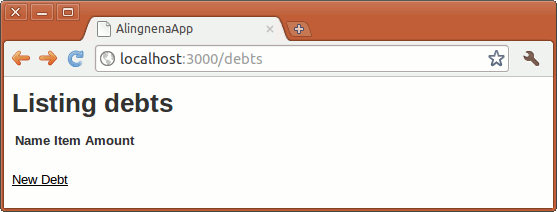
Clicking the New Debt Link will open the New Debt page.
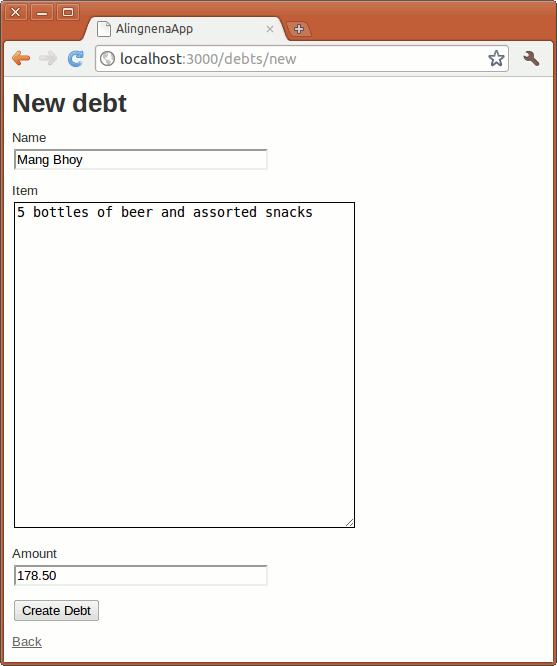
Clicking Create will save the new debt.

Finally, clicking the Back link will return you to the List Debts page. Each existing record has Show, Edit, and Destroy links so that Aling Nena can view, update, and delete the records, respectively.
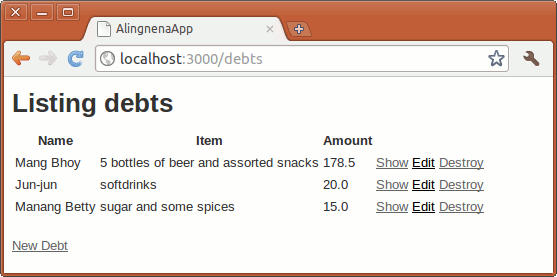
If you’re like Aling Nena, who’s staring speechlessly at the screen amazed at how fast you created the web application, you might be wondering, “That’s it?!?”
Yes, that’s all you need to do to create a working Ruby on Rails application. In the next few sections, we shall discuss what just happened here.
Creating the Application
The first command tells Rails to create the directory structure and the files needed by the application.
$ rails new alingnena-app
In this case, we named our application “alingnena-app” and the following directory structure was created by rails:
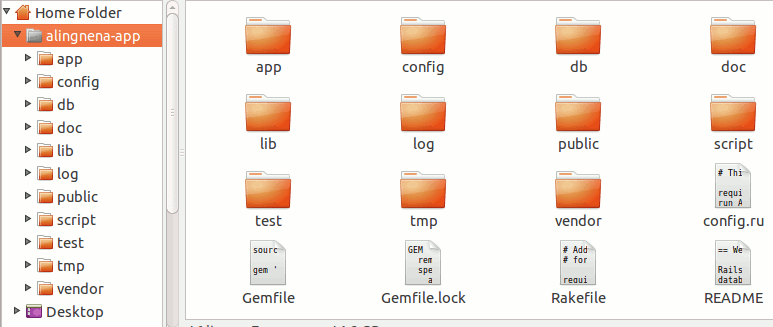
Here’s a brief explanation for each item in the application folder:
| File/Folder | Purpose |
|---|---|
Gemfile |
This file allows you to specify what gem dependencies are needed for your Rails application. |
README |
This is a brief instruction manual for your application. Use it to tell others what your application does, how to set it up, and so on. |
Rakefile |
This file contains batch jobs that can be run from the terminal. |
app/ |
Contains the controllers, models, and views for your application. We’ll focus on this folder throughout the course. |
config/ |
Configure your application’s runtime rules, routes, database, and more. |
config.ru |
Rack configuration for Rack based servers used to start the application. |
db/ |
Shows your current database schema, as well as the database migrations. You’ll learn about migrations shortly. |
doc/ |
In-depth documentation for your application. |
lib/ |
Extended modules for your application. |
log/ |
Application log files. |
public/ |
The only folder seen to the world as-is. This is where your images, JavaScript, stylesheets (CSS), and other static files go. |
script/ |
Scripts provided by Rails to do recurring tasks, such as benchmarking, plugin installation, and starting the console or the web server. |
test/ |
Unit tests, fixtures, and other test apparatus. |
tmp/ |
Temporary files. |
vendor/ |
A place for third-party code. In a typical Rails application, this includes Ruby Gems, the Rails source code (if you install it into your project) and plugins containing additional prepackaged functionality. |
At this point, we can already test if the application is setup properly by skipping the 3rd and 4th commands above i.e.:
$ cd alingnena-app
$ rails server
Opening your browser to http://localhost:3000/ will result in the following screen:
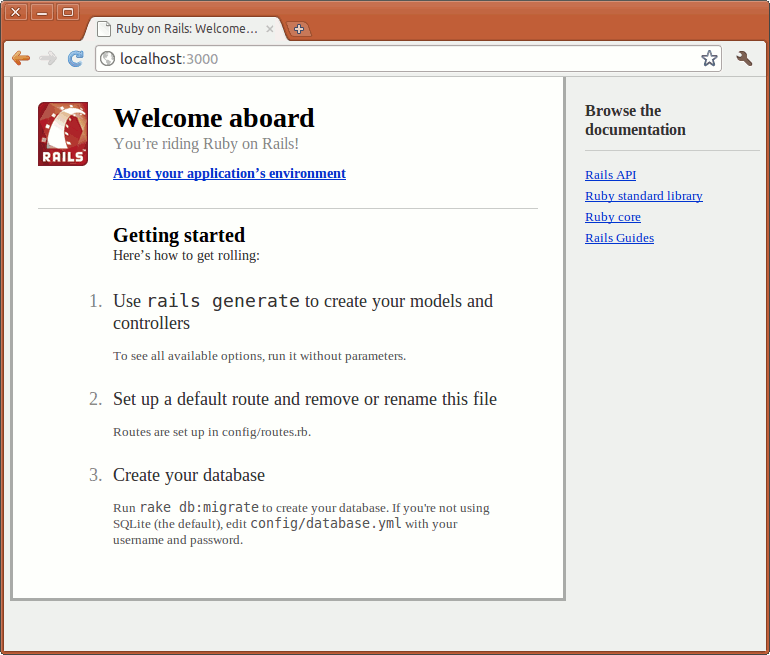
If you’ve read the table above thoroughly (which I bet you didn’t), you’ll realize that http://localhost:3000/ points to the public/ folder. Like many web servers, the default HTML file returned by the server is index.html when you don’t specify the page. You could verify this by manually opening the said file.
Basically that index.html file is the “home page” of the application. Later in this course, we shall discuss how to replace that static web page with a dynamic one.
Generating the Scaffolding
The next command generates everything needed for the debt application: the code for setting up the database tables, the code to handle the user’s actions, the web pages displayed to the user, etc. The command is a bit complicated so let’s dissect the command part-by-part:
$ rails generate scaffold debt name:string item:text amount:decimal
-
rails generate– tells ruby to run the “generate” script -
scaffold– tells the generate script to create a scaffolding. Like its construction counterpart, a scaffold is just a temporary structure where we start building our applications. -
debt– the name of this part of the application. In the next chapter, we shall discuss the concept ofConvention Over Configuration and this is a prime example of that approach. Take note of how Ruby on Rails uses this single word as aconvention throughout the application:- “Debts” will become the name of the resource i.e. the table in the database.
- The model class that will handle the database operations for that resource will be named “Debt.”
- The debt handling application will be accessed via http://localhost/debts.
- “Debts” will be the name of the debt handling application as we shall later see in the Action Controllers.
-
name:string item:text amount:decimal– these define the fields for the Debts table. As you may have guessed, this part tells the script that the table will have a “name” field containing strings, an “item” field containing text (longer than a string), and an “amount” field containing a decimal value. Convention Over Configuration is also active here, by looking at the type of field, the script knows that “name” should use an<input type="text">element in the web page while “item” would use<textarea>.
The command generates the following files:
| File | Purpose |
|---|---|
app/models/debt.rb |
The Debt model. The Model-View-Controller architecture will be discussed in the next chapter. |
db/migrate/2011xxxxxxxxxx_create_debts.rb |
Migration to create the debts table in your database (your name will include a different timestamp). |
app/views/debts/index.html.erb |
A view to display an index of all debts. |
app/views/debts/show.html.erb |
A view to display a single post. |
app/views/debts/new.html.erb |
A view to create a new post. |
app/views/debts/edit.html.erb |
A view to edit an existing post. |
app/views/debts/_form.html.erb |
A partial to control the overall look and feel of the form used in edit and new views. |
public/stylesheets/scaffold.css |
Cascading style sheet to make the scaffolded views look better. |
app/controllers/debts_controller.rb |
The Debts controller. |
test/functional/debts_controller_test.rb |
Functional testing harness for the debts controller. |
app/helpers/debts_helper.rb |
Helper functions to be used from the debts views. |
config/routes.rb |
Edited to include routing information for debts. |
test/fixtures/debts.yml |
Dummy debts for use in testing. |
app/helpers/debts_helper.rb |
Unit testing harness for the debts model. |
test/unit/helpers/debts_helper_test.rb |
Unit testing harness for the debts helper. |
One thing to note here is that generated scaffolding only has one flow:
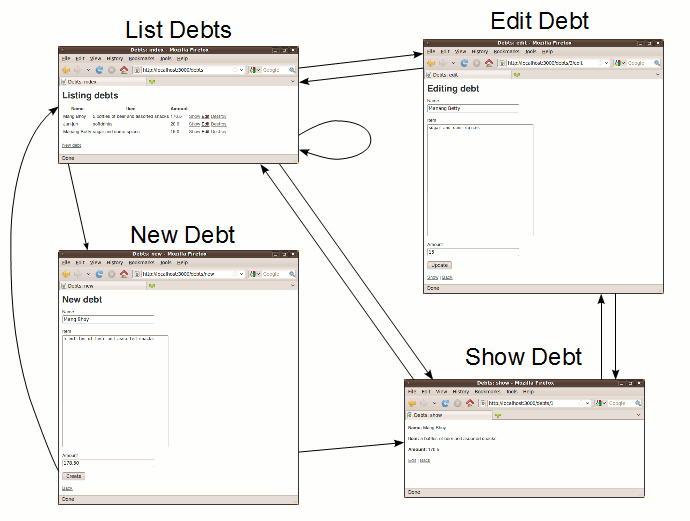
While this might be sufficient for simple applications, this flow is rarely used in typical real world applications. Being a temporary structure, it’s very likely that you will modify the scaffolding to the point that the finished product is very different from where you started. That said, many experienced Ruby on Rails developers avoid scaffolding entirely, preferring to write all or most of their source code from scratch.
Setting Up the Database
The final command deals with setting up the database:
$ rake db:migrate
Database migrations are Ruby classes that are designed to make it simple to create and modify database tables. The rake command above applies all migrations not yet applied to the target database.
In our example, the command above applies the migration that was part of the generated scaffolding, 2011xxxxxxxxxx_create_debts.rb. Let’s take a look at the contents of that file:
class CreateDebts < ActiveRecord::Migration
def self.up
create_table :debts do |t|
t.string :name
t.text :item
t.decimal :amount
t.timestamps
end
end
def self.down
drop_table :debts
end
end
This is an example of a real working Ruby code. You might notice how high-level Ruby code is; even if this is the first Ruby code you’ve seen in your life, it doesn’t take much effort to see that this creates a table named “debt” along with the fields we’ve specified before. This file also defines (“def”) the “down” behavior, namely, to drop the created table (the opposite of the “up” behavior). Later in the course, we shall discuss how to do other things with migrations like modifying tables and rolling back changes.
Frequently Asked Questions
Did Ruby on Rails compile the generated code?
No. Ruby is an interpreted language like JavaScript and so it isn’t compiled. You could even edit your code while the server is running – you would immediately see the changes the next time you access the updated application.
Can I use a different web server aside from the bundled one?
For most cases, the built in web server (WEBrick) is sufficient for development. You can just switch to more full fledged servers like Apache and nginx once you deploy the live version of your application.
However, if you feel WEBrick is somewhat slow and you’re using Linux or OS X, you might want to consider using Unicorn instead. The latter can be installed via:
$ gem install unicorn
Once installed, you can start the server by running unicorn instead of rails server. Note that this will start up the server in port 8080 instead of port 3000.
Some commands start with rails, others with rake. What’s the difference?
- rails – the command used to create an application and run Rails scripts.
- rake – similar to C’s “
make” (rake = Ruby + make), it’s a tool that allows more complicated scripts for tasks like database migration and running unit tests.
Modifying the Application
Aling Nena’s Follow-Up
After being astounded by how fast you build the program, Aling Nena suddenly remembered something.
“Can you add another field where I can put remarks like ‘This was partially paid’ or ‘He promised to pay for it before the end of March’ and so on?”
This is a common sight in software development. Software (being soft) are often subject to changes. Fortunately for us, Rails provides ways to easily handle changes in the requirements.
Looking at this change request, it is clear that we need to do two things:
- update the table in the database to add the new field, and
- update our application to accommodate the new field.
Rails Migrations
As mentioned in the previous chapter, Rails uses migrations to simplify database tasks. Before we move on to how to use migrations to meet our task (i.e. add a new field to the database), let’s discuss why there are migrations in Rails.
In other more traditional software development platforms, when you want to add a new field to the database, you’ll need to write an SQL statement like
ALTER TABLE debts ADD remarks VARCHAR(255);
and give it to someone who is responsible for maintaining the databases in order for it to be applied to all those databases. Now, granted SQL isn’t that hard to learn, and having a DBA managing the database changes can be a somewhat efficient way of handling the data, but there are some reasons why migrations have the upper hand over this approach.
The first benefit of migrations is that it simplifies the whole database management process. Rails includes scripts to apply changes to different databases allowing any developer (or even a batch script) to deploy changes without the need for a database administrator.
Rails migrations also have a limited set of data types which are internally converted to the appropriate data type for different kinds of databases. In other words, unlike with manual SQL wherein you have to take into account the differences between Oracle, MySQL, IBM DB2, etc., you don’t need to worry about these things in migrations.
Another benefit of migrations is that it provides ways to migrate to a certain snapshot of the database structure. As there are timestamps in the file name, anyone can use a command to choose which timestamp to roll back to. This is useful when you’re testing old builds which require an older version of database schema to work. (We will discuss this command in a later chapter.)
Generating the Migration
As migrations have timestamps in their file names, it may not be practical to create them from scratch, with the developer defining the current timestamp in the file name. A better approach would be to use the built in migration generator which creates an empty migration file with a proper timestamp.
The format of the command to generate the migration is:
$ rails generate migration [MigrationName]
MigrationName can be in camel case or lower case separated by underscores (Rails converts the former to the latter in the actual file name, and the latter to the former in the class name). Here is a sample file produced by the command:
class MigrationName < ActiveRecord::Migration
def self.up
end
def self.down
end
end
The generated file, as mentioned above, is empty, and it is up to the developer to define the changes to be applied to the database using migration commands. Migration methods called in self.up will be applied when the migration is executed, while methods in self.down will be called when the migration is reversed or rolled back.
Rails provides a shortcut for creating migrations that add or remove columns from tables. When you name your migrations as Add[ColumnName]To[TableName] or Remove[ColumnName]From[TableName] followed by a series of field_name:data_type pairs, Rails will automatically create the add column or remove column statements, respectively, in the migration. For example, we can perform the required change to our application without having full knowledge of the migration commands:
$ rails generate migration AddRemarksToDebt remarks:text
This command will create the following migration file:
class AddRemarksToDebt < ActiveRecord::Migration
def self.up
add_column :debts, :remarks, :text
end
def self.down
remove_column :debts, :remarks
end
end
Rails supports the following data types:
| Data Type | Description |
|---|---|
| :string | A relatively short string field. |
| :text | An unbounded string field, used for longer text. |
| :integer | A number with no fractional part. |
| :float | A floating point number. May or may not be precise depending on the database. |
| :decimal | A number with a fractional part. Always precise. |
| :datetime | A date and time field. |
| :timestamp | Same as datetime, but with fractional seconds. |
| :time | A time field. |
| :date | A date field. |
| :binary | Field for storing binary data e.g. image files. |
| :boolean | A field that stores either true or false. |
We’ll discuss the other possible migration options in a later chapter. For now, let us just stick with add_column / remove_column.
An Introduction to the Model-View-Controller Architecture
With the database side of the task out of the way, we can now move on to modifying the application itself. But before that, let’s take some time to understand how various components are organized in Rails via the Model-View-Controller (MVC) architecture.
MVC was originally created in the 1980s as a pattern to follow when creating graphical user interfaces in Smalltalk. It found a resurgence in the early 2000s when it became apparent that this model was also applicable for web applications.
In MVC, systems are divided into three parts: the model, the view and the controller. A typical flow through an MVC system would be as follows:
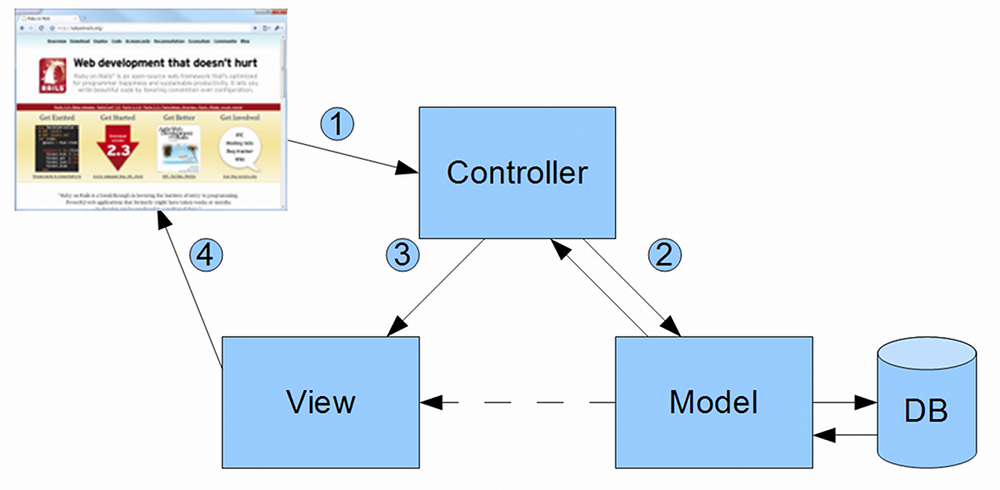
- User (in the form of a browser here) sends a request to the Controller
- Controller interacts with the Model
- Controller invokes the View
- View renders the information sent to the User.
Putting this in context of Rails applications, when a browser visits a Rails web page, it goes through the following steps:
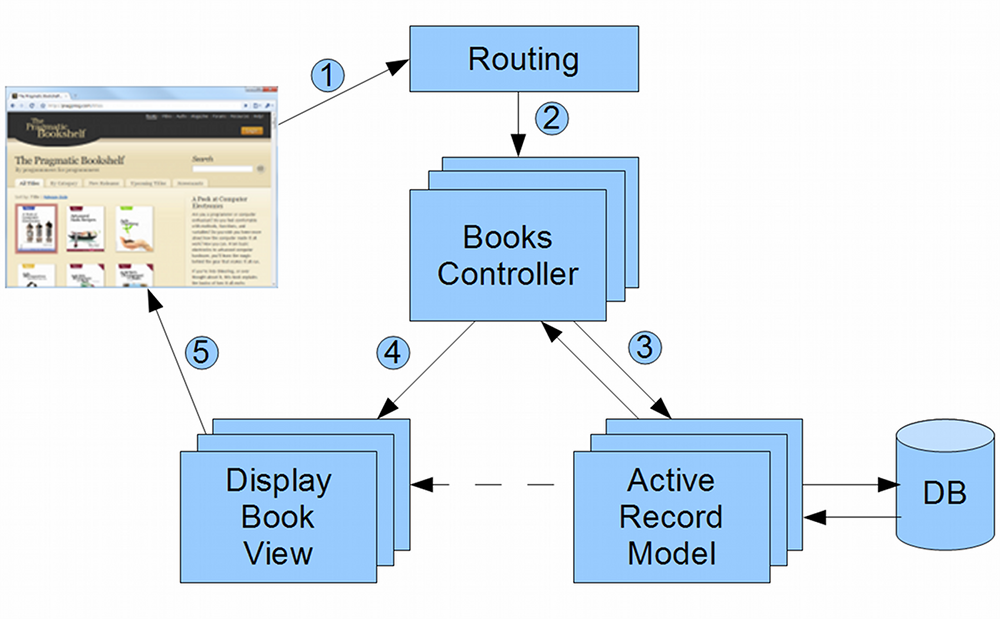
- Browser requests a page from the server e.g. http://my.url/books/123
- Routing finds the Books Controller
- Controller interacts with the Model
- Controller invokes the View
- View renders the page to be sent to the browser
Why use MVC?
In the early days of the web (and even up to now), many web applications were written with all of the processing logic (business processing, routing, rendering) concentrated in a single location. This approach didn’t scale well for some reasons:
- Maintenance was hard. Lack of structure meant that the dependencies between modules aren’t clear. Changing one part of the system might affect another part of the system without a programmer knowing it.
- Debugging was hard. As all of the processing logic were contained in single files, a programmer hunting for the code that caused a bug would have to scan through a lot of code which has nothing to do with the bug itself before finding it.
MVC addresses these problems. First off, the structure provides a degree of isolation between modules. Sure, changing a Model might still affect a lot of programs in the system, but at least the extent of the changes can be easily predicted.
When you encounter a bug in a Rails application, you also have a better idea where to look for the problem. This diagram shows where the source code for the MVC components are located:
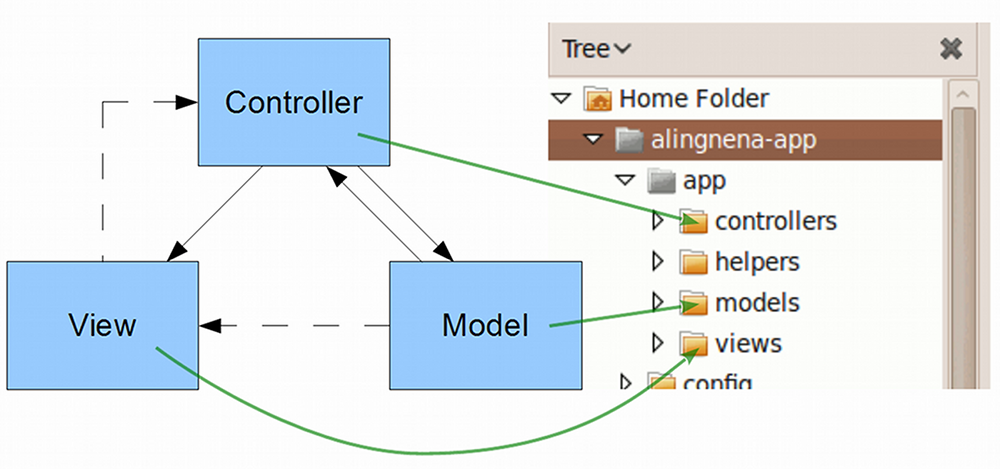
MVC best practices
There are many best practices when it comes to using MVC. We’ll list down a few here, but we’ll also have to use an analogy to make it clearer to someone who hasn’t used MVC before.
Our analogy would be a restaurant analogy.
In a fine dining restaurant, you have your chefs (Models) which prepares the food for the customers (Views). There are also waiters (Controllers) that facilitate communication between the customers and the chefs.
Chefs are expected to do all of the preparing, cooking, and plate presentation on the dishes. Aside from very trivial changes to the dishes (e.g. offering to add pepper to the soup) the waiters do not do anything to the food. Here is the first best practice for MVC: Models should do most of the processing, controllers should only focus on the routing. Similarly: If you find your controllers doing a lot of processing, find a way to move those logic to the model. This is usually called the “fat model, skinny controller” approach.
Some dishes are so complicated that a single chef isn’t enough to handle it. In this case, it’s alright for multiple chefs to work on a single dish without having to go through the waiter. In other words, Related models can communicate with each other before passing their result to the controller.
As for our customers, they should not talk directly to the chef and vice versa i.e. Views should not directly call models directly, and vice versa. However, this does not mean that the customers should be mindless. It’s up to them how to eat their food. In MVC terms, Processing logic is allowed in views, as long as it’s related to the view or presentation.
Now that we understand the basic underpinnings of Rails, we now have a basic idea about what to modify in our system to meet the demands of the current task.
Modifying the Model
…or not.
Veterans of other MVC frameworks might think that we need to modify some model related files to reflect the changes to the database. In some frameworks, we might need to add additional fields to certain classes. In other frameworks, we might need to modify certain XML files to include the new fields.
Fortunately for Ruby on Rails, we don’t need to do any of those.
At the heart of Rails’ model components isActive Record, a Ruby package that handles the database related portion of Rails. Not only does Active Record provide functions for saving and retrieving data, it also provides other features that help simplify database management e.g. migration commands.
To make development easier, Active Record directly checks the database schema to determine the fields of the model. This is made possible thanks to Convention over Configuration (database fields and model fields should be named the same) and Ruby’s dynamic nature (methods can be defined on the fly). In short, there is no need to change any part of the model when the database is changed – the change is automatically applied to the model and we could access theremarks field via @debt.remarks.
Of course, if we would need to add some field validation (e.g. mandatory checking, field length checking), we will need to modify the app/models/debt.rb. We will leave that topic for a later chapter.
Modifying the Controller?
By looking at the flow of the MVC model, you could see that adding a new field to our screen wouldn’t affect our controller: the routing of data is still the same after the change. Therefore, we don’t need to modify debts\_controller.rb.
(By the way, the Ruby package that handles the controller for Rails is ActionController.)
Modifying the View
In the end, the only files we have to modify to include the new field is in the View, namely the four view files for Listing, Show, Create, and Edit.
Insert the highlighted lines into app/views/debts/index.html.erb:
<h1>Listing debts</h1>
<table>
<tr>
<th>Name</th>
<th>Item</th>
<th>Amount</th>
<th>Remarks</th>
</tr>
<% @debts.each do |debt| %> <tr>
<td><%= debt.name %></td>
<td><%= debt.item %></td>
<td><%= debt.amount %></td>
<td><%= debt.remarks %></td>
<td><%= link_to 'Show', debt %></td>
...
Insert the highlighted lines into app/views/debts/show.html.erb:
...
<p>
<b>Amount:</b>
<%= @debt.amount %></p>
<p>
<b>Remarks:</b>
<%= @debt.remarks %></p>
...
And finally, insert the highlighted lines into app/views/debts/\_form.html.erb:
...
<div class="field">
<%= f.label :amount %><br />
<%= f.text_field :amount %> </div>
<div class="field">
<%= f.label :remarks %><br />
<%= f.text_area :remarks %> </div>
<div class="actions">
...
(Just as in the controller, the Ruby package that handles the view for Rails is ActionView.)
Rails Applications Without Scaffold (part 1: Show and List)
Pleased with how you handled the “Debt Records” program, Aling Nena has decided to hire you part time in order to computerize every aspect of her shop.
Part of this job is to create a system to to handle the inventory of her shop’s goods. So for your next task, you need to create a program which maintains the list of products in her shop.
This is a good time to discuss how to create a program from scratch i.e. without using therails generate scaffold script.
The Plan
The Product Maintenance program has 6 different parts:
- User must be able to create a product record
- User must be able to view the product record
- User must be able to view a list of product records
- User must be able to modify a product record
- User must be able to delete a product record
- User must be able to search for a product record
In addition to this, we also need to setup the database for a Products table with the appropriate fields. In the end, we have 7 tasks to be done in the following order:
- Create the migration for Product
- Program the “Show Product” module
- Program the “List Products” module
- Program the “Delete Product” module
- Program the “Search Products” module
- Program the “Create Product” module
- Program the “Edit Product” module
We’ve chosen this order of tasks so that the tasks are done in increasing coding complexity. So without further ado, let’s proceed with the first 2 tasks.
Viewing a Record
First up is the “Show Product” module, a page that displays the details of a certain Product record. We’ve combined this step with the “generate migration” step because we’re going to generate the migration along the way anyway.
The basic flow for showing a single record from the user is as follows:
- User provides the id of the record via the URL
- Program retrieves the record from database
- Program renders the retrieved data into a web page and sends it to the user
In this lesson, we shall see how these steps are coded in Rails.
Generating a Model and adding test data
Instead of usingrails generate scaffold, we shall userails generate model, a script that only generates the migration and the model for the specified model and fields. The syntax of the latter is the same as the former:
$ rails generate model Product name:string description:text cost:decimal stock:integer
We need to modify the generated migration to add some dummy data for our new screen. Add the highlighted lines to the migration file:
class CreateProducts < ActiveRecord::Migration
def self.up
create_table :products do |t|
t.string :name
t.text :description
t.decimal :cost
t.integer :stock
t.timestamps
end
Product.create :name => "test product 1", :description => "test description 1",
:cost => 1.11, :stock => 10
Product.create :name => "test product 2", :description => "<b>test description 2</b>",
:cost => 2.22, :stock => 20
end
def self.down
drop_table :products
end
end
Generating a Controller and View Page Templates
A controller action (not to be confused with Action Controller) is a public instance method inside the controller class that processes requests from the user. We can generate controller actions and their corresponding views with the use of therails generate controller script. The syntax for the script is:
rails generate controller controller_name action [action2 action3 ...]
Given the conventions, here’s the script for generating our controller and view:
$ rails generate controller products show
This script will create the controller app/controllers/products_controller.rb:
class ProductsController < ApplicationController
def show
end
end
and also the view app/views/products/show.html.erb:
<h1>Products#show</h1>
<p>Find me in app/views/products/show.html.erb</p>
You can now test the new controller and view by running the server (rails server) and going to http://localhost:3000/products/show. The following page should be displayed (you may have to restart the server through rails server):
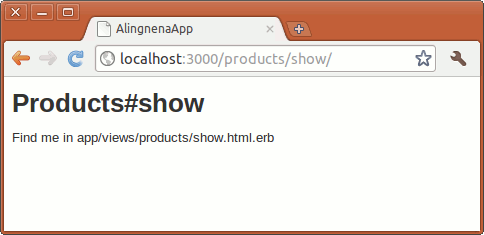
The show action in the controller automatically refers to the show.html.erb file even without additional code as mentioned in the Rails conventions above.
We still have 2 problems at this point:
- We still haven’t displayed the details of the record.
- The format of the URL is different from the convention used by the code generated fromrails generate scaffold i.e.
http://localhost:3000/products/1.
The 2nd problem is simpler and deals with routing so let’s tackle that first.
Routing
Routing deals with how different pages and controllers are linked to each other in a system. In Rails, there is a central configuration file that determines the available routes in the system. At first glance this may look like a violation of the Convention over Configuration mantra, but as we shall see much later, there are ways to let this routing file use convention to reduce the amount of configuration needed.
For this tutorial, we shall do away with the convention-related shortcuts so that you could understand how rails routes pages together. Take a look at the generated config/routes.rb file:
AlingnenaApp::Application.routes.draw do
get "products/show"
resources :debts
# The priority is based upon order of creation:
# first created -> highest priority.
# Sample of regular route:
# match 'products/:id' => 'catalog#view'
# Keep in mind you can assign values other than :controller and :action
# Sample of named route:
# match 'products/:id/purchase' => 'catalog#purchase', :as => :purchase
# This route can be invoked with purchase_url(:id => product.id)
# Sample resource route (maps HTTP verbs to controller actions automatically):
# resources :products
# Sample resource route with options:
# resources :products do
# member do
# get 'short'
# post 'toggle'
# end
#
# collection do
# get 'sold'
# end
# end
# Sample resource route with sub-resources:
# resources :products do
# resources :comments, :sales
# resource :seller
# end
# Sample resource route with more complex sub-resources
# resources :products do
# resources :comments
# resources :sales do
# get 'recent', :on => :collection
# end
# end
# Sample resource route within a namespace:
# namespace :admin do
# # Directs /admin/products/* to Admin::ProductsController
# # (app/controllers/admin/products_controller.rb)
# resources :products
# end
# You can have the root of your site routed with "root"
# just remember to delete public/index.html.
# root :to => "welcome#index"
# See how all your routes lay out with "rake routes"
# This is a legacy wild controller route that's not recommended for RESTful applications.
# Note: This route will make all actions in every controller accessible via GET requests.
# match ':controller(/:action(/:id(.:format)))'
end
It can be a daunting file at first glance, but removing all of the comments, we can see that it’s a pretty simple file:
AlingnenaApp::Application.routes.draw do
get "products/show"
resources :debts
end
Before we proceed with creating our routes, let’s discuss first the idea behind the routing conventions in Rails: REST.
Representational State Transfer (REST)
Representational State Transfer (REST) is a scheme for communicating between clients and servers using HTTP. It was promoted as a stateless means of communication in a 2000 paper by Roy Fielding.
We will not go into detail about REST, and instead, we shall only focus on the parts that are relevant to us in Rails. In that regard, there are two main points about REST that we should know:
- All resources are uniquely identified by a URL. For example, a product record can be identified
with the following URL:
http://my.url/products/1In contrast, an item done in a non-REST framework might look like this
http://my.url/view_product.doIn this case, all product records share the same URL and are differentiated only based on the user’s state, either via session or cookie.
- Actions done on resources are defined by the HTTP verb of the request. Here are some examples:
- GET
http://my.url/products– get (a list of) all products - POST
http://my.url/products– post a new product to the list of products - GET
http://my.url/products/1– get the product with the id of 1 - PUT
http://my.url/products/1– put an updated product with the id of 1 to the database - DELETE
http://my.url/products/1– delete a product with the id of 1
- GET
The 5 HTTP commands in the 2nd point above are, by convention, how resources should be handled in Rails.
Now that we know the convention for the URL (http://localhost:3000/products/1) and the convention for the controller action (method must be namedshow for viewing records), we can now move on to connecting the two in our config/routes.rb.
Configuring Routing in routes.rb
Going back to the diagram in MVC, all browser requests to our Rails server goes to the routing component of the controller first. At this point, Rails checks entries inside the routes.rb file from top to bottom to see which controller and action to call.
We want to add a new “route” to theshow action in theproducts controller and we can do this using thematch declaration inside the routing block. The basic syntax of match is:
match(path_string, options_hash)
When Rails reaches amatch line in the routes.rb file, it first checks the path_string if it matches the request’s URL. The Ruby symbols in the path_string are placeholders and may match any part of the URL. When these symbols are matched to a part of the URL, they are converted into parameters inside aparams hash. (See Ruby Corner – Hash below for a discussion on hashes)
For example, if you removed the commented from the last line in the default resource
match ':controller(/:action(/:id(.:format)))'
and then you called http://localhost:3000/products/show/1, Rails would match this request with the route match ':controller(/:action(/:id(.:format)))' producing the following parameters:
params = { :controller => 'products', :action => 'show', :id => 1 }
Based on this params hash, Rails can now route the request to the controller and action we created earlier.
We don’t need to define the :controller and :action symbols within a route. We can specify them as defaults using the => form of match:
match('products/show' => 'products#show')
In this case, opening http://localhost:3000/products/show will make Rails use the controller and action defined in the right side, in this case, the show action of the products controller.
We can also use the :via option to constrain the request to one or more HTTP methods. For example:
match('products/show' => 'products#show', :via => :get)
Would make the route accessible only via the GET method. Note that the above route has a shorthand version, and it was inserted in our routes.rb when we used the generator script:
get "products/show"
At this point, we can create a route that matches Rails’s conventions on “show record” pages:
AlingnenaApp::Application.routes.draw do
resources :debts
match('products/:id' => 'products#show', :via => :get)
end
Going to http://localhost:3000/products/1 will create the following parameters:
params = { :controller => 'products', :action => 'show', :id => 1 }
As you can see, while the whole URL is matched by the path (‘products/:id’) only the:id part is converted to a parameter. The rest of the parameters for controller and action are provided as defaults at the right of the => symbol.
Testing http://localhost:3000/products/1, we now see the following page:
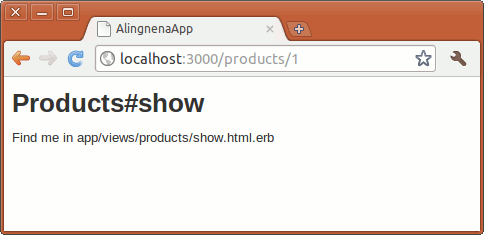
We’ve completed the routing setup. We can now proceed to building the rest of the “Show Record” program.
Putting it all together: Retrieving a Record
To recall, our basic flow for this program is:
- User provides the id of the record via the URL – already done
- Program retrieves the record from database
- Program renders the retrieved data into a web page and sends it to the user
Steps 2 and 3 can be better illustrated by the MVC diagram we had before for Rails:
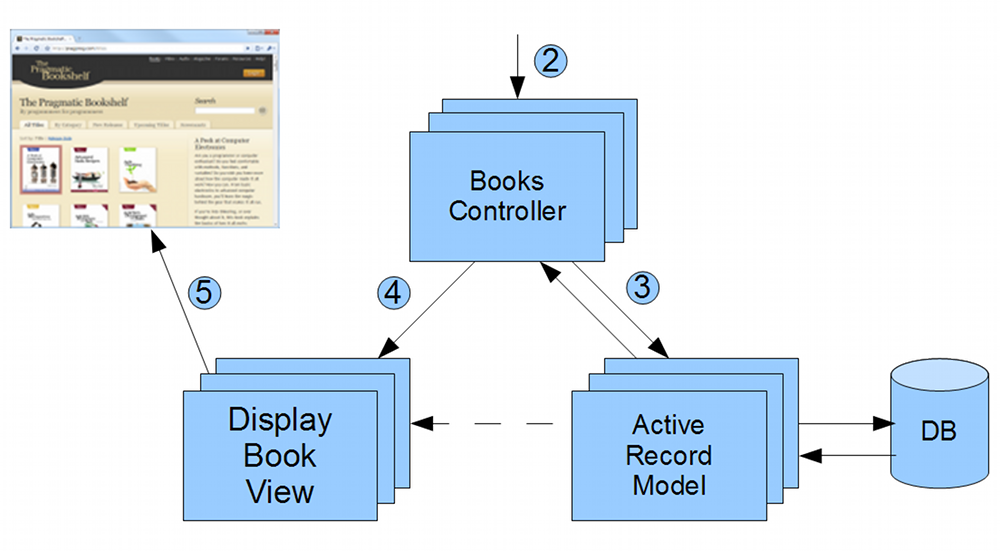
Retrieve Record in the Controller using Model
According to the diagram, retrieving the data has 3 steps:

- After the routing dispatches the request to the controller, the controller calls the model to retrieve the data.
- The model retrieves the data from the database.
- The model sends the data back to the controller.
The first half of the first step has already been done. All requests to 'products/:id' are now dispatched to the Products controller’s show method. All that is left to do is to actually utilize the model to retrieve data from the database. We can do the remaining steps by inserting the following line to theshow method:
class ProductsController < ApplicationController
def show
@product = Product.find(params[:id])
end
end
Retrieving the data is done using the Product.find(id) method, a class method in Active Record that retrieves a record with anid matching the passedid argument. In the statement above, thisid argument is taken from theparams hash passed to the controller via routing.
To pass the data to the controller, we store the result of thefind method to an instance variable of the controller. This instance variable will be passed by the controller to the view in the next part of the process.
Display Model data using View
We only have 2 more steps in the Rails MVC diagram:
- The controller sends the data to the view.
- The view renders the web page based on the data and sends it to the user.
Rails automatically handles the first step: when you pass control over to the view at the end of the action method, Rails gives the view a bunch of variables to work on:
- special variables like the
paramshash are available in the view through accessor methods - all instance variables in the controller are created instance variable counterparts in the view i.e. when you put values in the
@productinstance variable in the controller, you can access it in the view as@product
Now that we know that we can access @product in the view, the contents of our view should be easy to code. Replace the contents of app/views/products/show.html.erb to:
<h1>Show Product</h1>
<p>
<b>Name:</b>
<%= @product.name %></p>
<p>
<b>Description:</b>
<%= @product.description %></p>
<p>
<b>Cost:</b>
<%= number_to_currency(@product.cost, {:unit => 'PhP'}) %></p>
<p>
<b>Stock:</b>
<%= @product.stock %></p>
Opening http://localhost:3000/products/1 will give us the following result:

And with that, our “Show Product” page is now complete.
Adding a List Page
Let’s move on to our List Products page. The approach is similar to the Show Product page, namely, we retrieve the records then render them in the view.
Preparing the New Files
We don’t need to create or modify anything for the view so let’s proceed with the controller.
There’s no script for updating the controller so we have to do the changes by hand. First, let’s apply the first convention above to the controller and view. Insert a new action index to the controller (the order of the actions do not matter):
class ProductsController < ApplicationController
def index
end
def show
@product = Product.find(params[:id])
end
end
Let’s also create a dummy view for the action, app/views/products/index.html.erb:
<h1>Listing Products</h1>
<table>
<tr>
<th>Name</th>
<th>Description</th>
<th>Cost</th>
<th>Stock</th>
</tr>
</table>
For the 2nd convention, we add a new route in config/routes.rb for routing the request to the controller action:
AlingnenaApp::Application.routes.draw do
resources :debts
match 'products' => 'products#index', :via => :get
match 'products/:id' => 'products#show', :via => :get
end
You can now verify the routing by going to http://localhost:3000/products.
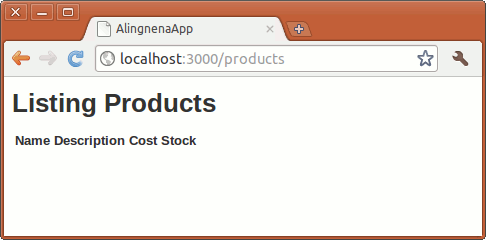
Retrieving All Records
In “show product”, we used the Active Record method find() to find a single record. For “list products”, we shall use all(). Add the following line to the index action:
def index
@products = Product.all
end
Using the all() class method instructs Active Record to retrieve all of records of the model. This variation of the method returns an array of objects instead of a single object.
Displaying the Records
All we need to do now is to display the @products array in the view. This part is slightly complicated so it’s OK to take a peek at how our Debts program handles it.
<% @debts.each do |debt| %> <tr>
<td><%= debt.name %></td>
<td><%= debt.item %></td>
<td><%= debt.amount %></td>
<td><%= debt.remarks %></td>
...
</tr>
<% end %>There are three new concepts in this code snippet alone. Let’s discuss two of them before we proceed with adding the actual code our view.
Now that we are familiar with iteration and scriptlets, we can now code the rest of the app/views/products/index.html.erb file:
<h1>Listing Products</h1>
<table>
<tr>
<th>Name</th>
<th>Description</th>
<th>Cost</th>
<th>Stock</th>
</tr>
<% @products.each do |product| %> <tr>
<td><%= product.name %></td>
<td><%= product.description %></td>
<td><%= number_to_currency product.cost, :unit => 'PhP' %></td>
<td><%= product.stock %></td>
</tr>
<% end %>
</table>
Once coded, we can now go to http://localhost:3000/products to view the “list products” page:
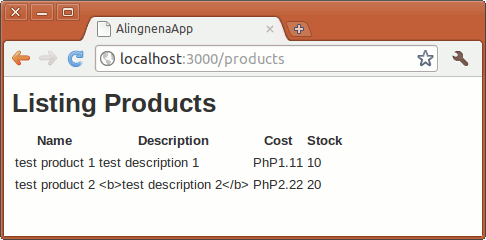
Since we’re done with the “list products” page, we now have time to discuss the third concept introduced in the above code: Ruby Blocks and Procs.
Linking the List Page with the Show Page
Before we proceed with deleting records, let’s add links between the index and show pages together first. It can be annoying to manually type http://localhost:3000/products and http://localhost:3000/products/1 just to go between these two pages.
For this, we can use the link_to helper method. This method returns a link based on the arguments you pass it. The syntax is as follows:
link_to(name, options = {}, html_options_hash = nil)
The name argument is the text used in the link. The options argument can be three different things:
- a string – this will be the URL used by the link. As this is brittle for internal use (paths can be easily changed in the
routes.rb), this is only used for external links. - a hash – the link will be based on both the hash and the
routes.rb. - a non-hash, non-string object – Rails will create a URL based on this object, usually an Active Record. This will be discussed after we finish the entire Product program.
Finally, the html_options_hash is simply a hash of HTML attributes you wish to assign to the link. For example, this link has the CSS class and the id set to “external-link” and “google-search”, respectively:
<%= link_to("Go to Google", "http://www.google.com",
{ :class => "hello world!", :id => "google-search"}) %>The resulting link is:
<a href="http://www.google.com" class="hello world!" id="google-search">Go to Google</a>
If the text is too long, you can use the block form of link_to:
link_to(options = {}, html_options_hash = nil) do
# name
end
To use it, just put the text inside the block:
<%= link_to("http://www.google.com") do %> <strong>This link goes to Google</strong>
<% end %>
Now that we know how to use link_to, let’s link the show and index pages. Insert the following line to index.html.erb:
...
<% @products.each do |product| %> <tr>
<td><%= product.name %></td>
<td><%= product.description %></td>
<td><%= number_to_currency product.cost, :unit => 'PhP' %></td>
<td><%= product.stock %></td>
<td><%= link_to('Show', { :action => 'show', :id => product.id }) %></td>
</tr>
<% end %>
...
And add the following line to the end of show.html.erb:
<%= link_to('Back to List of Products', { :action => 'index' }) %>Named Routes
There are a couple of problems with using an options hash in link_to. The most obvious problem is that it’s too long. Even if the :controller and :action options can be derived from the current page, it’s still too long for practical usage.
Another problem is that it’s brittle. Suppose we have a link scattered around our system, say an approve account link. Initially our link goes to the approve_account action in the users controller so our links were generated using:
<%= link_to 'Approve Account', :controller => 'users', :action => 'approve_account' %>Later, we changed the page that handles the account approval to theapprove action of the accounts controller. We would have to manually search all instances of the approve account link and modify it accordingly.
<%= link_to 'Approve Account', :controller => 'account', :action => 'approve' %>To remedy these two problems, Rails provides a way for us to name routes in theroutes.rb file.
Here’s how you modify our routes for index and show to become named routes:
AlingnenaApp::Application.routes.draw do
resources :debts
match 'products' => 'products#index', :via => :get
match 'products/:id' => 'products#show', :via => :get
match 'products' => 'products#index', :via => :get, :as => 'products'
match 'products/:id' => 'products#show', :via => :get, :as => 'product'
end
By adding an :as option, we tell Rails to provide two new helper functions based on the route:
-
xxxx_path– returns the relative path of the matched route. For example, callingproducts_pathwill return/products -
xxxx_url– returns the complete URL of the matched route. For example, callingproducts_urlwill returnhttp://localhost:3000/products
The path and URL are interchangeable in almost all cases. For this manual, we shall use the xxxx_path methods due to it being used in generator scripts. Here’s the named route version of the link in show.html.erb:
<%= link_to 'Back to List of Products', products_path %>When the path in the route contains placeholder symbols, both methods accept arguments to fill up these placeholders. For example, if we want to generate the URL to a certain product, we can use:
...
<td><%= product.stock %></td>
<td><%= link_to('Show', { :action => 'show', :id => product.id }) %></td>
<td><%= link_to 'Show', product_path(product.id) %></td>
</tr>
<% end %>
...
Rails Applications Without Scaffold (part 2: Delete and Search)
Deleting a Record
Our next task is deleting a record. Deleting is similar to showing a record, the only differences being the HTTP verb involved and that instead of rendering the specified record, we destroy it.
That said, this task has three steps that we need to code:
- Provide a way to call the controller action for deleting a product
- Delete the product record in the controller action
- Display the “list products” page after deleting the product
Creating a DELETE link
We already know how to create a GET link. In this part, we shall discuss how to create a DELETE link.
First off, let’s create a new route for delete based on the conventions:
AlingnenaApp::Application.routes.draw do
resources :debts
match 'products' => 'products#index', :via => :get, :as => 'products'
match 'products/:id' => 'products#show', :via => :get, :as => 'product'
match 'products/:id' => 'products#destroy', :via => :delete
end
Here we see how Rails can differentiate between the HTTP methods. The destroy action will only be used when the HTTP method is DELETE.
With the route set, we can now modify our controller to add our new destroy action.
def destroy
# destroy the specified record
redirect_to products_path
end
The redirect_to method can be used to replace a view. Instead of rendering a view, it tells the user’s browser to redirect to another page, resulting in a fresh new request to the target page. In this case, we redirect the user to the “list products” page after deleting the record.
The parameters for redirect_to is the same as the 2nd parameter for link_to (they use the same helper method, url_for) so you can use string for direct URLs, hash for route based URLs, or objects for shortcuts.
Now that we’ve finished setting up the route and the controller, it’s time to make the actual link. Add the following to app/views/products/show.html.erb:
...
</p>
<%= link_to('Delete this record', @product,
{ :confirm => 'Are you sure?', :method => :delete }) %> <br />
<%= link_to 'Back to List of Products', products_path %>As you can see, this is practically the same as the “Show” link; we only added some new html_options to change the behavior of the link.
link_to has 3 special html_options:
-
:confirm– you can set a confirmation question which will be prompted to the user on click of the link. The link is processed normally if the user accepts. -
:method– this accepts an HTTP verb symbol, either:post,:put, or:delete. With this set, clicking the link will call a JavaScript function which will submit a request to the specified URL with the specified method. If JavaScript is disabled, the link will fall back to GET. -
:popup– This will force the link to open in a popup window. By passingtrue, a default browser window will be opened with the URL. You can also specify an array of options to pass to JavaScript’swindow.openmethod.
By using :confirm and :method, we create a link that both prompts the user if he wants to continue and sends a request using the DELETE method.
Trying this out results in:
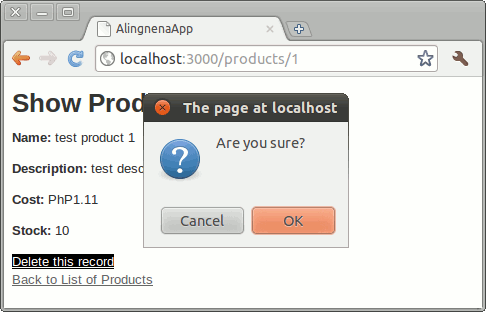
Clicking OK will redirect us to the “list products” screen, confirming that the link and route works.
Deleting the Product
Now it’s time to add the missing lines in our destroy method:
def destroy
@product = Product.find(params[:id])
@product.destroy
redirect_to products_path
end
The first line retrieves the record in from the database. We’ve already seen this in our show method.
The second line deletes the record using the Active Record destroy method. Simple, huh?
Trying this out, we see:
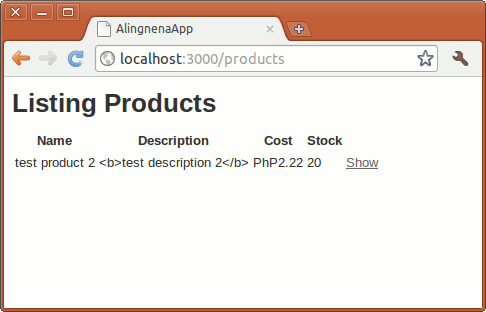
Re-running a Migration
We’re still going to add another feature to our destroy action, but before that, we’re going to have to deal with a certain problem first: running out of test data. We only have two test records so we’re bound to end up with an empty database when we continuously test our destroy action.
Thankfully, there’s a command for re-running a migration:
$ rake db:migrate:redo
This command rolls back the previous migration and runs it again. You can also specify the number of migrations to roll back and re-run by using the STEP environment variable:
$ rake db:migrate:redo STEP=3
Note that re-running a migration will call the self.down method of the migration. This may or may not damage your data, but it’s something to keep in mind.
Displaying a Message using Flash
The missing feature we’re talking about earlier is the lack of confirmation messages. Right now, our program simply deletes the record and redirects the user without telling her if the operation was successful or not.
We use instance variables to pass data from the controller to the view. However, data in the instance variables are only present in the current request. A new request is generated when we useredirect_to so all of our instance variables are cleared. So for messages to be displayed after a redirect, we have to use another controller specific container: the flash hash.
Like the params hash, the flash hash is available for use in both the controller and the view. What’s different is that items put inside the flash hash last until the next request.
Here’s how to modify our destroy action to include a flash message:
def destroy
@product = Product.find(params[:id])
@product.destroy
flash[:notice] = "Product was successfully deleted."
redirect_to products_path
end
Then we add an additional line at the top of app/views/products/index.html.erb to display the message (the scaffold stylesheet already includes #notice):
<p id="notice"><%= flash[:notice] %></p>
<h1>Listing Products</h1>
...
Trying the destroy link now results in:
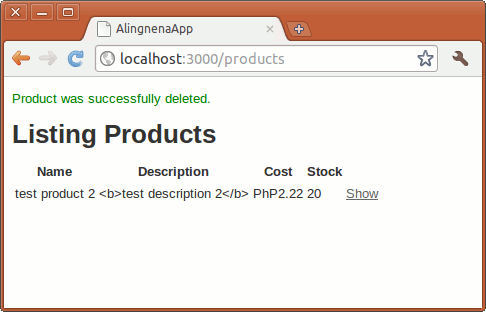
Note that items in the flash hash last until the next request. If you don’t redirect, a message will be present in both the current request and the next request. You can use flash.now instead of flash to set messages that are only available in the current request.
By the way, the most common types of flash messages are :notice (information messages, often in green) and :alert (error messages, often in red). We shall see these two again later.
Adding a Search Screen
Just as deleting records is similar to showing records, filtering records is also similar to listing records.
Here’s the process for searching / filtering product records:
- Submit a query to a search action
- The search action retrieves records based on the query
- Render the retrieved records using the view
In this part, we introduce two new concepts: generating HTML forms in the view, and using an Active Record dynamic finder for searching records. These two concepts deal with step 1 and 2, respectively, while we already know how to do the third step.
Preparation
The choice for the action name is arbitrary so let’s just stick to “search”. With that in mind, let’s modify our controller and view accordingly. Let’s start off with a new route:
AlingnenaApp::Application.routes.draw do
resources :debts
match 'products' => 'products#index', :via => :get, :as => 'products'
match 'products/search' => 'products#search', :via => :get, :as => 'search_products'
match 'products/:id' => 'products#show', :via => :get, :as => 'product'
match 'products/:id' => 'products#destroy', :via => :delete
end
We added a named route “search_products” pointing to our new action so that we could simply use search_products_path in our form later.
Let’s add the search action to app/controllers/products_controller.rb:
def search
@products = Product.all
end
We’re not doing any filtering yet; we’re just copying the approach in the index action. We’ll continue with the index-cloning with app/views/products/search.html.erb:
<table>
<tr>
<th>Name</th>
<th>Description</th>
<th>Cost</th>
<th>Stock</th>
</tr>
<% @products.each do |product| %> <tr>
<td><%= product.name %></td>
<td><%= product.description %></td>
<td><%= number_to_currency product.cost, :unit => 'PhP' %></td>
<td><%= product.stock %></td>
<td><%= link_to 'Show', product_path(product.id) %></td>
</tr>
<% end %></table>
Yes, it’s basically a copy of app/views/products/index.html.erb.
Adding the Search Form to List Products
As web developers, we already know how to tinker with the URL to pass query strings to the server. Our users obviously don’t know how to do that manually so we have to provide a search form for them to use.
Insert the following lines to app/views/products/index.html.erb:
<%= form_tag(search_products_path, {:method => :get} ) do %> <%= label_tag("name", "Search by product name:") %> <%= text_field_tag("name") %> <%= submit_tag("Search") %><% end %>If you view the source of the updated form, you will realize that every helper we used corresponds to an HTML form element.
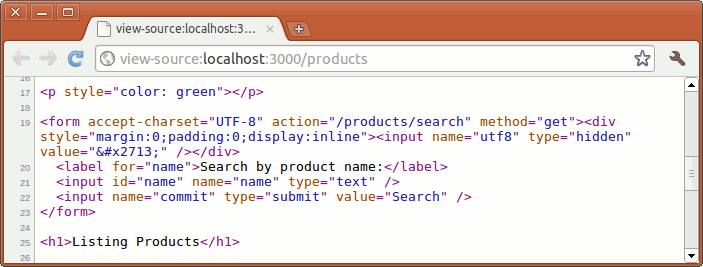
The form_tag helper generates a form element, enclosing everything inside the block inside the form. Its syntax is (note that the tag must be in an expression, not a scriptlet):
<%= form_tag(url_for_options = {}, options = {}, *parameters_for_url) do %> ...
<% end %>The url_for_options are the same as the options used in link_to and redirect_to (the string, hash, or object parameter in case you forgot). Like link_to, the second hash allows you to set HTML attributes for the form along with two additional options: you can set :multipart to true if you want to set the enctype to “multipart/form-data” (useful for submitting files), and you can set the :method to either :get, :put, :post, or :delete (:post is used by default). The parameters_for_url is simply a hash.
Here’s a quick rundown on the other form helpers we used in the search form:
-
label_tag– creates a label. It has 3 parameters:- first parameter sets the for attribute
- second parameter sets the text inside the label. Uses the value of the first argument if not specified.
- third parameter is a hash for setting HTML attributes
-
text_field_tag– creates a standard text field. Also has 3 parameters- first parameter sets the name attribute
- second parameter sets the value of the field
- third parameter is a hash for setting HTML attributes. You can also set additional options: you can set :disabled to true to disable the field, you can also set the :size to set the number of visible characters that will fit in the input, and you can also set the :maxlength which is the maximum number of characters that the browser will allow the user to enter.
-
submit_tag– creates an HTML submit button. It only has two parameters: the first sets the text inside the button (default is “Save changes”) and the second is an options hash for setting HTML attributes. Like withlink_to,form_tagandtext_fieldtag, this parameter has some special options:-
:confirm– behaves the same way as the:confirm in link_to -
:disabled– disables the button if set to true -
:disabled_with– if this is set and the user clicks the button, the button will be disabled and the provided text (e.g. “Please wait…”) will replace the button’s original text while the form is being submitted. Useful for preventing the user from clicking the button twice on submit.
-
We only used one field in our form, the name field. Our plan is for this search module to return all records with a name that matches our submitted name. But enough talk, let’s see our newly coded form in action:
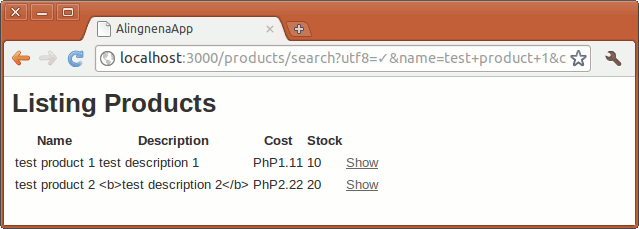
As you can see, the get method puts the query string in the URL. We could verify that the parameters were passed by looking at the web server logs.

With this we know that we could access the search parameter “name” through the params hash entry params[:name].
Filtering Results
So now we have the search parameter available in our controller. Let’s now add the code which will filter the results accordingly. Replace the line in the search action with:
def search
@products = Product.find_all_by_name(params[:name])
end
Here we used a dynamic finder. In addition to providing accessors for each field in the database, Active Record also provides class methods for retrieving filtered for each field. These methods are in the form of:
-
.find_by_xxxx()– returns a record whose fieldxxxxmatches the provided argument. Like.find(), it throws an error if no record is found. (When you think about it,findequivalent tofind_by_id) -
.find_all_by_xxxx()– returns an array of records whose fieldxxxxmatches the provided argument.
Later we shall discuss a more flexible method for filtering, thewhere method.
The search function should work properly at this point. Try using the search form at http://localhost:3000/products to see if it works.
Finishing Touches to the View
Let’s make some minor changes to our search results screen to make it more functional.
<h1>Listing Products</h1>
<p>Displaying Products with name "<%= params[:name] %>"</p>
<table>
<tr>
<th>Name</th>
<th>Description</th>
<th>Cost</th>
<th>Stock</th>
</tr>
<% @products.each do |product| %> <tr>
<td><%= product.name %></td>
<td><%= product.description %></td>
<td><%= number_to_currency product.cost, :unit => 'PhP' %></td>
<td><%= product.stock %></td>
<td><%= link_to 'Show', product %></td>
</tr>
<% end %></table>
<p><%= link_to "Back to original list", products_path %></p>
The first change displays the current search criteria, while the next change links back to the original list, basically resetting the filter.
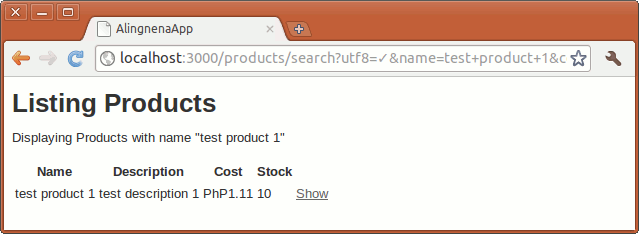
Rails Applications Without Scaffold (part 3: Insert and Update)
Creating a Record
So far we’ve encountered tasks that require one controller action and one view as well as a task that required only one action with no views (delete). For next two tasks, creating and updating a record, we will need two actions and one view:
- one action to prepare the form
- one view to render the form to the user
- one action to process the submitted form. This action will simply redirect in case of success or re-render the view in case of an error.
The flow for creating records is slightly more complicated than the previous functions so let’s just discuss the flow as we go along.
Preparing the New Files
First step is to insert new actions into our controller. The pseudocode below explains the basic flow for this function:
def new
# create a dummy Product
end
def create
# create a Product based on submitted form
# save Product
# if save is successful
# show new Product
# else
# go back to current page and display error
end
Let’s also create a dummy app/views/products/new.html.erb so we could test the routing before we add the processing logic.
<h1>New Product</h1>
<p>form goes here</p>
Here are the new entries for our routes.rb:
AlingnenaApp::Application.routes.draw do
resources :debts
match 'products' => 'products#index', :via => :get, :as => 'products'
match 'products' => 'products#create', :via => :post
match 'products/new' => 'products#new', :via => :get, :as => 'new_product'
match 'products/search' => 'products#search', :via => :get, :as => 'search_products'
match 'products/:id' => 'products#show', :via => :get, :as => 'product'
match 'products/:id' => 'products#destroy', :via => :delete
end
Try out the new screen by going to http://localhost:3000/products/new:
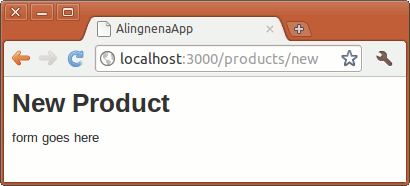
Making the Create Form
Here’s the rest of new.html.erb:
<h1>New Product</h1>
<%= form_for @product do |f| %> <div class="field">
<%= f.label :name %><br />
<%= f.text_field :name %> </div>
<div class="field">
<%= f.label :description %><br />
<%= f.text_area :description %> </div>
<div class="field">
<%= f.label :cost %><br />
<%= f.text_field :cost %> </div>
<div class="field">
<%= f.label :stock %><br />
<%= f.text_field :stock %> </div>
<div class="actions">
<%= f.submit 'Create' %> </div>
<% end %><%= link_to 'Back', products_path %>We’re using a different form helper here; before, we used form_tag in our search screen, while here we used form_for. The former is called a non-model form because it doesn’t use a model. On the other hand, form_for is a model form – it takes a model and uses it to populate the fields inside the form.
The syntax for form_for is as follows:
form_for(record_or_name_or_array, options = {}) do |f|
...
end
The record_or_name_or_array parameter determines the model/s used in the form. As the name implies, it accepts a single or an array of Active Record objects and also accepts a name, a symbol or a string that refers to the instance variable where the Active Record is stored. The options argument can accept two options:
-
:url– the URL where the form is supposed to be submitted to. Normally, the URL is derived from the model in the first argument but we can override that by using this option. The expected value for this option is the same expected values forlink_toandredirect_to, namely, either a string, a hash, or an object (i.e. this option also usesurl_for). -
:html– you can pass a hash of HTML attributes to this option
Inside the block are model form helper counterparts to the non-model form helpers we used in search. There are some noticeable differences, though:
- They use symbols for their first parameter. This signifies that they refer to a specific field in the model provided in the
form_forcall. - They are prefixed by an “
f.”. When the block is called byform_for,form_forpasses an object that refers to the model of the form. When we prefix a form helper with the “f”, we say that the field is a member of the form. We can do away with thefprefix, but doing that would require us to tell the form helpers what model they should refer to. e.g.:1{linenos=off,lang="erb"}2<%=text_field(:products,:name)%>
You may notice that we haven’t initialized the @product instance variable yet. Let’s do just that in the new action:
def new
@product = Product.new
end
Opening http://localhost:3000/products/new will give us a blank form.

Product.new is the constructor of the Product class. We can even define the fields at this point passing a hash of “field name – value” pairs. Try replacing Product.new with Product.new(:name => "dummy name"). You should see the name field in the form populated by “dummy name”.
Saving the New Record
When we click on submit, the contents of the form are submitted and Rails converts the form into a single hash parameter.

This hash is now part of the params hash and can be accessed directly like any hash entry. Here’s a visual representation of params:
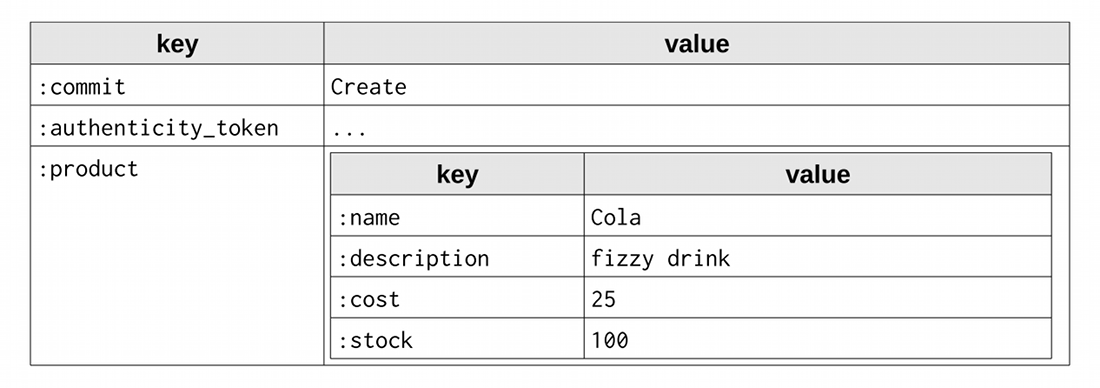
Here we can see that we could access the value “Cola” via params[:product][:name] or the whole product hash via params[:product].
Now the only thing left to do is code the logic that we wrote in pseudocode, namely, to create a record based on the submitted form, save that record, then redirect the user based on the results of the save.
The first part can be done by using Product’s constructor
def create
@product = Product.new(params[:product])
# save Product
# if save is successful
# show new Product
# else
# go back to current page and display error
end
Recall that the constructor accepts a hash and fills out the fields based on that hash. Passing params[:product] (which is a hash) creates a new Product object based on the submitted form.
The saving and redirection can be done via the following code:
def create
@product = Product.new(params[:product])
if @product.save
flash[:notice] = "Product has been successfully created."
redirect_to @product
else
render :action => "new"
end
end
Here we called save, an instance method that saves the record to the database. This method returns true if the record passes validation and false otherwise.
On a successful save in our code, the user is redirected to the “show product” page of the newly created Product record. Try using the new product form now.
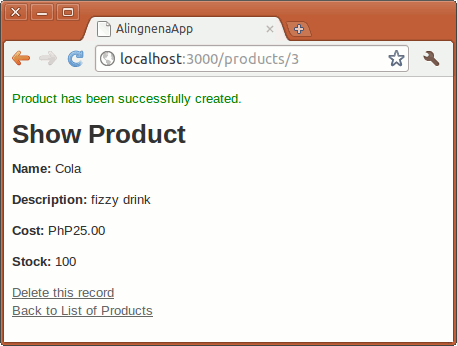
(To display the success notice in the show product page, add the following line from app/views/products/index.html.erb to show.html.erb:)
<p id="notice"><%= flash[:notice] %></p>
If the save fails, it calls the render method to render the view of the new action. By rendering the view of the new action, the user is presented a form that contains the data that he submitted along with the error messages that comes along with it. This is the reason why we initialize the @product variable in the new action instead of initializing it directly at new.html.erb.
Unfortunately, we can’t see this in action because we haven’t set validation rules for Product yet.
Basic Validation
Let’s add some basic validation to our Product model. Add the following line to app/models/product.rb:
class Product < ActiveRecord::Base
validates_presence_of(:name, :description)
end
This method call to validates_presence_of tells Rails to check whether the specified fields are present when the object undergoes validation. In other words, it defines the mandatory fields for the model.
We also add the following lines to new.html.erb to display the error messages:
<h1>New Product</h1>
<%= form_for @product do |f| %> <% if @product.errors.any? %> <div id="error_explanation">
<h2><%= pluralize(@product.errors.count, "error") %> prohibited this product from
being saved:</h2>
<ul>
<% @product.errors.full_messages.each do |msg| %> <li><%= msg %></li>
<% end %> </ul>
</div>
<% end %> <div class="field">
<%= f.label :name %><br />
...
Try submitting a blank new product form now.
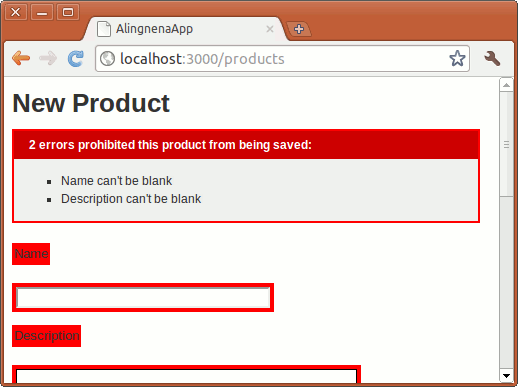
You are redirected to new.html.erb along with messages detailing the errors in your form. As you may have guessed, the error messages at the top are the work of the f.error_messages call.
Before we end this part, add a link to the “new product” page in the “list products” page (i.e. index.html.erb):
...
</table>
<p><%= link_to "Create a new Product", new_product_path %></p>
We’re done with creating new product records and we only have one more function to code.
Editing a Record
Editing a record is not that different from creating a record. We still have two controller actions sharing one single view which contains the form; we just don’t create the record from scratch this time.
Rails Conventions
Here are the conventions for editing records:
- the controller action that prepares the editing form should be named
edit. The view displaying the empty form also follows (edit.html.erb) - the URL to the form should be in the form
/[plural model]/[id]/edit, so in theProductcase, this should be/products/:id/edit. This RESTful URL tells us that we are doing an action to a particular product resource. - the controller action that processes the submitted form should be named
update. - the URL to the form processing action is similar to the one we used in showing and destroying a record
:PUT /products/:id.
Routes and View
Insert the following new entries in routes.rb:
AlingnenaApp::Application.routes.draw do
resources :debts
match 'products' => 'products#index', :via => :get, :as => 'products'
match 'products' => 'products#create', :via => :post
match 'products/new' => 'products#new', :via => :get, :as => 'new_product'
match 'products/search' => 'products#search', :via => :get, :as => 'search_products'
match 'products/:id' => 'products#show', :via => :get, :as => 'product'
match 'products/:id' => 'products#destroy', :via => :delete
match 'products/:id' => 'products#update', :via => :put
match 'products/:id/edit' => 'products#edit', :via => :get, :as => 'edit_product'
end
Create the view file for edit, app/views/products/edit.html.erb:
<h1>Edit Product</h1>
<%= form_for @product do |f| %> <% if @product.errors.any? %> <div id="error_explanation">
<h2><%= pluralize @product.errors.count, "error" %> prohibited this product from
being saved:</h2>
<ul>
<% @product.errors.full_messages.each do |msg| %> <li><%= msg %></li>
<% end %> </ul>
</div>
<% end %> <div class="field">
<%= f.label :name %><br />
<%= f.text_field :name %> </div>
<div class="field">
<%= f.label :description %><br />
<%= f.text_area :description %> </div>
<div class="field">
<%= f.label :cost %><br />
<%= f.text_field :cost %> </p>
<div class="field">
<%= f.label :stock %><br />
<%= f.text_field :stock %> </div>
<div class="actions">
<%= f.submit 'Update' %> </div>
<% end %><%= link_to 'Show', @product %> |
<%= link_to 'Back', products_path %>We did not need to change the declaration for form_for, it already checks the model and determines which route to use based on conventions. If the model is new (i.e. create), it will use the products_path. Otherwise (i.e. update), it will use product_path.
For convenience, add the following links to show.html.erb
...
</p>
<%= link_to 'Edit this record', edit_product_path(@product) %> <br />
<%= link_to 'Delete this record', @product,
:confirm => 'Are you sure?', :method => :delete %> <br />
<%= link_to 'Back to List of Products', products_path %>and index.html.erb
...
<% @products.each do |product| %> <tr>
<td><%= product.name %></td>
<td><%= product.description %></td>
<td><%= number_to_currency product.cost, :unit => 'PhP' %></td>
<td><%= product.stock %></td>
<td><%= link_to 'Show', product_path(product.id) %></td>
<td><%= link_to 'Edit', edit_product_path(product) %></td>
</tr>
<% end %>...
New Controller Actions
Add the following actions to app/controllers/products_controller.rb:
def edit
@product = Product.find(params[:id])
end
def update
@product = Product.find(params[:id])
if @product.update_attributes(params[:product])
redirect_to @product, :notice => 'Product was successfully updated.'
else
render :action => "edit"
end
end
Since we’re already familiar with how records are created, this code should be easy to understand. Instead of creating records with Product.new, we use Product.find to retrieve the record from the database. The @product.update_attributes() method is similar to save; it first updates the fields based on the hash then validates and saves the object.
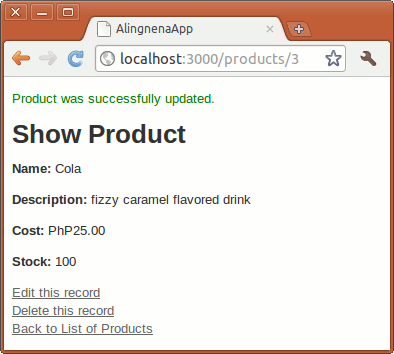
And that’s it; we finally created a full table maintenance program without using rails generate scaffold. We also learned almost everything that goes on behind the scaffold generated code.
There are still a bunch of things we add to our maintenance program. We’ll spend the next chapter on those things in order to get them out of the way before the next lesson.
Rails Applications Without Scaffold (part 4: RESTFul Routes, Callbacks, Filters, and Layout)
In this chapter, we will be discussing new Rails features from the Model, Controller, and the View that can make our Product maintenance program better.
Reduce Route Entries with Resource-Based Routing
Creating a new route entry for typical routes sort of defeats the purpose of following Convention over Configuration. Fortunately, most of the routing in this program was only done for educational purposes; there is a shortcut for telling Rails that a certain resource follows the REST conventions.
AlingnenaApp::Application.routes.draw do
resources :debts
match 'products/search' => 'products#search', :via => :get, :as => 'search_products'
resources :products
end
Using resources :products adds the following routes and helpers to the system:
| helper | HTTP verb | URL | controller | action | use |
|---|---|---|---|---|---|
products_url, products_path
|
GET | /products |
Products |
index |
Display a list of all products |
new_product_url, new_product_path
|
GET | /products/new |
Products |
new |
Return a form for creating a new product |
| POST | /products |
Products |
create |
Create a new product | |
product_url, product_path
|
GET | /products/:id |
Products |
show |
Display a product |
edit_product_url, edit_product_path
|
GET | /products/:id/edit |
Products |
edit |
Return a form for editing a product |
| PUT | /products/:id |
Products |
update |
Update a product | |
| DELETE | /products/:id |
Products |
destroy |
Delete a product |
You can define other routes under the resource by using the collection and member blocks. Use collection for routes that affect the entire collection. In our case, we can set the products search as a collection route:
AlingnenaApp::Application.routes.draw do
resources :debts
match 'products/search' => 'products#search', :via => :get, :as => 'search_products'
resources :products do
collection do
get 'search'
end
end
end
Doing this will also create search_products_xxxx route helpers (we manually set that named route before).
For actions that only affect one resource, use the member option. For example, if we want to add a “suspend” action for suspending a specific product (i.e. PUT /products/:id/suspend), we can use:
AlingnenaApp::Application.routes.draw do
resources :debts
resources :products do
collection do
get 'search'
end
member do
put 'suspend'
end
end
end
The other options for resource-based routing will be discussed in a later chapter.
Perform Actions While A Model is Saved using Callbacks
Aling Nena has dozens, if not hundreds, of different products in stock. If she would encode all of them, she might not have time to enter detailed descriptions for each item. To help her in this task, we could just set the description to be the same as the product’s name every time she doesn’t enter a description.
At first glance, the solution to this problem would be in the controller, say, something like this:
def create
@product = Product.new(params[:product])
if @product.description.blank?
@product.description = @product.name
end
...
However, if you would recall our discussion in MVC, most of the business logic must be placed inside the model instead of the controller. So how do we set the description without changing the controller?
For this, we need to understand how to use callbacks.
Callbacks
Callbacks are methods called by an Active Record object before and after the object is inserted, updated, or deleted from the database. Here is the list of callbacks performed in each of these operations:
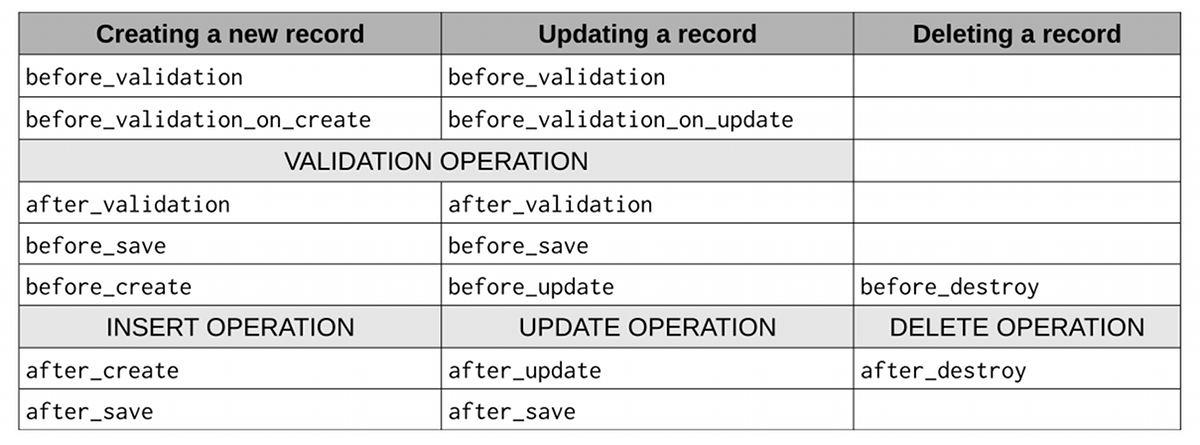
Based on this table, the before_validation callback is called before the validation of both record creation and update. After that, the before_validation_on_create and before_validation_on_update are called in creation and update, respectively.
Registering Callbacks
Registering callbacks is similar to setting validations. Instead of providing fields, however, we provide symbols referring to method names.
class Product < ActiveRecord::Base
validates_presence_of :name, :description
before_validation :assign_default_description
private
def assign_default_description
if description.blank?
self.description = name
end
end
end
Here we set the description field of the record before the record is validated (thus preventing an error in description validation).
Note that we set the callback method to be private. This prevents the method from being called outside the object. Another thing to note is the use of self to denote that we are modifying the instance attribute; if we didn’t use self.description, Ruby will think we are simply setting a local variable description.
Limiting User Access with Filters and Authentication
Aling Nena wants her customers to see the list of available products in her store. However, she doesn’t want them to create and edit the products, or worse, delete the products. In short, she wants to add an authentication mechanism in her site.
Controller Filters
Authentication is like validation; we want to validate whether the user has permission to do something in our application. Unlike validation, it is not done in the Model level but in the Controller level, with the help of the controller filters.
Controller filters are more like callbacks than validations. They are methods that we define to be executed before actions (using before_filter) or after actions (using after_filter). The syntax is also similar:
# app/controllers/products_controller.rb
class ProductsController < ApplicationController
before_filter :check_if_aling_nena
...
private
def check_if_aling_nena
#checking here
end
end
In this case, the method check_if_aling_nena is called before every action in the Products controller. If we want to limit the actions where the filter is applied, we can use the :only option.
before_filter :check_if_aling_nena, :only => [:new, :create, :edit, :update, :destroy]
It might make sense to use the :except option here, though.
before_filter :check_if_aling_nena, :except => [:index, :show, :search]
One important thing about before_filter methods is that the processing will not continue to the action if the method renders or redirects. Here’s one way to test our new filter, by kicking everyone back to the list products page regardless of who they are:
def check_if_aling_nena
redirect_to products_path, :notice => "You must be Aling Nena to access this page."
end
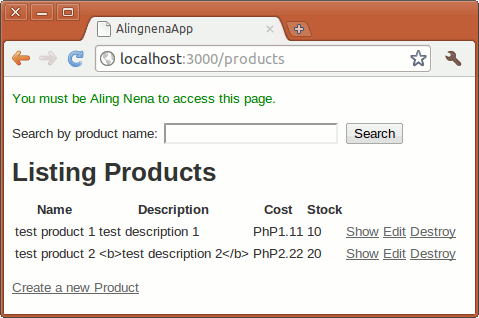
(You may want to change that flash message to :alert, just don’t forget to add the code to index that would display the message.)
HTTP Authentication
Having verified that the filter works, let’s now add the authentication.
Rails has built in methods that make applying basic HTTP authentication easy. Here’s the code to apply that authentication to our Product maintenance program (you can change the username and password as you like):
def check_if_aling_nena
authenticate_or_request_with_http_basic("Products Realm") do |username, password|
username == "admin" and password == "sTr0NG_p4$swOrD"
end
end
You should see browser-specific pop-up prompting you for credentials:

Entering the credentials will let you proceed to the pages. Since HTTP authentication is supported by all browsers, the server knows if you already provided your credentials so you don’t have to re-enter it again when you enter the other actions in the program.
Pressing Cancel will redirect you to an error page:
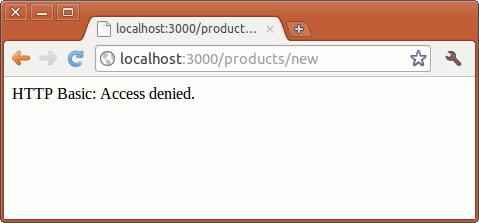
HTTP Authentication is the most basic of all authentications available to Rails. For larger applications with many users, you’re better off with full-fledged authentication solutions like the Authlogic or Devise gems.
Layouts and Rendering in the View
Asset Tags
Static files in our web application are stored in the public folder. Since this folder is mapped directly to the application root, going to http://locahost:3000/ will open public/index.html.
By convention, stylesheets, images, and JavaScript files are stored in the public/stylesheets, public/images, and public/javascripts folder, respectively. Rails provides view helpers called asset tags for linking to these files.
We can use stylesheet_link_tag to link to CSS files under the public/stylesheets folder. The syntax is as follows:
stylesheet_link_tag( *sources, options = {} )
You can pass one or more stylesheets to the method:
<%= stylesheet_link_tag("main") %><%= stylesheet_link_tag("sidebar", "admin") %>The code above creates the following links:
<link href="/stylesheets/main.css" media="screen" rel="stylesheet" type="text/css" />
<link href="/stylesheets/sidebar.css" media="screen" rel="stylesheet" type="text/css" />
<link href="/stylesheets/admin.css" media="screen" rel="stylesheet" type="text/css" />
You can also use relative paths:
<%= stylesheet_link_tag("red/main") %><link href="/stylesheets/red/main.css" media="screen" rel="stylesheet" type="text/css" />
You can also use absolute or external paths:
<%= stylesheet_link_tag("http://example.com/main") %><link href="http://example.com/main.css" media="screen" rel="stylesheet" type="text/css" />
The :all option creates links to all of the CSS files under public/stylesheets. Adding a :recursive => true option creates links for all CSS files in all subfolders of public/stylesheets.
<%= stylesheet_link_tag(:all) %><%= stylesheet_link_tag(:all, {:recursive => true}) %>You can also override the link attributes by adding them as options. For example, you can change the media from screen to print using the following:
<%= stylesheet_link_tag("main", { :media => "print"}) %>The asset tag for JavaScript is javascript_include_tag and it behaves the same way as the stylesheet_link_tag:
<%= javascript_include_tag(main) %>=> <script type="text/javascript" src="/public/javascripts/main.js"></script>
The :all and :recursive option also work with javascript_include_tag.
For images, the asset tag is image_tag. The basic use is similar to the two previous asset tags. By default it appends .png to the file name if the extension isn’t specified.
<%= image_tag "banner" %>=> <img src="/public/images/banner.png" />
<%= image_tag "profile.jpg" %>=> <img src="/public/images/profile.jpg" />
In addition to the HTML attributes that you can set in the options hash parameter, image_tag has the following special options:
-
:alt– If no alt text is given, the file name part of the source is used (capitalized and without the extension) -
:size– Supplied as “{Width}x{Height}”, so “30x45” becomes width=”30” and height=”45”.:sizewill be ignored if the value is not in the correct format. -
:mouseover– Set an alternate image to be used when theonmouseoverevent is fired, and sets the original image to be replacedonmouseout. This can be used to implement an easy image toggle that fires ononmouseover.
Layouts
We now know how to link to CSS files in our pages but having to add <%= stylesheet_link_tag "scaffold" %> (the CSS used in Debts) to all of our pages can be a hassle, not to mention that it violates the DRY (Don’t Repeat Yourself) principle that we’ve been following as we applied Convention over Configuration to our program. There must be a way for us to apply HTML code to all of our pages.
Thankfully, Rails already provides a way to do that through layouts.
Layouts, as you may have guessed, provide the general layout for our views. Rails combines the view and the layout when rendering the page to the user. An example of a layout is the default layout generated when we created our application, app/views/layouts/application.html.erb:
<!DOCTYPE html>
<html>
<head>
<title>AlingnenaApp</title>
<%= stylesheet_link_tag :all %> <%= javascript_include_tag :defaults %> <%= csrf_meta_tag %></head>
<body>
<%= yield %></body>
</html>
The yield section defines where the view will be inserted upon rendering. You can also use multiple yielding regions:
<html>
<head>
<%= yield :head %> </head>
<body>
<%= yield %> </body>
</html>
To render content in a named yield, you use the content_for method:
<% content_for :head do %> <title>A simple page</title>
<% end %><p>Hello, Rails!</p>
This would result in:
<html>
<head>
<title>A simple page</title>
</head>
<body>
<p>Hello, Rails!</p>
</body>
</html>
By default, Rails checks the app/views/layouts directory for a layout that matches the name of the controller. If the layout isn’t found, Rails will try app/views/layouts/application.html.erb.
There are two other ways to define layouts. First is through the controller:
class ProductsController < ApplicationController
before_filter :check_if_aling_nena, :except => [:index, :show, :search]
layout "main"
...
This will apply app/views/layouts/main.html.erb to all actions in Products.
Layouts are shared downwards in the hierarchy, so applying
class ApplicationController < ActionController::Base
protect_from_forgery
layout "main"
...
will set the layout of every controller to app/views/layouts/main.html.erb because all controllers (at least the ones generated by rails generate controller and scaffold) are subclasses of `ApplicationController.
Another way of setting the layout is through the render method. Before, the only option we discussed for render is :action, so now we introduce a new option, :layout, which lets you define the layout of a rendered view:
render :layout => "main", :action => "new"
You can also remove a layout by setting it to `false. For example:
render :layout => false, :action => "new"
When multiple layouts are applied to a view, more specific layouts always override more general ones. For example:
class ProductsController < ApplicationController
layout "main"
def show
@product = Product.find(params[:id])
render :layout => false
end
...
No layout is rendered for the show action above. (Recall that the :action option is automatically set by Rails according to the action name if it’s not defined.)
Partial Templates
When you look at app/views/products/new.html.erb and app/views/products/edit.html.erb, you will notice that both share almost the same code for the form. We can eliminate this redundancy by using partial templates, better known as partials.
Partials are fragments of pages that can be called by other pages. We use the render method to tell rails to render a partial inside a view. For example, if we call the following inside app/views/products/new.html.erb:
<%= render({:partial =>'form'})%>The call will insert the contents of app/views/products/_form.html.erb at that line inside the view.
We can use the :locals option to pass local variables to the partial. For example, we can eliminate the redundancy between new and edit by modifying the views:
<h1>New Product</h1>
<%= render({:partial => "form",
:locals => { :product => @product, :button_label => "Create" } }) %>
<%= link_to 'Back', products_path %><h1>Edit Product</h1>
<%= render({:partial => "form",
:locals => { :product => @product, :button_label => "Update" } }) %>
<%= link_to 'Show Details', @product %> |
<%= link_to 'Back to List', products_path %>
and creating a new partial app/views/products/_form.html.erb:
<%= form_for product do |f| %> <% if product.errors.any? %> <div id="error_explanation">
<h2><%= pluralize product.errors.count, "error" %> prohibited this product from
being saved:</h2>
<ul>
<% product.errors.full_messages.each do |msg| %> <li><%= msg %></li>
<% end %> </ul>
</div>
<% end %> <div class="field">
<%= f.label :name %><br />
<%= f.text_field :name %> </div>
<div class="field">
<%= f.label :description %><br />
<%= f.text_area :description %> </div>
<div class="field">
<%= f.label :cost %><br />
<%= f.text_field :cost %> </div>
<div class="field">
<%= f.label :stock %><br />
<%= f.text_field :stock %> </div>
<div class="actions">
<%= f.submit button_label %> </div>
<% end %>In this case, the product local variable was derived from the @product instance variables, while the button_label was supplied in the hash.
All partials have a local variable with the same name as the partial and you can pass an object to this by using the :object option. In other words, suppose we make a copy of the _form partial at _product_form.html.erb, and we replace the first line with:
<%= form_for product_form do |f| %>We would be able to do this in edit.html.erb:
<%= render({:partial => "product_form",
:object => @product,
:locals => { :button_label => "Update" } }) %>The instance variable is placed inside the product_form variable.
We can also use partials to render a collection of objects using the :collection option. For instance, we can replace the iteration inside app/views/products/index.html.erb with the following:
...
<tr>
<th>Name</th>
<th>Description</th>
<th>Cost</th>
<th>Stock</th>
</tr>
<%= render({ :partial => "item", :collection => @products }) %></table>
...
And create a new partial, _item.html.erb:
<tr>
<td><%= item.name %></td>
<td><%= item.description %></td>
<td><%= number_to_currency item.cost, :unit => 'PhP' %></td>
<td><%= item.stock %></td>
<td><%= link_to 'Show', product_path(item.id) %></td>
<td><%= link_to 'Edit', edit_product_path(item) %></td>
</tr>
The page would still display as it was originally displayed. Each item in the array is placed in a local variable that shares the same name as the partial. In this case, the partial and variable name is item.
We can even define a spacer template for the collection:
<%= render({ :partial => "item", :collection => @products, :spacer_template => "hr" }) %>Here’s a sample _hr.html.erb:
<tr><td colspan="7"><hr /></td></tr>
There is also a shorthand for partials. Assuming @product a single Product object the following code:
<%= render({ :partial => @product }) %>will render _product.html.erb and pass @product as the value of the local variable product. Similarly, assuming @products is a collection of Product objects, the following code:
<%= render({ :partial => @products }) %>will render the partial _product.html.erb for each Product object inside the collection, passing the object to the local variable product.
Using a collection with different object types can produce polymorphic results. For example, if employee1 and employee2 are Employee objects, while customer1 and customer2 are Customer objects, the following call:
<%= render({ :partial => [customer1, employee1, customer2, employee2] }) %>will call the following partials, either _customer.html.erb
<p>Name: <%= customer.name %></p>
or _employee.html.erb:
<p>Name: <%= employee.name %></p>
Associations
When you’re working with RDBMSs, you’re bound to encounter cases where you have to handle relationships between tables. One-to-many relationships are common, though you might see many-to-many and one-to-one relationships from time to time.
Does Rails support these relationships?
No and yes.
Rails does not support the various relationship implementations between database vendors. You will have to tweak your migrations to call specific DDL commands in order to set them up (this is outside the scope of this training course).
Rails, however, has its own database-agnostic way of handling entity relationships. In this chapter, we will discuss how to these various relationships are coded in Rails.
Migrations for Associations
If you would recall in our previous lesson, by default all tables in a Rails application use “id”, an auto-incrementing integer field, as their primary key. In the context of associations, Rails uses this convention to link tables in a system.
When generating the migration for a foreign key reference field, you can specify the field normally e.g.
$ rails generate migration Employee name:string department_id:integer
Or you can make the abstraction clearer by using the :references data type:
$ rails generate migration Employee name:string department:references
This migration will still generate the same field as the previous migration. Note the lack of _id in the :references argument.
Defining Associations in Models
Had you used rails generate scaffold or rails generate model instead of migration, you will notice that the model generated has a belongs_to call:
class Employee < ActiveRecord::Base
belongs_to :department
end
Again, another human-readable declaration in Rails: it simply tells Active Record that each Employee record belongs to a Department record.
belongs_to
For every belongs_to call inside the model, Active Record generates some instance methods for the class. In the Employee-Department case, these methods are
-
employee.department– returns the Department object associated to the Employee. This is cached so if you want to reload the list, just passtrue to the method. Can also be used to assign a Department to the Employee e.g.employee.department = some_department -
employee.build_department(attribute_hash)– basically a shorthand foremployee.department = Department.new(attribute_hash). Also returns the newly created Department. -
employee.create_department(attribute_hash)– same asbuild_department, the only difference is the new object is saved (assuming it passes validations, of course).
Even with these methods, using the department_id for defining associations is still valid. The following will work:
department = Department.find_by_name("Accounting")
employee.department_id = department.id
but it’s still better to use an approach with a clearer abstraction:
employee.department = Department.find_by_name("Accounting")
not to mention coding the build_xxxx and create_xxxx methods manually will take at least 2 more lines of code than just calling those methods.
One-to-One Relationships
With the belong_to declaration in one model, we can define the nature of the association in the target table. Let’s start with the one-to-one association.
For this tutorial, we’re going to expand Aling Nena’s system by adding a Purchase entity whose records refer to a single purchase of items from a supplier. We’re going to have an Invoice record for each Purchase, and this one-to-one relationship will be the basis of this tutorial.
First, let’s setup the Purchase and Invoice entities with scaffold scripts:
$ rails generate scaffold purchase description:text delivered_at:date
$ rails generate scaffold invoice purchase:references reference_number:string
$ rake db:migrate
This should make working maintenance programs for each entity. When you look at the new and edit views of the Invoice program, however, you will see that it uses a text_field for the purchase. This is inappropriate: not only does it force the user to know the Purchase while editing the field, it also won’t work because the data types don’t match (text_field is String, while the purchase field requires a Purchase).
Drop Down List
A better approach would be to provide a drop-down field containing a list of available Purchases. The form helper for drop-down lists is collection_select
collection_select(object, field_name, collection, value_method, text_method, options = {},
html_options = {})
# or the form_for shortcut
f.collection_select(field_name, collection, value_method, text_method, options = {},
html_options = {})
The object, field_name, and options field are just the same as in our basic input field text_field, with the options separated from the html_options.
The collection is a list of items where the value and the text are derived from, while the value_method and text_method determines the names of the methods to call for the value and text. For example, we have the following list of Purchases:
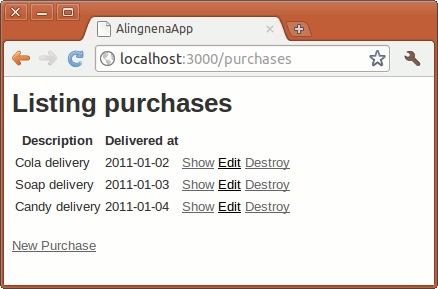
Replacing the purchase field in app/views/invoices/_form.html.erb to
...
</div>
<% end %> <div class="field">
<%= f.label :purchase %><br />
<%= f.text_field :purchase %> <%= f.label :purchase_id, "Purchase" %><br />
<%= f.collection_select :purchase_id, Purchase.all, :id, :description %> </div>
<div class="field">
<%= f.label :reference_number %><br />
<%= f.text_field :reference_number %> </div>
...
will result in the following HTML code:
...
<div class="field">
<label for="invoice_purchase_id">Purchase</label><br />
<select id="invoice_purchase_id" name="invoice[purchase_id]">
<option value="1">Cola delivery</option>
<option value="2">Soap delivery</option>
<option value="3">Candy delivery</option>
</select>
</div>
...
There are three available options in collection_select:
-
:include_blank– adds a blank entry at the top of the list. Can be the text of the entry (e.g. “none”) ortrue(which will just put a blank entry). -
:prompt– just likeinclude_blank, but has a different purpose: to prompt the user to select one item in the list. When set totrue, the text used is “Please select”. Setting this option will not add validation for checking if the user chose a value from the list. Setting this option along with:include_blankwill add 2 blank list entries in the list, one for each call with the prompt on top. -
:disabled– contains a list of items fromcollectionthat should be disabled from the list. In the case ofcollection_select, we can use a Proc to determine which should be disabled. For example, to disable all Purchases that would be delivered in the future, we can set:
<%= f.collection_select :purchase_id, Purchase.all, :id, :description, :prompt => true,
:disabled => lambda { |purchase| purchase.delivered_at > Date.today } %>Custom Helpers
After creating the Invoice for the “Cola delivery”, we see a problem in the Show Invoice page:
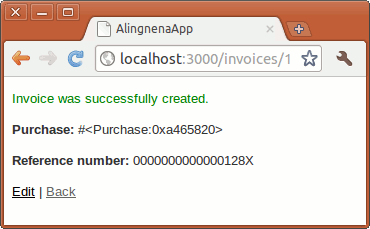
What is displayed is the internal representation of the Purchase object. Sure, we can remedy this by replacing the code with:
<p>
<b>Purchase:</b>
<%= @invoice.purchase %> <%= @invoice.purchase.description %></p>
But what if we had created an Invoice without a Purchase?
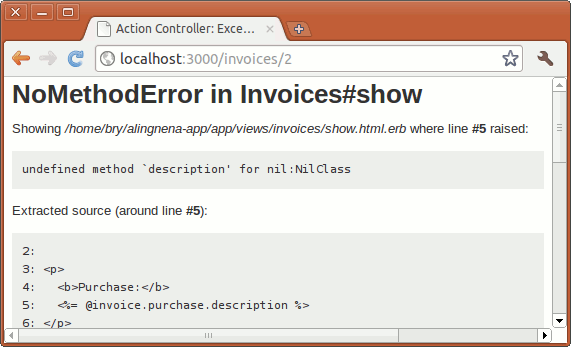
We get Ruby’s equivalent to a Null Pointer Exception.
There are some ways to remedy this problem. The most obvious would be to make the field mandatory through validations. But for entities that allow that foreign key field to be empty, we need to directly address the problem.
One way would be to add a special method inside the model. For example:
class Invoice < ActiveRecord::Base
belongs_to :purchase
def display_purchase
return purchase.description unless purchase.nil?
"(no Purchase set)"
end
end
Then just call @invoice.display_purchase from the view. This approach is legal and is actually the preferred approach For educational purposes, however, let’s move the logic to the view instead:
<p>
<b>Purchase:</b>
<% unless @invoice.purchase.nil? %> <%= @invoice.purchase.description %> <% else %> (no Purchase set)
<% end %></p>
Our problem this time is that we’re adding 5 lines of processing code to our view for a simple task. If we do this a lot, our view would look cluttered and may bring back bad memories of old JSP, ASP, PHP code from older developers. We can take out this code from our views through the helper files.
The helper files are located at the app/helpers folder. These are modules where you can add methods that you would use in your views. One helper is created per controller if you generated them throughrails generate controller or scaffold. We can move our logic from the view into the helper by adding the following lines to app/helpers/invoices_helper.rb:
module InvoicesHelper
def display_purchase(invoice)
unless invoice.purchase.nil?
invoice.purchase.description
else
"(no Purchase set)"
end
end
end
and just call the helper in our view:
<p>
<b>Purchase:</b>
<%= display_purchase(@invoice) %></p>
Due to the “helper :all” call in ApplicationController, all helper methods from all helpers are available to all views. The file scheme used is just for developers to classify the helpers according to the program they are used.
Helpers are usually used for generating markups. For instance, we want to have the Purchase field to have a link to the original purchase, we can use:
module InvoicesHelper
def display_purchase(invoice)
unless invoice.purchase.nil?
link_to invoice.purchase.description, invoice.purchase
else
"(no Purchase set)"
end
end
end
You can’t do this inside the model, and this gives helpers an advantage over the model approach.
has_one
We’ve already associated Invoice with Purchase but not the other way around. In order for us to be able to call methods like @purchase.invoice, we must first declare the association in the Purchase model. Given that we’re using a one-to-one relationship, the association declaration will be:
class Purchase < ActiveRecord::Base
has_one :invoice
end
With the has_one method declared, we can now call the following methods in Purchase:
-
purchase.invoice,purchase.invoice= -
purchase.build_invoice,purchase.create_invoice
Yes, these are the same methods as the ones in the belong_to model.
You can provide options in the :has_one declaration. Here are a few:
-
:dependent– provides the behavior when this model is deleted i.e. cascading delete options. Setting it to:nullifysimply sets the foreign key reference in the other entity toNULL. Using:destroywill call the:destroyof the other entity, while using:deletewill simply delete the related record via SQL. -
:validate– when set totrue, validates the associated object upon save of this object. By default this isfalse.
Nested Routes and Singular Resources
One problem with our current Purchase-Invoice scheme is that you could assign one Purchase to two Invoices.
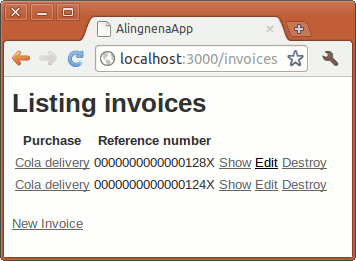
Calling @purchase.invoice on this will return only the first related Invoice.

The root cause of this problem is that we’re creating Invoices outside the context of the Purchase. Wouldn’t it make more sense to be able to go to http://localhost:3000/purchases/1/invoice/new to create the invoice for the first Purchase that what we’re currently doing right now?
We can do this with the help of 2 new routing concepts: the singular resource and nested resources.
The singular resource just like our typicalresources call, but instead of dealing with multiple records, it deals with only one object. For example, adding the singular resource route:
resource :platform
assumes that we only have one Platform entity for the entire system (note we used resource instead of resources). The generated routes in this instance is:
| helper | HTTP verb | URL | controller | action | use |
|---|---|---|---|---|---|
platform_url, platform_path
|
GET | /platform |
Platforms |
show |
Display the platform |
new_platform_url, new_platform_path
|
GET | /platform/new |
Platforms |
new |
Return a form for creating the new platform |
| POST | /platform |
Platforms |
create |
Create the new platform | |
edit_platform_url, edit_platform_path
|
GET | /platform/edit |
Platforms |
edit |
Return a form for editing the platform |
| PUT | /platform |
Platforms |
update |
Update the platform | |
| DELETE | /platform |
Platforms |
destroy |
Delete the platform |
To use this in the Purchase-Invoice relationship, we’ll have to set the Invoice as a singleton child of each Purchase entity by nesting aresource call under the resources call:
AlingnenaApp::Application.routes.draw do
resources :purchases do
resource :invoice
end
resources :debts
resources :products do
collection do
get 'search'
end
end
end
This will create the following additional routes:
| helper | HTTP verb | URL | controller | action |
purchase_invoice_url, purchase_invoice_path
|
GET | /purchases/:purchase_id/invoice |
Invoices |
show |
new_purchase_invoice_url, new_purchase_invoice_path
|
GET | /purchases/:purchase_id/invoice/new |
Invoices |
new |
| POST | /purchases/:purchase_id/invoice |
Invoices |
create |
|
edit_purchase_invoice_url, edit_purchase_invoice_path
|
GET | /purchases/:purchase_id/invoice/edit |
Invoices |
edit |
| PUT | /purchases/:purchase_id/invoice |
Invoices |
update |
|
| DELETE | /purchases/:purchase_id/invoice |
Invoices |
destroy |
We have to change the logic of our Invoice program to handle these changes. First, the controller:
class InvoicesController < ApplicationController
def show
# we'll integrate the Invoice details in the Show Purchase screen
redirect_to purchase_path(params[:purchase_id])
end
def new
@purchase = Purchase.find(params[:purchase_id])
@invoice = @purchase.build_invoice
end
def edit
@purchase = Purchase.find(params[:purchase_id])
@invoice = @purchase.invoice
end
def create
@purchase = Purchase.find(params[:purchase_id])
@invoice = @purchase.build_invoice(params[:invoice])
if @invoice.save
redirect_to @purchase, :notice => 'Invoice was successfully created.'
else
render :action => "new"
end
end
def update
@purchase = Purchase.find(params[:purchase_id])
@invoice = @purchase.invoice
if @invoice.update_attributes(params[:invoice])
redirect_to @purchase, :notice => 'Invoice was successfully updated.'
else
render :action => "edit"
end
end
def destroy
@purchase = Purchase.find(params[:purchase_id])
@invoice = @purchase.invoice
@invoice.destroy
redirect_to @purchase
end
end
In case you’ve forgotten how routes work, the :purchase_id parameter is derived from the URL.
Here’s the changes we’ll need for the views. Let’s modify Invoice’s views:
# app/views/invoices/new.html.erb
<h1>New Invoice</h1>
<%= render 'form', :purchase => @purchase, :invoice => @invoice %><%= link_to 'Back', invoices_path %># app/views/invoices/edit.html.erb
<h1>Editing Invoice</h1>
<%= render 'form', :purchase => @purchase, :invoice => @invoice %><%= link_to 'Show', @invoice %> |
<%= link_to 'Back', invoices_path %># app/views/invoices/_form.html.erb
<%= form_for(invoice, :url => purchase_invoice_path(purchase)) do |f| %> <% if invoice.errors.any? %> <div id="error_explanation">
<h2><%= pluralize(invoice.errors.count, "error") %> prohibited this invoice
from being saved:</h2>
<ul>
<% invoice.errors.full_messages.each do |msg| %> <li><%= msg %></li>
<% end %> </ul>
</div>
<% end %> <p>
<label>Purchase</label><br />
<%= purchase.description %> </p>
<p>
<%= f.label :reference_number %><br />
<%= f.text_field :reference_number %> </p>
<p>
<%= f.submit %> </p>
<% end %><%= link_to 'Back', purchase %>Here’s Purchase’s app/views/purchases/show.html.erb:
<h1>Purchase Details</h1>
<p>
<b>Description:</b>
<%= @purchase.description %></p>
<p>
<b>Delivered at:</b>
<%= @purchase.delivered_at %></p>
<% display_invoice @purchase %><%= link_to 'Edit', edit_purchase_path(@purchase) %> |
<%= link_to 'Back', purchases_path %>We used a scriptlet instead of an expression so that we could use theconcat method (similar to PHP’s print or Servlets’ out.println) in our helper to add multiple elements in the view. Here’s the helper method:
# app/helpers/purchases_helper.rb
module PurchasesHelper
def display_invoice(purchase)
unless purchase.invoice.nil?
concat(raw "<p><b>Invoice Reference Number:</b>\n")
concat(link_to @purchase.invoice.reference_number,
edit_purchase_invoice_path(@purchase))
concat(raw "</p>")
concat(raw "<p>")
concat(link_to "Delete Invoice", purchase_invoice_path(@purchase),
:confirm => "Are you sure?", :method => :delete)
concat(raw "</p>")
else
concat(raw "<p>")
concat(link_to "Create Invoice", new_purchase_invoice_path(@purchase))
concat(raw "</p>")
end
end
end
Our new Purchase-Invoice program should work properly now:
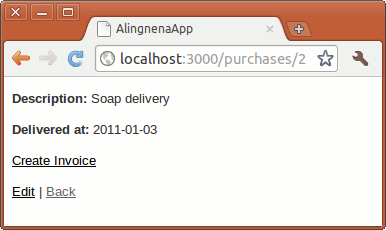
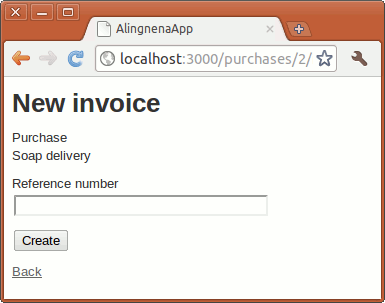
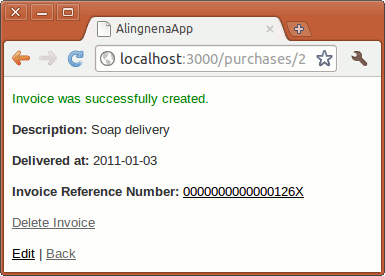
On second thought, using concat was an ugly approach. Change the display_invoice call to an expression (i.e. change <% display_invoice... at show.html.erb to <%= display_invoice...) and change the helper to the following:
module PurchasesHelper
def display_invoice(purchase)
unless purchase.invoice.nil?
render 'invoice', :purchase => @purchase
else
render 'no_invoice', :purchase => @purchase
end
end
end
Then create the following partials:
# app/views/purchases/_no_invoice.html.erb
# app/views/purchases/_invoice.html.erb
One-to-Many Relationships
Once you know how to create a one-to-one relationship, one-to-many associations should be simple. Let’s create a Supplier-Purchase one-to-many association, that is, Aling Nena could make multiple purchases from a single supplier.
Here’s the script for the basic setup:
$ rails generate scaffold supplier name:string contact_number:string
$ rails generate migration AddSupplierToPurchase supplier_id:integer
$ rake db:migrate
Note that we didn’t use :references in the migration because it doesn’t work with add_column.
Modify the models like so:
class Purchase < ActiveRecord::Base
has_one :invoice
belongs_to :supplier
def display_supplier
return supplier.name unless supplier.nil?
end
end
class Supplier < ActiveRecord::Base
has_many :purchases
end
The argument :purchases should be plural according to convention.
As for the purchase screen, collection_select is appropriate for the Supplier-Purchase association:
...
<%= f.date_select :delivered_at %> </div>
<div class="field">
<%= f.label :supplier_id, "Supplier" %><br />
<%= f.collection_select :supplier_id, Supplier.all, :id, :name, :prompt => true %> </div>
<div class="actions">
<%= f.submit %> </div>
...
If you want to modify the Show Purchase screen to show the Supplier, just use the display_supplier method from the model.
Before we can proceed with displaying the list of Purchases under the Supplier, we must first understand what the has_many declaration does to a model.
has_many
The following instance methods are added to Supplier after we added the has_many :purchases in the model class:
-
supplier.purchases– returns a list of Purchase objects associated with the Supplier. This is also cached so if you want to reload the list, just passtrue to the method. -
supplier.purchases <<new_purchase– adds a Purchase to the list of Purchases associated with the Supplier. -
supplier.delete(*purchase)– removes the association to the object or objects specified. When an association is removed, the action done to the object depends on the:dependentoption i.e. it will either nullify the field or delete the record. -
supplier.purchases =list_of_purchases– assigns a list of Purchase objects to the Supplier, removing associations as appropriate. -
supplier.purchase_ids,supplier.purchase_ids =list_of_purchase_ids– just like.purchases, but instead of dealing with a list of Purchase objects, this just uses a list ofidsof those objects. -
supplier.purchases.clear– removes all associations to Purchase objects. -
supplier.purchases.empty?– returns true if there are no associated Purchases -
supplier.purchases.size– returns the number of associated Purchases -
supplier.purchases.find(),supplier.purchases.exist?()– basically justActiveRecord.findandActiveRecord.exist?but only uses the Purchase records associated with the Supplier -
supplier.purchases.build(),supplier.purchases.create()- just like thebuild_xxxxandcreate_xxxxfromhas_one
With this knowledge, we can now add the list of Purchases in the Show Supplier screen:
<h1>Supplier Details</h1>
<p>
<b>Name:</b>
<%= @supplier.name %></p>
<p>
<b>Contact number:</b>
<%= @supplier.contact_number %></p>
<h2>Related Purchases</h2>
<ul>
<% @supplier.purchases.each do |purchase| %> <li><%= link_to purchase.description, purchase %></li>
<% end %></ul>
...
The resulting page is:
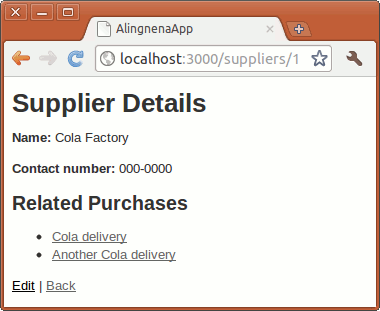
Many-to-many Relationships
We can use Purchase and Product to demonstrate how many-to-many associations are done in Rails. A Purchase can consist of many Products, while a Product can be part of many Purchases. There are two ways declaring this many-to-many relationship in Rails, and both require a join table.
has_and_belongs_to_many
We can declare has_and_belongs_to_many in our models to specify that the models have a many-to-many relationship with each other. For this to work, there must first be an existing join table that satisfies the following conditions:
- It must be named according to the tables involved in the relationship, separated by underscore and arranged alphabetically. In the Product-Purchase case, the table should be
products_purchases. - It must only contain references to each table. It should not have any other fields e.g. primary key.
Let’s setup the product_purchase table with a migration:
$ rails generate migration CreateProductsPurchases
Edit the generated migration:
class CreateProductsPurchases < ActiveRecord::Migration
def self.up
create_table :products_purchases, :id => false do |t|
t.integer :product_id
t.integer :purchase_id
end
end
def self.down
drop_table :products_purchases
end
end
The :id => false option removes the default primary key field from the table.
Then add the has_and_belongs_to_many declaration in the model:
# app/models/product.rb
class Product < ActiveRecord::Base
validates_presence_of :name, :description
has_and_belongs_to_many :purchases
...
# app/models/purchase.rb
class Purchase < ActiveRecord::Base
has_one :invoice
belongs_to :supplier
has_and_belongs_to_many :products
...
At this point, you can already perform has_many methods on both sides. For example:
some_product.purchases << new_purchase
some_product.purchases # this will return a list containing new_purchase
new_purchase.products # this will return a list containing some_product
The has_and_belongs_to_many declaration is suited for simple many-to-many relationships. One possible scenario is a Book-liking module where Users can “like” Books. In turn, a Book can have many Users that “like” it.
For more complex relationships that would have other details, we would need another approach. For example, the relationship between Purchase and Product may also require us to specify the quantity of the Product in that Purchase. We can’t store that in our join table because of the limitations of that table.
The has_many :through declaration provides the other approach to many-to-many relationships.
More on One-to-Many
The has_many :through declaration works because it uses two one-to-many associations linked together by one join table:

Once declared, this association works just like has_and_belongs_to_many wherein you could call methods like some_product.purchases. It’s not that complicated, so let’s take this time to explore one-to-many again instead.
Our join table for Product-Purchase would be Line Items, child records of Purchase that would represent lines in the Invoice. This is where Aling Nena would input the quantity, cost, and (most importantly) the Product involved.
Setting up the Line Items program should be easy with rails generate scaffold:
$ rails generate scaffold line_item purchase:references product:references quantity:integer
cost:decimal
Taking a cue from Invoice, we’ll make Line Item a child resource for Purchase to make maintenance easier.
Nested Resources
We’ve previously discussed what routes are generated when a singular resource is assigned as a child to a resource route. Now we’ll assign a normal resource under a resource route:
AlingnenaApp::Application.routes.draw do
resources :suppliers
resources :purchases do
resource :invoice
resources :line_items
end
resources :debts
resources :products do
collection do
get 'search'
end
end
end
This generates the following routes:
| helper | HTTP verb | URL | controller | action |
|---|---|---|---|---|
purchase_line_item_url purchase_line_item_path
|
GET | /purchases/:purchase_id/line_items |
LineItems |
index |
new_purchase_line_item_url new_purchase_line_item_path
|
GET | /purchases/:purchase_id/line_items/new |
LineItems |
new |
| POST | /purchases/:purchase_id/line_items |
LineItems |
create |
|
| GET | /purchases/:purchase_id/line_items/:id |
LineItems |
show |
|
edit_purchase_line_item_url edit_purchase_line_item_path
|
GET | /purchases/:purchase_id/line_items/:id/edit |
LineItems |
edit |
| PUT | /purchases/:purchase_id/line_items/:id |
LineItems |
update |
|
| DELETE | /purchases/:purchase_id/line_items/:id |
LineItems |
destroy |
With routes set, we proceed with some model changes:
class Purchase < ActiveRecord::Base
has_one :invoice
belongs_to :supplier
has_many :line_items
...
class Product < ActiveRecord::Base
validates_presence_of :name, :description
has_many :line_items
...
After the model comes the controller rewrite of app/controller/line_items_controller.rb:
class LineItemsController < ApplicationController
def index
# integrate with show purchase
redirect_to Purchase.find(params[:purchase_id])
end
def show
# integrate with show purchase
redirect_to Purchase.find(params[:purchase_id])
end
def new
@purchase = Purchase.find(params[:purchase_id])
@line_item = @purchase.line_items.build
end
def edit
@purchase = Purchase.find(params[:purchase_id])
@line_item = @purchase.line_items.find(params[:id])
end
def create
@purchase = Purchase.find(params[:purchase_id])
@line_item = @purchase.line_items.build(params[:line_item])
if @line_item.save
redirect_to @purchase, :notice => 'Line Item was successfully created.'
else
render :action => "new"
end
end
def update
@purchase = Purchase.find(params[:purchase_id])
@line_item = @purchase.line_items.find(params[:id])
if @line_item.update_attributes(params[:line_item])
redirect_to @purchase, :notice => 'Line Item was successfully updated.'
else
render :action => "edit"
end
end
def destroy
@purchase = Purchase.find(params[:purchase_id])
@line_item = @purchase.line_items.find(params[:id])
@line_item.destroy
redirect_to @purchase, :notice => 'Line Item was successfully deleted.'
end
end
And the views (null handling not implemented):
# app/views/purchases/show.html.erb
...
<%= display_invoice @purchase %><h2>Line Items</h2>
<table>
<tr>
<th>Product</th>
<th>Quantity</th>
<th>Cost</th>
</tr>
<% @purchase.line_items.each do |item| %> <tr>
<td><%= item.product.name %></td>
<td><%= item.quantity %></td>
<td><%= number_to_currency item.cost, :unit => "PhP" %></td>
<td><%= link_to "Edit", edit_purchase_line_item_path(@purchase, item) %></td>
<td>
<%= link_to "Destroy", purchase_line_item_path(@purchase, item),
:confirm => "Are you sure?", :method => :delete %> </td>
</tr>
<% end %></table>
<p><%= link_to "New Line Item", new_purchase_line_item_path(@purchase) %></p>
<%= link_to 'Edit', edit_purchase_path(@purchase) %> |
...
# app/views/line_items/new.html.erb
<h1>New Line Item</h1>
<%= render 'form', :purchase => @purchase, :line_item => @line_item %># app/views/line_items/edit.html.erb
<h1>Editing Line Item</h1>
<%= render 'form', :purchase => @purchase, :line_item => @line_item %># app/views/line_items/_form.html.erb
<%= form_for([purchase, line_item]) do |f| %> <% if line_item.errors.any? %> <div id="error_explanation">
<h2><%= pluralize(line_item.errors.count, "error") %> prohibited this line_item
from being saved:</h2>
<ul>
<% line_item.errors.full_messages.each do |msg| %> <li><%= msg %></li>
<% end %> </ul>
</div>
<% end %> <div class="field">
<label>Purchase</label><br />
<%= purchase.description %> </div>
<div class="field">
<%= f.label :product_id, "Product" %><br />
<%= f.collection_select :product_id, Product.all, :id, :name, :prompt => true %> </div>
<div class="field">
<%= f.label :quantity %><br />
<%= f.text_field :quantity %> </div>
<div class="field">
<%= f.label :cost %><br />
<%= f.text_field :cost %> </div>
<div class="actions">
<%= f.submit %> </div>
<% end %><%= link_to 'Back', purchase %>Here’s the program in action:
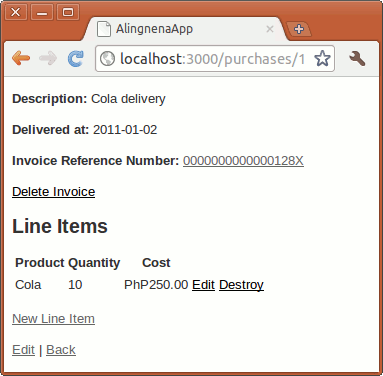
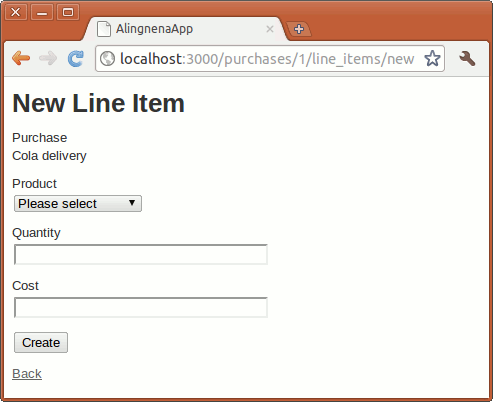

Nothing really new here. Sharp eyed readers might notice the strange usage of form_for in Invoice and Line Items. In Invoice, the form_for is written as:
<% form_for(invoice, :url => purchase_invoice_path(purchase)) do |f| %>The :url option overrides the expected URL helper, invoice_path(purchase), with purchase_invoice_path(purchase). Since this is a singleton resource, both create and update URLs are the same so the partial works for both cases.
In Line Items, the form_for is written as:
<% form_for([purchase, line_item]) do |f| %>Instead of a single object, we pass an array of objects. Based on this array of objects, Rails knows what URL to use according to the convention. If the line_item object was new, the path it will use will be purchase_line_items_path(purchase). If it’s already existing, the path will be purchase_line_item_path(purchase, line_item).
has_many :through
Now that we could create Line Items, it’s time to show how we can use the many-to-many relationship in the Products side. For this, we need to add the has_many :through declaration:
class Product < ActiveRecord::Base
validates_presence_of :name, :description
has_many :line_items
has_many :purchases, :through => :line_items
...
The :through specifies the join table used for the relationship. This join table must also be declared as the target table in a has_many declaration.
We can now access the list of Purchases involving the Product throughproduct.purchases. Here’s one way of doing it at app/views/products/show.html.erb:
...
<p>
<b>Stock:</b>
<%= @product.stock %></p>
<h2>Related Purchases</h2>
<ul>
<% @product.purchases.each do |purchase| %> <li><%= link_to purchase.description, purchase %></li>
<% end %></ul>
<%= link_to 'Edit this record', edit_product_path(@product) %> <br />
...
And the result:
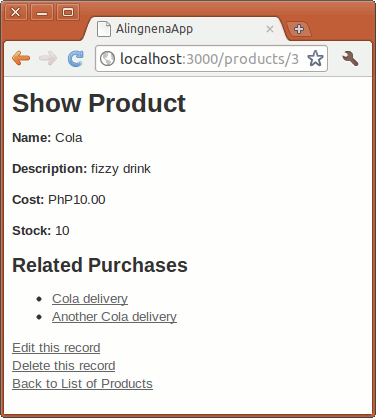
Just to show that the many-to-many goes both ways, let’s do the same for Purchase (even though it will look redundant):
class Purchase < ActiveRecord::Base
has_one :invoice
belongs_to :supplier
has_many :line_items
has_many :products, :through => :line_items
def display_supplier
return supplier.name unless supplier.nil?
end
end
# app/views/purchases/show.html.erb
...
<p><%= link_to "New Line Item", new_purchase_line_item_path(@purchase) %></p>
<h2>Related Products</h2>
<ul>
<% @purchase.products.each do |product| %> <li><%= link_to product.name, product %></li>
<% end %></ul>
<%= link_to 'Edit', edit_purchase_path(@purchase) %> |
...
Here’s the updated page:
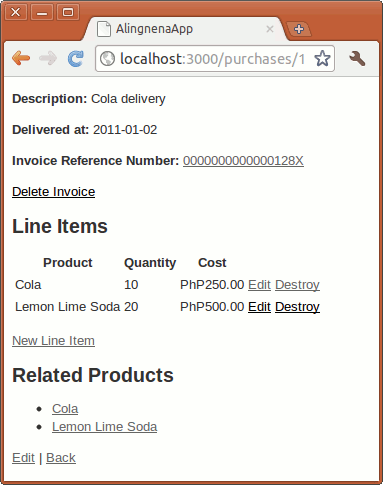
The whole thing looks ok, but what if you add another “Cola” Line Item to “Cola delivery”?
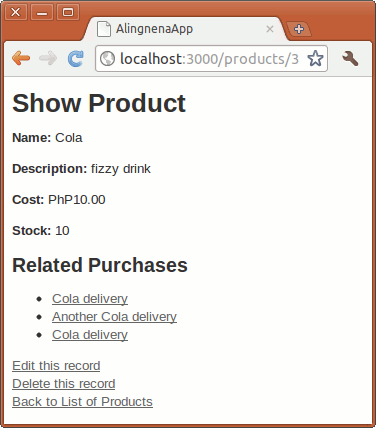
Cola delivery is listed twice since there are two references to Cola in Line Items. To eliminate the redundant results, we can add the :uniq option:
class Purchase < ActiveRecord::Base
has_one :invoice
belongs_to :supplier
has_many :line_items
has_many :products, :through => :line_items
has_many :products, :through => :line_items, :uniq => true
def display_supplier
return supplier.name unless supplier.nil?
end
end
class Product < ActiveRecord::Base
validates_presence_of :name, :description
has_many :line_items
has_many :purchases, :through => :line_items
has_many :purchases, :through => :line_items, :uniq => true
def before_validation
if description.blank?
self.description = name
end
end
end
Trying the two pages produces:
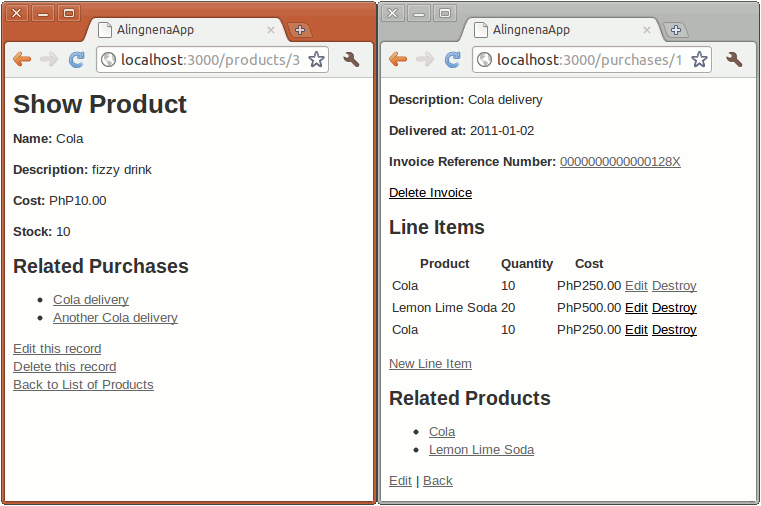
Another problem is the amount of queries are performed in our Purchase page:

A query is made for every Product record that needs to be displayed in the page. To reduce this to fewer queries, we can chain the includes() method after the find method for show:
def show
@purchase = Purchase.includes(:line_items => :product).find(params[:id])
...
This will tell Rails to “eager-load” the line items association (and its child association, product) as opposed to the default “lazy-load” approach where the records are retrieved only when needed (e.g. a product.name call).

The action is now reduced to 5 queries from its original 7.
The includes() call isn’t limited to a single relationship hierarchy. You can pass arrays and hashes in the includes() call to eager-load any relationship you want. For example, the following is not practical, but will not throw an error:
@purchase = Purchase.includes([:invoice, {:line_items => [:product, :purchase]},
:supplier])
.find(params[:id])
As you might have guessed, arrays denotes the “sibling” relationship under a current model (e.g. :invoice, :line_item, and :supplier are all under the Purchase model) while a hash would denote moving to a different model (e.g. :product and :purchase are under the LineItem model).
Skimming through Rails
Rails is a simple but fairly large framework. We can’t cover everything in this course, so in this chapter, we will go through the features that you might have to use on a regular basis.
Rails Migrations
We’ve discussed the basics of migrations, namely, how to create or drop a table and how to add or remove columns from them. We also used generator scripts for the migrations instead of coding them manually.
In this part, we’ll discuss the various methods available to us in the migrations. We’ll also go deeper in the mechanisms behind migrations.
Creating Tables
The create_table method accepts a table name and a block where we define the fields in the table. Going back to our first migration:
def self.up
create_table :debts do |t|
t.string :name
t.text :item
t.decimal :amount
t.timestamps
end
end
This create_table call creates the table debts in the database with an integer primary key “id”, a string field “name”, a text field “item”, a decimal field “amount”, and two timestamp fields “created_at” and “updated_at”.
We’ve discussed before the possible data types for use in defining columns. Here’s the fields that would be created per database for those data types:

There are also shorthand data types e.g. the t.references from the previous lesson.
There are options you could specify to each column declaration to apply database-level constraints:
-
:null– set this option to true if nulls are allowed for this field, false otherwiset.string:name,:null=>false# sets name field to mandatory -
:default– set this option to make the database set a default value for the field if the field is left empty. If you want the field default to be NULL, usenil. -
:limit– set this option to the maximum size of the field This refers to the number of characters for:stringand:text, number of bytes for the:binaryand:integer.
The following options are for :decimal:
-
:precision– the precision of the decimal column, the number of significant digits in the number -
:scale– the scale of the decimal column, the number of digits after the decimal point. The number 123.45 has a precision of 5 and a scale of 2.
Note that these column options can also be used in the add_column method. For example:
add_column :debts, :remarks, :text, :limit => 200
You can also set options for the table by passing a hash of options after the table name:
-
:id => false– this will prevent the automatic creation of the primary key -
:primary_key– if:idis is not set to false, you can set this option to change the name of the primary key from “id” e.g.create_table:debts,:primary_key=>"debt_no"do|t| -
:force => true– this will make the migration drop the table of the same name (if it exists) before creating the table -
:temporary => true– the table created is only temporary and will be dropped when the connection is closed. -
:options– the value specified in this option will be appended to the table definition SQL. For example:create_table:debts,:options=>"ENGINE=InnoDB DEFAULT CHARSET=utf8"do|t|will create
CREATETABLEdebts(...)ENGINE=InnoDBDEFAULTCHARSET=utf8
Other Migration Methods
Here are some other methods you can use in the migrations:
-
change_column(table_name, column_name, type, options = {})– changes a column to the specified type and options. The column options are the same fromcreate_tableandadd_column. For example, you want to change the maximum length of remarks, you could use:change_column:debts,:remarks,:text,:limit=>300 -
rename_column(table_name, column_name, new_column_name)– renames a column tonew_column_name -
add_index(table_name, column_name, options = {})– adds an index to the table. You can set the name of the index as well as the unique setting in the options. -
remove_index(table_name, options = {})– removes an index from the table -
rename_table(table_name, new_name)– renames tabletable_name tonew_name -
change_table(table_name)– changes columns in thecreate_table syntax.
Migration Mechanism
When you run rake db:migrate, Rails first checks theschema_migrations table for the list of migrations already applied to the database then it applies all migrations not already inside the table. For example, we have the following situation:

In this case, our schema_migrations table is missing the 12 noon and 9AM migrations. The missing 9AM migration is possible, you might have just updated your local version of the application and got that migration from another developer. Running rake db:migrate will apply the two migrations into your database and insert two new records to the schema_migrations table.
To rollback your database to an older version, you can use the VERSION environment variable to pass a timestamp:
$ rake db:migrate VERSION=2010060113000
This will rollback all migrations after the specified timestamp (if any; it’s possible to use this call for a “roll-forward”) and apply all migrations on or before the said timestamp.
Active Record
There are still a lot of important concepts in Active Record that we haven’t discussed in detail yet.
Querying
Aside from find() and all(), there are two other general methods for retrieving records:
-
first()– returns the first record retrieved from the table. -
last()– returns the last record retrieved from the table..
As we’ve seen in the includes() method in the previous lesson, these methods can be chained with other methods to modify their behavior. Note that all() is used by default so you don’t need to specify it in a chain with other methods.
Below are the methods that you can use for querying.
where
You can define the WHERE part of the SQL statement with thewhere method. It accepts either a string, an array that starts with a string, or a hash. Passing a string would simply make it use the string as the SQL WHERE clause of the query. For example:
User.where("user_name = '#{user_name}' AND password = '#{password}'").first
would find the record with a user name and password that matches the supplied credentials. Obviously this approach is prone to SQL injection attacks, so a better approach would be to use an array argument which creates a parameterized WHERE clause.
User.where("user_name = ? AND password = ?", user_name, password).first
The 2nd element onwards are assigned to the question marks after sanitizing the elements. The problem with this form of parameterized queries is that when the query becomes larger, it becomes difficult to determine which parameter is assigned to which question mark. Here we can use named parameters (symbols inside the string) and a hash for the second element:
User.where("user_name = :user_name AND password = :password",
{ :user_name => user_name, :password => password }).first
For simple queries like the one above, you can use a hash of values. Rails would automatically convert the key-value pairs into a series of ‘key = value’ entries in theWHERE clause, also sanitizing the input in the process.
User.where( :user_name => user_name, :password => password ).first
order, select, from
The order() method allows you to provide the contents of the ORDER BY clause in the query. For example:
LineItem.order("purchase_id DESC, id")
The select() method allows you to define the fields for SELECT clause. By default, ActiveRecord uses “*” to select all fields in the table but if your database incurs a performance hit when you query certain fields (e.g. BLOB fields), you might want to remove those fields from the SELECT clause. As the object’s attributes are dynamically assigned, the removed fields will not be available in the return objects.
>> d = Debt.select("id").first
=> #<Debt id: 1>
>> d.name
ActiveRecord::MissingAttributeError: missing attribute: name
Similar to select() and order(), from() allows you to specify the fragment for the FROM clause. You might want to do this if you’re using a different table or a view for the query.
:group, :having, Calculations
The group() and having() methods are also like order(), they allow you to provide the SQL fragments for GROUP BY and HAVING clauses in the query, respectively.
LineItem.group("product_id")
LineItem.group("purchase_id").having("purchase_id = 1")
Since HAVING only applies to GROUP BY, :having will only be applied to the query if there is a :group option specified.
Queries involving group() will only return one record per “group”. Because of this, group() and having() are better used with the aggregate functions under ActiveRecord::Calculations. The available functions are:
-
count– returns the number of records per groupLineItem.group("purchase_id").count -
average– returns the average value of a specified field per groupLineItem.group("purchase_id").average("cost") -
sumLine– returns the sum of the values of a specified field per groupItem.group("purchase_id").sum("cost") -
maximum,minimum– returns the maximum and minimum value of a specified field per groupLineItem.group("purchase_id").maximum("cost")LineItem.group("purchase_id").minimum("cost")
The return value for these methods will be a hash of the “field name used ingroup” ⇒ “calculated value”. Note that these aggregate functions only work for one grouping field name, using more than one (e.g. group("purchase_id, product_id")) would return unpredictable results.
Also note that the aggregate functions can be used without the group() method to calculate the value for the entire table (the result will be a single value, not a hash).
:limit, :offset
The :limit option allow you to specify how many records are retrieved by the query.
Debt.limit(10)
When the :limit option is used for paginating records, we often employ another option, :offset, to determine the “starting point” for the query. The number passed to :offset determines the number of records to skip in the query. For example:
Debt.offset(5)
This query skips the first 5 records retrieved and starts with the 6th record.
:readonly, :lock
Set readonly to true if you want to prevent updates to the retrieved records.
>> d = Debt.readonly(true).first
=> #<Debt id: 1, name: ...>
>> d.save
ActiveRecord::ReadOnlyRecord: ActiveRecord::ReadOnlyRecord
You can use lock() to add a fragment for locking in the query e.g. “FOR UPDATE” or “LOCK IN SHARE MODE”. Using lock(true) uses the default exclusive lock for the connection, usually “FOR UPDATE”.
find_by_sql
When all else fails, you can always specify an SQL query via the find_by_sql method. The attributes of the objects are dynamically assigned from the results of the query.
>> line_items = LineItem.find_by_sql("SELECT pu.description purchase_description,
pr.name, product_name FROM line_items li, purchases pu, products pr WHERE
li.purchase_id = pu.id AND li.product_id = pr.id")
=> [#<LineItem >, #<LineItem >, …]
>> line_items[0].purchase_description
=> "Cola delivery"
>> line_items[0].product_name
=> "Cola"
Validation
There are other validations aside from validates_presence_of listed in the API docs under ActiveRecord::Validations::ClassMethods. Here’s a list of the methods listed there:
-
validates_acceptance_of– validates if the specified field is accepted by the user, usually used in terms of service check boxes. -
validates_associated– validates if the objects in the specified associations are valid. -
validates_confirmation_of– validates if a copy of the specified field (appended with a_confirmation, e.g.email_confirmationforemail) is part of the submitted form and matches the specified field. This confirmation field is not saved along with the record though it can be accessed like any other field i.e. it’s a virtual field. -
validates_each– validates each attribute against a block -
validates_inclusion_of,validates_exclusion_of– validates if the value of the field is part of (inclusion) or not part of (exclusion) the specified collection -
validates_format_of– validates the field against a regular expression -
validates_length_of– validates the length of the field -
validates_numericality_of– validates the field if it’s a number. Can also check if it’s a float or an integer. -
validates_uniqueness_of– validates whether the field is unique in the table
These validation methods typically have the following options:
-
:message– allows you to replace the default message. For example you want to change the “can’t be blank” message forvalidates_presence_of, you can use:validates_presence_of:name,:message=>"is required" -
:on– specifies when this validation is active (default is:save, other options are:createand:update). -
:allow_nil– skips the validation if the attribute isnil -
:if,:unless– specifies a method, Proc or string to call to determine if the validation should (:if) or should not (:unless) occur. The method or Proc would be evaluated, while the string would be converted to ruby code then evaluated.
Aside from those validations, you can also use validate, validate_on_create, and validate_on_update to define your own validations. These methods are used just like before_filter is used in controllers.
class Employee < ActiveRecord::Base
validate_on_create :check_status
private
def check_status
if status == "Suspended"
errors.add(:status, "can't be Suspended when creating a new Employee")
end
end
end
Each Active Record object has anerrors collection containing the errors collected during validation. In the case above, we added a new error to the name field. Not only will this determine the complete error message to be displayed (the field name is added at the beginning of the message), this will also mark the field as an error on the form as we shall see later.
For error messages that aren’t applicable to a single field, you can use errors[base]:
errors[base] << "You must specify a contact number or an e-mail address"
If you want to populate the errors collection without saving the object, you can call validate on the object. The methods for checking whether the object is valid or not, valid? and invalid?, also call validation.
Additional methods for errors can be found in the API docs under ActiveRecord::Errors. Here are some of the more commonly used errors methods:
-
[]– returns an array of errors for a specified field>>p=Product.new=>#<Productid:nil,name:nil,...>>>p.valid?=>false>>p.errors[:name]=>"can't be blank" -
size– returns the number of errors in the collection>>p=Product.new=>#<Productid:nil,name:nil,...>>>p.errors.size=>0>>p.valid?=>false>>p.errors.size=>2 -
clear– removes all errors in the collection
Transactions
You can group database actions into transactions by putting them inside a transaction block:
begin
ActiveRecord::Base.transaction do
source_account.withdraw(10000)
dest_account.deposit(10000)
end
rescue
# some error handling
end
In this transaction method call, a rollback would be issued if an exception is thrown inside the block. Since this is a class method of ActiveRecord::Base, you can switch out the ActiveRecord::Base with any model class, for example:
Account.transaction do
...
end
You can also use a model object:
source_account.transaction do
...
end
The only problem with using this shorter form is that inexperienced developers might think that the transaction is in the Accounts table level. In reality, the transaction is in the database level; you can use different tables in the transaction:
Student.transaction do
student.save!
course.save!
end
You can also nest transactions. By default all database actions inside the nested transactions are part of the parent transaction. You can pass the option :requires_new => true to create a sub-transaction which would roll back only up to the start of the sub-transaction. Either way, the behavior still depends on the database used. For example, if we are using MySQL in the following nested transactions without :requires_new:
Product.transaction do
Product.create(:name => 'Test')
begin
Product.transaction do
Product.create('Test2')
Product.create!()
end
rescue
end
end
would not rollback any transaction i.e. “Test” and “Test2” are created. Using :requires_new => true would create a SAVEPOINT between “Test” and “Test2” so only “Test” is successfully committed after the exception at Product.create!:
Product.transaction do
Product.create(:name => 'Test')
begin
Product.transaction(:requires_new => true) do
Product.create('Test2')
Product.create!()
end
rescue
end
end
We enclosed the sub-transaction with a begin-rescue because all exceptions are still propagated upward after the rollback is processed. The only exception that is not propagated by the transactions is ActiveRecord::Rollback. For example, the following will behave the same as the previous example even without the rescue block:
Product.transaction do
Product.create(:name => 'Test')
Product.transaction(:requires_new => true) do
Product.create('Test2')
raise ActiveRecord::Rollback
end
end
Action Controller
We’ve had extensive discussions on Action Controller so the topics below aren’t that complicated.
Root Routing
We’ve discussed almost everything about routing, from match to nested resources. The other options available for match and resources aren’t that important so just refer to the Routing API docs if you need to use them.
However, you might miss one important routing method while reading through references: the root method. For example:
root :to => 'pages#main'
This method is basically just another named route so all of the options available formatch would work in it. What’s special about it is that it maps the root of your application to a controller action.
Going to http://localhost:3000/ won’t immediately direct you to themain action ofpages, though. As you may recall in the introduction and our asset tags lesson, the /public folder is mapped to the root, and like many web servers, WEBrick and Unicorn will serve you /public/index.html when you access the root.
To make your root route work, you must first delete/public/index.html. As a named route, you can also use the generated helpers root_url and root_path in your controllers and views.
Multiple Representations
You might be wondering about the purpose of this code fragment in our Debts program:
def show
@debt = Debt.find(params[:id])
respond_to do |format|
format.html # show.html.erb
format.xml { render :xml => @debt }
end
end
The respond_to block is processed depending on the MIME type requested by the user, that is, the blocks inside the format.xxxx calls are processed when they mach the format requested by the user. In format.xml, render :xml was called: the render option :xml renders an XML representation of the object argument.
In the absence of a block, the default rendering is performed. Thus, show.html.erb was used to render the Show Debt page. Had we not provided a block to format.xml, show.xml.erb would have been rendered as the response for a request for an XML.
Typically, the MIME type request is determined through the Accept request header. A browser would typically send an Accept header like this:
Accept: text/html,application/xhtml+xml,application/xml;q=0.9,*/*;q=0.8
and Rails would determine the format as html. In the next chapter, we shall see a request with an “Accept: text/javascript, ...” that would be handled in a format.js block.
Most browsers don’t allow the user to define the Accept request header. Thus, Rails provides a way to define the format through the :format parameter in routes. Recall the match default that we removed from routes.rb:
match ':controller(/:action(/:id(.:format)))'
The parsed :format parameter overrides the Accept header and tells respond_to what format to render and return to the user. So going to http://localhost:3000/promos/show/1.xml would process the format.xml block inside theshow action of thepromos controller, hopefully returning an XML version of the 1st promo in the database.
This format parameter is already added to your routes if you used resource or resources.
Cookies and Sessions
HTTP is a stateless protocol. Because of this, all web application platforms and web frameworks have their own means of storing the user’s state without having to go to the database. In this part, we will be discussing Rails’ implementation of the two most common state persistence schemes: cookies and sessions.
Cookies
You can set and retrieve cookies in the user’s browser using the cookies hash available in the controller. Accessing the hash would read the request while manipulating the hash would modify the response.
# returns the value of the "username" cookie
cookies[:username]
# sets the "theme" key to "blue"
cookies[:theme] = "blue"
Cookies can only store string keys and values. You can configure a cookie’s settings by passing a hash instead of a string for the value. (The available settings are listed at the API docs under ActionController::Cookies)
# Sets a cookie that expires in 1 hour.
cookies[:login] = { :value => "XJ-122", :expires => 1.hour.from_now }
The delete method can be used to manually delete cookie entries.
cookies.delete :theme
Session
Like other frameworks, Rails sessions differ from cookies in that while you can only store strings in cookies, you can store (serializable) objects in the session. Unlike other frameworks, however, Rails does not (by default) store the data in the server. Instead, it stores the data as cookies in the user’s browser.
While the idea of cookie based sessions might sound weird, there are important reasons behind it. First, the 4KB limit of cookies and the transparency of cookies promotes good practice: large session objects that contain sensitive data are avoided. Also, since the browser handles the cookie expiry, the server doesn’t need to waste processing cycles on session cleanup.
One valid concern about cookie based sessions is that cookies can easily be tampered with. To get around this, Rails cryptographically signs the session (you can find the Rails generated key at config/initializers/session_store.rb). The users can read the session values but they cannot tamper with them.
With the background out of the way, let’s proceed with using the session.
Using a session is easy; it’s simply a hash, session, available in the controller and the view (just like params and flash).
session[:current_user] = user
You can remove a session entry by setting it to nil. You can reset the entire session using the reset_session method.
Action View
We’ve already discussed almost all of the topics regarding Action View. Here, we’ll just wrap up the topic of form helpers and displaying form errors.
Other Form Helpers
We’ve already covered label, text_field, text_area, collection_select, and submit form helper tags. Here are the other form helper tags:
-
check_box– creates a check box for the specified field. It uses the default values for boolean form fields in Rails (“1” for true, “0” for false) so if you’re using the check box for non-boolean values, you can change the “checked” and “unchecked” values through the arguments. -
file_field– creates a file upload input tag. Uploading files is not part of the scope of this training course. -
radio_button– creates a radio button input tag. The radio buttons are grouped according to the specified field. -
hidden_field– creates a hidden input tag. -
password_field– creates a password-type input tag. -
date_select,datetime_select,time_select– produces a set of select tags (e.g. hour, month, etc) for the date/datetime/time field.
Full details can be found at the API under ActionView::Helpers::FormHelper and ActionView::Helpers::DateHelper.
Active Support Time Extensions
We encountered an Active Support extension to Ruby in the form of “blank?”. The rest of the Active Support extensions can be found in the API docs under ActiveSupport::CoreExtensions. In this section, we’ll focus on the changes made by Active Support related to numbers and time.
In Rails, all numbers have methods that make it look like they are being converted to time objects. Here are a few examples:
Time.now + 1.minute # returns the time 1 minute from now
1.minute.since(Time.now) # also returns the time 1 minute from now
1.minute.from_now # still returns time 1 minute from now
Time.now 2.days # returns the time 2 days ago –
2.days.ago # also returns time 2 days ago
Rails also has support for time zones. The default time zone is set in config/application.rb in the line:
config.time_zone = 'UTC'
This assumes that the server, as well as the user, is using UTC. Typically, you set the time zone value per user programatically inside a filter:
class ApplicationController < ActionController::Base
...
before_filter :set_time_zone
...
def set_time_zone
Time.zone = session[:time_zone]
end
...
The time zone setting not only changes how the time zone is displayed (e.g. if you use the %Z format in Time.strftime), it also affects how records are stored in the database for the user. For example:
| Datetime entered by the user (Time Zone = UTC +08:00) | Datetime saved in the database (Time Zone = UTC +00:00) | Datetime displayed the next time the user views the record |
|---|---|---|
| 06/12/10 01:00 PM | 06/12/10 05:00 AM | 06/12/10 01:00 PM |
This handling saves us the hassle of manually converting time input from foreign users to UTC and back. Rails also handles daylight saving time, yet another possibly problematic issue for time zone handling.
Running rake time:zones:all returns all the possible values for the time zone. You can also use rake time:zones:local to view the possible values based on your computer’s region settings:
$ rake time:zones:local
(in /home/user/alingnena-app)
* UTC +08:00 *
Beijing
Chongqing
Hong Kong
Irkutsk
Kuala Lumpur
Perth
Singapore
Taipei
Ulaan Bataar
Urumqi
Most of the time, you’ll probably set the default setting at theconfig/application.rb to:
config.time_zone = 'Taipei'
Ajax
Asynchronous JavaScript and XML, better known as Ajax, is a set of technologies used to improve the user’s experience when browsing websites. It does this by allowing the users to perform actions and let the browser and server handle it in the background instead having them go from page to page. This makes the user interfaces in websites more dynamic and responsive to the user.
At the core of Ajax is JavaScript which can send requests to the server in the background thanks to the XMLHttpRequest (XHR) object, and can modify the page based on the results thanks to the Document Object Model (DOM). There are 4 main approaches to Ajax depending on how XHR and DOM are used:
- status codes – XHR sends the request and DOM modifies the page based on the HTTP status code returned by the server.
- page fragments – XHR sends the request and the server returns a fragment of an HTML page. DOM inserts this fragment somewhere in the current page.
- code fragments – XHR sends the request and also requests for a JavaScript response. The returned data is in the form of JavaScript code that will modify the page through DOM which is then executed by the browser.
- data – XHR sends the request and also requests for a specific format (e.g. XML, JSON). The server returns data in the requested format, which will then be processed by JavaScript in the page. This will eventually lead to DOM calls to change the page’s contents.
Manually coding XHR and DOM calls can be hard. Fortunately, there are JavaScript libraries available to make these tasks easier. We will discuss two such libraries in this tutorial, Prototype, which comes with Rails, and jQuery, which is used by over 30% of the top 10,000 websites in the Internet.
Prototype
To demonstrate the basic uses of Prototype’s Ajax libraries, we’ll use a simple shoutbox program that allows visitors of Aling Nena’s website to leave a message for all to see:
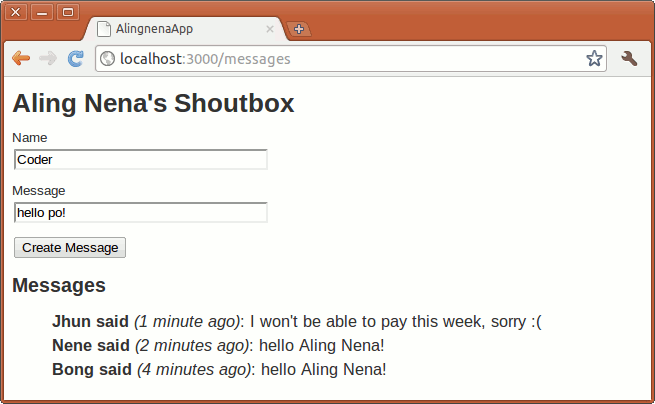
The program is straightforward: a user can submit his/her name and a message which will be added to the list on the page.
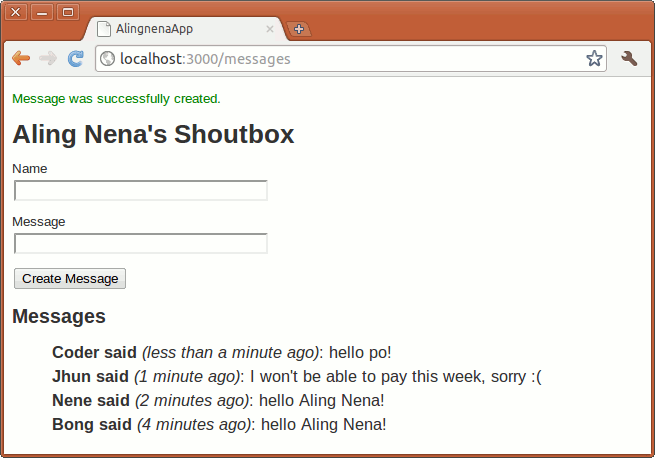
By now you should be able to code this on your own, but if you still can’t, just study the code snippets below to have an idea on what you need to do.
Updating a Part of the Page via remote link_to
In this lesson, we want to modify the page so that we could refresh the table to show the new messages without having to refreshing the entire page. The easiest way to do this in Rails 3 would be to use the 3rd Ajax approach, that is, to create JavaScript code which will insert the updated list inside the page, then use Prototype to retrieve run that code.
The first part is easy. We just have to add a new action:
resources :messages do
collection do
get 'message_table'
end
end
# app/controller/messages_controller.rb
def message_table
render :partial => Message.order("created_at DESC")
end
and partial for the list:
# app/views/messages/index.html.erb
...
<h2>Messages</h2>
<ul style="list-style-type:none;font-size:125%;line-height:150%" id="message_list">
<%= render :partial => @messages %></ul>
# app/views/messages/_message.html.erb
<li>
<strong><%= message.author %> said</strong>
<em>(<%= time_ago_in_words(message.created_at) %> ago)</em>:
<%= message.message %></li>
The partial can now be accessed at http://localhost:3000/messages/message_table
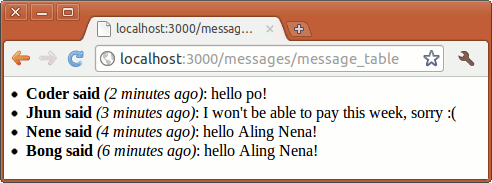
The second part is also easy but will require a bit more effort.
Before we move on, just note that the default Rails JavaScript libraries (which includes Prototype) are already included the:defaults argument in the layout so we don’t need to change anything or download any plugins to make it work.
...
<title>AlingnenaApp</title>
<%= stylesheet_link_tag :all %> <%= javascript_include_tag :defaults %></head>
...
RJS and render :update
Since generating this JavaScript DOM code by hand can be hard, Rails provides a way to define these changes with simpler Ruby declarations via RJS templates. These templates are translated to JavaScript and then sent back to the user for the browser to execute.
Just as we can render text directly from the controller, we can also render the JavaScript to be returned to the page directly from the controller without having to create RJS files. For this we need to use the :update option of render. The following code will generate the JavaScript to update the list.
# app/controller/messages_controller.rb
def message_table
respond_to do |format|
format.js do
render :update do |page|
page.replace_html :message_list, :partial => Message.order("created_at DESC")
end
end
format.html { render :partial => Message.order("created_at DESC") }
end
end
Then, all we need to do is to add this link to our page:
# app/views/messages/index.html.erb
<%= link_to "Refresh List", message_table_messages_path, :remote => true %>The :remote => true option tells Rails that the link should be processed as an AJAX call and not as a normal link. When you click the “Refresh List” link, it will process the RJS that we placed in the controller.
page.replace_html :message_list, :partial => Message.order("created_at desc")
Translating this code, it will replace (page.replace_html) the whole list (id message_list) in the page with the partial. You can verify it in the logs that only the message_table action was called on click and not the index action.

Form submission via Ajax
Let’s move on from the simple GET example to a slightly more complicated POST example. Here we’ll convert our form to use Ajax.
First, modify thecreate action to add the RJS code:
# app/controllers/messages_controller.rb
def create
@message = Message.new(params[:message])
respond_to do |format|
if @message.save
format.html { redirect_to(messages_path,
:notice => 'Message was successfully created.') }
format.xml { render :xml => @message, :status => :created, :location => @message }
format.js do
render :update do |page|
page.replace_html :message_list,
:partial => Message.all(:order => "created_at DESC")
page.replace_html :notice, 'Message was successfully created.'
page[:new_message].reset
end
end
else
@messages = Message.all(:order => "created_at DESC")
format.html { render :action => "index" }
format.xml { render :xml => @message.errors, :status => :unprocessable_entity }
format.js do
render :update do |page|
page.replace_html :notice, 'There was an error in creating the message.'
end
end
end
end
end
We also need to update our view in order for the Ajax call to work.
# app/views/messages/index.html.erb
<h1>Aling Nena's Shoutbox</h1>
<%= form_for(@message, :remote => true) do |f| %> <p>
<%= f.label :author, "Name" %><br />
...
Just like in link_to, we only needed to add a :remote => true option to tell Rails to process the form submission as an Ajax call.
Trying out the code will result in the following:
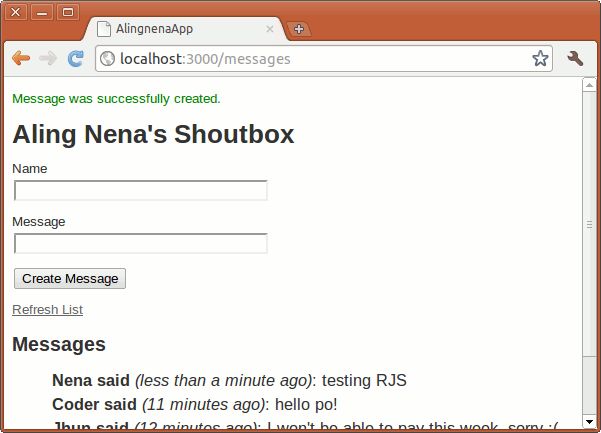
It looks like it behaved normally, but if you use the Mozilla Firefox extension Firebug or Google Chrome’s Developer Tools (Tools -> Developer tools), you’ll notice something different about the request and the response.
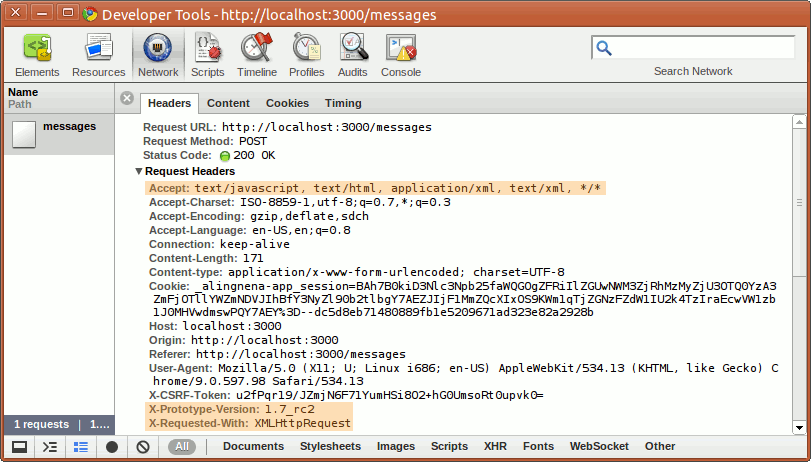
From the request headers, we could see that it’s using XHR and Prototype. However, the important thing here to note is the text/javascript in the Accept header which tells Rails the format the request requires.
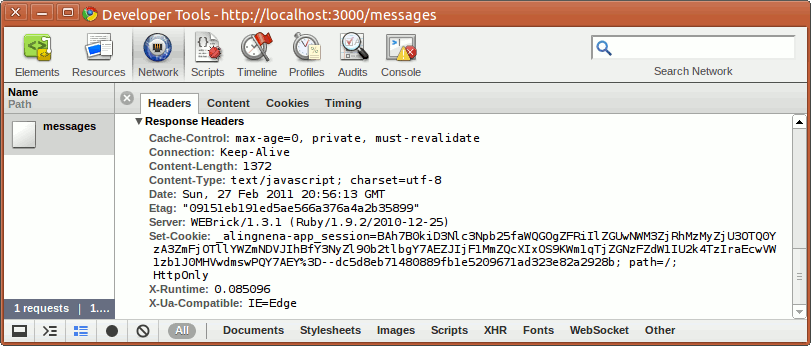
As for the response, there’s nothing unusual about the headers aside from the explicit disabling of caching. What’s interesting here is the body of the response.

As we mentioned before, Ruby code inside the render :update is translated to JavaScript. Here we see how the two page.replace calls were replaced by Element.update calls.
The page[:new_message] call, on the other hand, used Prototype’s $() function which finds the element with the matching id. It also applied to the element the method call reset() (that we supplied in the controller). Since reset() is a valid function for the matched element, it is called normally, thus resetting the form.
Aside from replace_html and the element selector, other methods can be found in the API docs under the ActionView::Helpers::PrototypeHelper::JavaScriptGenerator::GeneratorMethods module. For example, you could actually directly copy-paste the API docs sample code for delay() to make the notice disappear after 20 seconds:
format.js do
render :update do |page|
page.show 'notice'
page.replace_html :message_list,
:partial => Message.all(:order => "created_at DESC")
page.replace_html :notice, 'Message was successfully created.'
page.delay(20) do
page.visual_effect :fade, 'notice'
end
page[:new_message].reset
end
end
RJS templates
By using render :update, we essentially put view processing inside our controller. Not only does it break the MVC paradigm, it also becomes unwieldy once the page manipulation becomes more complex. To solve this problem, we can move the JavaScript generator code into the RJS templates.
RJS templates are simply view files with the .js.rjs extension. Just as format.html would go to the .html.erb file with the same name as the action, by convention format.js will process and render the .js.rjs file of the same name as the action if the action is called by Prototype.
In our program, we can modify the create action to go to the RJS template for the generator code:
def create
@message = Message.new(params[:message])
respond_to do |format|
if @message.save
format.html { redirect_to(messages_path,
:notice => 'Message was successfully created.') }
format.xml { render :xml => @message, :status => :created, :location => @message }
format.js
else
@messages = Message.all(:order => "created_at desc")
format.html { render :action => "index" }
format.xml { render :xml => @message.errors, :status => :unprocessable_entity }
format.js do
render :update do |page|
page.replace_html :notice, 'There was an error in creating the message.'
end
end
end
end
end
The generator code is then moved to app/views/messages/create.js.rjs:
page.show 'notice'
page.replace_html :message_list,
:partial => Message.order("created_at DESC")
page.replace_html :notice, 'Message was successfully created.'
page.delay(20) do
page.visual_effect :fade, 'notice'
end
page[:new_message].reset
The behavior will be the same, though if you would look at the logs, there would be an extra “Rendering messages/create” line confirming that create.js.rjs was processed.
Unobtrusive JavaScript and graceful degradation
Before we move on to using jQuery, you may want to take note that the JavaScript used in the two examples above are not inline scripts. In other words, the a and form elements are still basic HTML without any JavaScript within them:
<form accept-charset="UTF-8" action="/messages" class="new_message" data-remote="true"
id="new_message" method="post"><div style="margin:0;padding:0;display:inline">
<input name="utf8" type="hidden" value="✓" /><input name="authenticity_token"
type="hidden" value="Bqyf3d0T+Spa0RpLJqK7YhhSdWAp9tyW080LQcfnBq0=" /></div>
...
</form><a href="/messages/message_table" data-remote="true">Refresh List</a>
What Prototype does is look at the elements after the page has loaded and check if the data-remote attribute is set. When set, Prototype adds the necessary event handlers for these elements. Some people call this approach “unobtrusive JavaScript” or UJS, in contrast to old “obtrusive” ways of adding JavaScript into elements via inline scripts.
Aside from being cleaner, UJS has better support for disabled JavaScript. Remember, Ajax’s primary goal is to improve user experience. Therefore, it does not make sense for a program to stop working if the user disables JavaScript in his/her browser.
With UJS, one could easily see what would be the behavior in case the JavaScript is disabled. In our example above, link_to will just open a list of messages (we could easily redirect this back to index) while form_for will just behave like it used to.
jQuery
Due to its popularity, we’ve decided to include the popular JavaScript library, jQuery, into this training course. This library isn’t bundled with Rails, though it can be used to either replace or complement Prototype.
When it comes to Ajax, jQuery is suited to handle the 2rd (page fragment), the 3rd (code fragment), and even the 4th (manually parse data) type of approach to Ajax. To keep things simple, we’ll just discuss the jQuery equivalent of the RJS example above.
Let’s go over the basics of jQuery first before going to Ajax.
Installing the jquery-rails gem
We will be using thejquery-rails gem in order to replace the Prototype libraries in our application. To install the gem, modify theGemfile file and add the following line at the end:
...
# and rake tasks are available in development mode:
# group :development, :test do
# gem 'webrat'
# end
gem 'jquery-rails'
The Gemfile defines the list of RubyGems used by your Rails application. We will discuss more of this later; at the moment let’s just use the Bundler tool to install the missing gems from our application using the following command:
$ bundle install
Fetching source index for http://rubygems.org/
...
Installing jquery-rails (1.0.13)
Using rails (3.0.10)
Using sqlite3 (1.3.4)
Your bundle is complete! Use `bundle show [gemname]` to see where a bundled gem is
installed.
Once installed, Rails will have a new generator script which will remove Prototype and replace it with jQuery.
$ rails generate jquery:install --force
remove public/javascripts/controls.js
remove public/javascripts/dragdrop.js
remove public/javascripts/effects.js
remove public/javascripts/prototype.js
copying jQuery (1.6.2)
create public/javascripts/jquery.js
create public/javascripts/jquery.min.js
copying jQuery UJS adapter (cd619d)
force public/javascripts/rails.js
Once you restart your server, your application will now use jQuery instead of Prototype. You don’t need to change anything from the layout;javascript_include_tag :defaults already uses jquery.js.
jQuery basics
We can now add code to the latter to run through the basics of jQuery. Add the following code to /public/javascripts/application.js (this file is also part of :defaults):
$(document).ready(function() {
// do stuff
});
Here we can see the first major feature of jQuery: you can register functions that would handle element events. In this case, we assigned a function to the ready event of thedocument element of the page. This function would be called when thedocument is ready – something like window.onload but works even before all images are loaded.
We could add an alert call to test if it’s working:
$(document).ready(function() {
alert("hello world!");
});
Open Aling Nena’s Shoutbox to see this code in action.
Two things to note about this basic code: first, the $ is an alias for jQuery, thus the call $(document) calls the constructor for jQuery and in turn creates a jQuery object based ondocument. This basically extends the document object, allowing us to use jQuery functions like the ready event handler we used.
Another thing is the use of an inner function. You could extract the inner function to another function when it becomes more complicated, but since we’ve been using Procs and Blocks already in Ruby, you should be comfortable with using them for simple tasks.
Using alert for the “hello world!” program doesn’t do justice to jQuery’s capabilities. Let’s modify the program to make it more jQuery-friendly:
$(document).ready(function() {
$("#notice").text("hello world!");
});
Here we see the second major feature of jQuery: you can select elements from the page with CSS selectors. Here we selected the p element with id="notice" and called the jQuery manipulation function text() to change the text of the element to “hello world!”.
Just like in CSS, selectors can match multiple elements. Calling jQuery functions or registering handlers to a jQuery object will apply those functions and handlers to all elements that the object refers to. For example, using
$(document).ready(function() {
$("li").css("color", "blue");
$("li").mouseover(function () {
$(this).css("color", "red");
}).mouseout(function() {
$(this).css("color", "black");
});
});
Will first set thecolor CSS attribute of all li elements to blue. We then registered the mouseover event handler that would set thecolor to red when the mouse is over the element. Finally, since the mouseover function returns the same jQuery element, we can chain another function, this time setting the mouseout handler to turn the element to black when the mouse leaves the element.
Now that we’re familiar with jQuery, let’s use it to replace our RJS Ajax implementation.
Ajax with jQuery and Rails
When we installed the jquery-rails gem, it replaces the behavior of our AJAX-enabled elements (link_to, form_for) to use jQuery instead of Prototype. If you try using either functions, they will throw an error. We need to replace our RJS with jQuery in order for them to work.
We won’t be putting our jQuery code inside create.js.rjs simply because it’s not RJS code. Instead, we’ll put it in an ERb file, create.js.erb:
$("#message_list").html("<%= escape_javascript(
render :partial => Message.all(:order => "created_at DESC") ) %>");
$("#notice").show().html("Message was successfully created.").delay(20000).fadeOut("slow");
$("#new_message")[0].reset();
This code is just the jQuery equivalent of the RJS code we used in the previous lesson without the visual effects. When the controller renders the JavaScript for format.js, it will first look for a .js.erb file before looking for a .js.rjs file. Thus, the former is rendered and sent back to the browser.
Try out the code to verify if the form submission behaves the same as the RJS implementation.
In case you want to handle the error case, you can simply render the equivalent jQuery code as text in the error handling portion:
else
format.html { render :action => "index" }
format.xml { render :xml => @message.errors, :status => :unprocessable_entity }
format.js { render :text => "$('#notice').show()
.html('There was an error in creating the message.')" }
end
Simple polling implementation
To wrap up this lesson, let’s modify the “Refresh List” code to use jQuery. Also, instead of making the user click the link, let’s modify the page such that it automatically polls the server at certain intervals.
To use jQuery, we first remove the RJS code from the controller:
def message_table
respond_to do |format|
format.js
format.html { render :partial => Message.order("created_at desc") }
end
end
Then we create a new file, app/views/messages/message_table.js.erb, containing our jQuery code:
$("#message_list").html("<%= escape_javascript(
render :partial => Message.all(:order => "created_at desc") ) %>");
To move from manual calling to polling, we first remove the link from the page:
<% end %><%= link_to "Refresh List", message_table_messages_path, :remote => true %><h2>Messages</h2>
Then we add the polling code to application.js:
$(document).ready(function() {
setInterval( function() {
$.getScript("/messages/message_table.js");
}, 60000 );
});
Here we just used the JavaScript function setInterval() to make an Ajax call every minute (60,000 milliseconds). The actual call is done by jQuery’s getScript() function which makes an asynchronous GET call and executes the returned data as JavaScript.
Automated Testing with RSpec
In this chapter, we will cover the basics of automated testing with RSpec.
Overview to Automated Testing
In traditional software companies, employees are separated into silos according to their purpose: analysts design the system which they pass to developers. The developers code the programs and pass them to QA. The testers test the programs then pass the final working system to Operations.
When a developer from this “assembly-line” encounters the terms “Test Driven Development” or “Automated Testing”, they often ask the same question:
“We already have testers, and we even do developer testing before passing our programs to QA. Why should we spend time programming tests for our programs?”
The answer here always boils down to “immediate feedback”.
Say for example you have a simple table maintenance program. A competent developer can program that in an hour and spend maybe 5 minutes to fully developer test the program before passing it to QA. In this case, coding test for the program feels like a waste of time.
But what if this maintenance program has is slightly more complicated than usual? Maybe there’s special handling when the record is saved, or maybe some the flow changes depending on some factors, or maybe the page displays different data on some other factors. Here the combined testing time for the developer and tester might take 30 minutes.
Now what if the modules of that program are used and modified by a new program? In addition to testing the new program, you will have to do some regression testing on the old program, maybe pulling the total testing time up to an hour.
As the system becomes larger and larger, and the modules become more and more interconnected, full regression tests are no longer done except on major releases: no project manager on their right mind would ask the QA team to do a full regression test consisting of a total of over 1,000 test cases for every minor change in the system.
The end result here is always the same: bugs creep into the system and they’re reported weeks or months after the change that caused them was applied to the main build.
Automated tests do not guarantee that bugs won’t creep into the system. However, they allow the team to detect more bugs and detect them much earlier than manual testing would have.
What would happen if those over 1,000 test cases were automated?
In the developer side, maintenance is no longer like struggling out of quicksand or a tar pit. When maintaining fairly complicated programs, fixing 1 bug produces 2 more bugs somewhere else. Without automated tests to tell you what program you broke because of your fix, those bugs might go undetected for weeks, decreasing the overall stability of the system.
With automated tests, you could immediately know the side effects of your change and act accordingly: either you fix your change or fix the tests that failed because of the new behavior.
In the QA side, the testers are now free from doing trivial and mechanical testing tasks. Instead of testing if the name field is mandatory for the 100th time, they could spend their time doing exploratory testing, looking for obscure test cases which aren’t handled by the current test suite.
In the end, it’s all about the return on investment. Your developers are going to spend more time programming because of the tests, but as every software engineer knows, most of the effort is in the bug fixing and maintenance. In large and complicated systems, the return on investment in terms of time and effort is so high that teams who have experienced using automated testing for their projects would never think about going back to full manual testing.
RSpec
Rails has a built in testing framework based on Test::Unit. For this course, we’re going to be using a different framework, RSpec.
RSpec is a Behavior Driven Development (BDD) framework. For this lesson, however, we will be using it as a Test Driven Development (TDD) tool. We will discuss the difference between BDD and TDD at the end of this chapter, but we can point out some of the differences between the Test::Unit and RSpec right now:
- “Assertions” are now “expectations”, “test methods” are “code examples”, and “test cases” become “example groups”. This change in semantics reduce the confusion between developer and QA ideas on testing, as “expectations” and “examples” imply that we are also doing design and documentation work, while tests simply imply that there is a function in the system that needs to be tested.
- Specs (files containing one or more example groups) in RSpec are much more human-readable than Test::Unit tests. Well written specs can even be forwarded to your analysts (or even users) for them to verify if the specifications are correct.
Note that we will be using RSpec-2 for this course so most online tutorials/documentation may not be applicable. Please refer to the official docs for the up to date information.
Installing RSpec
To install RSpec, just addrspec-rails under the:development and:test group inGemfile and let Bundler find and install the necessary dependencies. Here’s the updated Gemfile without the guide comments:
source 'http://rubygems.org'
gem 'rails', '3.0.7'
gem 'sqlite3'
gem 'jquery-rails'
group :development, :test do
gem 'rspec-rails', '2.5.0'
gem 'webrat'
end
Note that we also added Webrat, an integration testing tool which we will use over Test::Unit for testing views.
Run bundle install to install rspec-rails, webrat and their dependencies:
$ bundle install
Fetching source index for http://rubygems.org/
...
Using rails (3.0.7)
Using jquery-rails (1.0.13)
Installing rspec-core (2.5.2)
Installing rspec-expectations (2.5.0)
Installing rspec-mocks (2.5.0)
Installing rspec (2.5.0)
Installing rspec-rails (2.5.0)
Using sqlite3 (1.3.4)
Installing webrat (0.7.3)
Your bundle is complete! Use `bundle show [gemname]` to see where a bundled gem is
installed.
As with jquery-rails, we need to run a script to install RSpec to your application:
$ rails generate rspec:install
create .rspec
create spec
create spec/spec_helper.rb
As with all Rails test frameworks, tests are executed in the “test” environment as opposed to the default “development” environment. This makes sense because you might want to create specs like “delete all records from table xxxx” and you don’t want to let your development test data to be deleted every time you run your tests.
To modify your test environment database settings, go to config/database.yml and edit the settings under test.
You might have noticed that in the Gemfile we placed rspec-rails inside a group declaration. Unlike jquery-rails, we only use RSpec in development (when we run the generator scripts) and test (when we perform the actual tests). In all other cases, like production and staging environments, RSpec is not necessary. By specifying the correct environment for the gems, we prevent those gems from being installed by Bundler or used by Rails in other environments.
RSpec Generator Scripts
Once rspec-rails is added to your application, the generator scripts for scaffold, model and controller are already modified to generate RSpec files instead of the default Test::Unit files.
Let’s try creating a new program now with the updated scaffold script (you can create a new Rails application for this, we will not be referencing the other programs in this chapter, just don’t forget to do the steps in the previous section):
$ rails generate scaffold customer name:string active:boolean --webrat
invoke active_record
create db/migrate/2011xxxxxxxxxx_create_customers.rb
create app/models/customer.rb
invoke rspec
create spec/models/customer_spec.rb
route resources :customers
invoke scaffold_controller
create app/controllers/customers_controller.rb
invoke erb
create app/views/customers
create app/views/customers/index.html.erb
create app/views/customers/edit.html.erb
create app/views/customers/show.html.erb
create app/views/customers/new.html.erb
create app/views/customers/_form.html.erb
invoke rspec
create spec/controllers/customers_controller_spec.rb
create spec/views/customers/edit.html.erb_spec.rb
create spec/views/customers/index.html.erb_spec.rb
create spec/views/customers/new.html.erb_spec.rb
create spec/views/customers/show.html.erb_spec.rb
invoke helper
create spec/helpers/customers_helper_spec.rb
create spec/routing/customers_routing_spec.rb
invoke rspec
create spec/requests/customers_spec.rb
invoke helper
create app/helpers/customers_helper.rb
invoke rspec
invoke stylesheets
identical public/stylesheets/scaffold.css
Note that we added the --webrat option in order to generate Webrat expectations inside the generated views.
Now to update the database schema:
$ rake db:migrate
$ rake db:test:prepare
Therake db:test:prepare task copies over the schema from the development database to the test database. If you’re using databases like MySQL, you might have to create the databases first:
$ rake db:create
$ rake db:create RAILS_ENV=test
$ rake db:migrate
$ rake db:test:prepare
Now you can run the server withrails server, or you can just run the specs that were generated along with the entire program with:
$ rake spec
You should see something like:
*....*.......................
Pending:
CustomersHelper add some examples to (or delete) /home/user/alingnena-
app/spec/helpers/customers_helper_spec.rb
# Not Yet Implemented
# ./spec/helpers/customers_helper_spec.rb:14
Customer add some examples to (or delete) /home/user/alingnena-app/spec/models/
customer_spec.rb
# Not Yet Implemented
# ./spec/models/customer_spec.rb:4
Finished in 0.63858 seconds
29 examples, 0 failures, 2 pending
Analysis of the Generated Specs
Let’s look at the generated code per Rails module and introduce various RSpec and testing concepts along the way.
Model Specs
Model specs are located at spec/models folder and are named [model_name]_spec.rb. Here’s the contents of spec/models/customer_spec.rb:
require 'spec_helper'
describe Customer do
pending "add some examples to (or delete) #{__FILE__}"
end
The require 'spec_helper' call refers to spec/spec_helper.rb which provides the libraries for the spec to work and configuration options. Here’s the default generated spec/spec_helper.rb file:
# This file is copied to spec/ when you run 'rails generate rspec:install'
ENV["RAILS_ENV"] ||= 'test'
require File.expand_path("../../config/environment", __FILE__)
require 'rspec/rails'
# Requires supporting ruby files with custom matchers and macros, etc,
# in spec/support/ and its subdirectories.
Dir[Rails.root.join("spec/support/**/*.rb")].each {|f| require f}
RSpec.configure do |config|
# == Mock Framework
#
# If you prefer to use mocha, flexmock or RR, uncomment the appropriate line:
#
# config.mock_with :mocha
# config.mock_with :flexmock
# config.mock_with :rr
config.mock_with :rspec
# Remove this line if you're not using ActiveRecord or ActiveRecord fixtures
config.fixture_path = "#{::Rails.root}/spec/fixtures"
# If you're not using ActiveRecord, or you'd prefer not to run each of your
# examples within a transaction, remove the following line or assign false
# instead of true.
config.use_transactional_fixtures = true
end
Example Groups
The next part is the example group which is declared by the describe method. Following the describe are the examples declared by the it method. For example, let’s remove the pending declaration and add a valid case:
require 'spec_helper'
describe Customer do
it "should create a new instance given valid attributes" do
Customer.create!(:name => 'John', :active => false) # will throw error on failure
end
end
One good way of looking at the example group would be to imagine a conversation between you and the user. Therefore:
describe Customer do
...
it "should create a new instance given valid attributes" do
...
end
end
becomes:
You: Describe [the] Customer [model].
User: It should create a new instance given valid attributes.
For this spec, our example does not have an explicit expectation. All it does is try to save a record with valid attributes; the example would fail if thecreate! method throws an error. We will look more into expectations when we go into the controller spec.
Set Up and Tear Down
Thebefore method contains statements that would be executed before the examples in the group. In testing terms, this would be the “set up” method. The option used here is :each which means that the block would be executed for every example. Another possible option is :all which runs the block only once before all the examples are executed.
If you need to do things after every example (e.g. delete records created by the example), you could use the after method. It has the same options as before, but it executes the block after the examples. In testing terms, this would be the “tear down” method.
Controller Specs
Controller specs are located at spec/controllers/ and are named [controller_class]_spec.rb. Here’s spec/controllers/customers_controller_spec.rb , a far more complicated spec than our model spec (removed some examples to shorten the code snippet):
require 'spec_helper'
describe CustomersController do
def mock_customer(stubs={})
@mock_customer ||= mock_model(Customer, stubs).as_null_object
end
describe "GET index" do
it "assigns all customers as @customers" do
Customer.stub(:all) { [mock_customer] }
get :index
assigns[:customers].should eq([mock_customer])
end
end
describe "GET show" do
it "assigns the requested customer as @customer" do
Customer.stub(:find).with("37") { mock_customer }
get :show, :id => "37"
assigns[:customer].should be(mock_customer)
end
end
...
describe "POST create" do
describe "with valid params" do
it "assigns a newly created customer as @customer" do
Customer.stub(:new).with({'these' => 'params'}) { mock_customer(:save => true) }
post :create, :customer => {'these' => 'params'}
assigns(:customer).should be(mock_customer)
end
it "redirects to the created customer" do
Customer.stub(:new) { mock_customer(:save => true) }
post :create, :customer => {}
response.should redirect_to(customer_url(mock_customer))
end
end
describe "with invalid params" do
it "assigns a newly created but unsaved customer as @customer" do
Customer.stub(:new).with({'these' => 'params'}) { mock_customer(:save => false) }
post :create, :customer => {'these' => 'params'}
assigns(:customer).should be(mock_customer)
end
it "re-renders the 'new' template" do
Customer.stub(:new) { mock_customer(:save => false) }
post :create, :customer => {}
response.should render_template("new")
end
end
end
...
end
Unlike in the model where the first describe was just there to say that we are testing the Customer class, the first describe method here defines the Action Controller class that we test on in this spec. If we put another controller class there instead of CustomersController, this spec would test the examples on that controller instead.
Also, since we do not test the class directly like in the model, we must simulate requests from the user. To do that, we can use the get, post, put, and delete methods inherited from Action Controller’s testing methods. These methods accept an action to test and optional hashes for parameters, session, and flash. For example:
describe "GET show" do
it "assigns the requested customer as @customer" do
Customer.stub(:find).with("37") { mock_customer }
get :show, :id => "37"
leanpub-end-inesert
assigns[:customer].should be(mock_customer)
end
end
This spec introduces the concept of nested example groups. You can nest example groups to group similar example groups for maintainability and readability (like in this spec) or if you want to group examples so that thebefore andafter method calls would only apply to them.
The “conversation” technique still works with nested examples:
You: Describe CustomersController [when you send] POST create with valid params.
User: It assigns a newly created customer as @customer [and]
it redirects to the created customer.
Mocks and Stubs
Database transactions are often the main bottlenecks in web applications. If all of our examples access the database, running specs may take too much time to be practical.
To avoid this penalty, we test our modules in isolation. In other words, the model specs only test the models, the controller specs, the controllers, and the view specs, the views. However, there still lies a problem: our controller and view code uses models, so how to we remove the models from them in our tests?
The answer lies in mocks and stubs.
Mocks are fake objects with the same method signature as the original objects. Because of this, they can be used in place of the object anywhere in our tests. Here’s the helper method inside our example group that creates a mock customer object:
def mock_customer(stubs={})
@mock_customer ||= mock_model(Customer, stubs).as_null_object
end
Stubs, on the other hand, are fake methods that return a predefined result. For instance, calling mock_customer(:save => true) will create a stub in the mock object for save() which will return true always.
When you have stubs, there’s also the concept of “stubbing” wherein you replace the functionality of a method with a stub. We see this in the GET index example:
describe "GET index" do
it "assigns all customers as @customers" do
Customer.stub(:all) { [mock_customer] }
get :index
assigns[:customers].should eq([mock_customer])
end
end
Here the find(:all) method of Customer class is stubbed out with a stub that returns an array of mock_customer (i.e. the passed block). By faking the behavior of the model, we can test if the controller is behaving properly without having to access the database.
Accessing Controller Data
You can use the following hashes in the examples:
-
assigns[:key]– a hash containing the instance variables of the controller. -
flash[:key],session[:key]– the flash and session hashes of the controller
Expectations
Expectations replace assertions in RSpec; instead of using assert(some expression) we add the call the should method. For example:
describe "GET index" do
it "assigns all customers as @customers" do
Customer.stub(:all) { [mock_customer] }
get :index
assigns(:customers).should eq([mock_customer])
end
end
Here RSpec verifies if the @customers instance variable contains the array of mock_customer after the index action is processed. If it does, it passes, otherwise the example fails. This would be the output if we replace [mock_customer] with []:
*.....F......................
Pending:
CustomersHelper add some examples to (or delete) /home/user/alingnena-
app/spec/helpers/customers_helper_spec.rb
# Not Yet Implemented
# ./spec/helpers/customers_helper_spec.rb:14
Failures:
1) CustomersController GET index assigns all customers as @customers
Failure/Error: assigns(:customers).should eq([])
expected []
got [#<Customer:0x5027024 @name="Customer_1006">]
(compared using ==)
Diff:
@@ -1,2 +1,2 @@
-[]
+[#<Customer:0x5027024 @name="Customer_1006">]
# ./spec/controllers/customers_controller_spec.rb:17:in `block (3 levels) in <top
(required)>'
Finished in 1.41 seconds
29 examples, 1 failure, 1 pending
RSpec provides methods for other cases. For example, we could use thebe method to check for an object’s identity (e.g. internal representation) if they are the same object:
describe "GET show" do
it "assigns the requested customer as @customer" do
Customer.stub(:find).with("37") { mock_customer }
get :show, :id => "37"
assigns[:customer].should be(mock_customer)
end
end
One of the key features of should is that it allows us to make our expectations more human-readable than traditional assert calls. For instance, we can further make the expectation above human-readable by removing the parenthesis:
assigns[:customer].should be mock_customer
Here’s a list of some other expectations:
target.should satisfy {|arg| ...}
target.should_not satisfy {|arg| ...}
target.should not_equal <value>
target.should be_close <value>, <tolerance>
target.should_not be_close <value>, <tolerance>
target.should be <value>
target.should_not be <value>
target.should be < 6
target.should_not eq 'Samantha'
target.should match <regex>
target.should_not match <regex>
target.should be_an_instance_of <class>
target.should_not be_an_instance_of <class>
target.should be_a_kind_of <class>
target.should_not be_a_kind_of <class>
target.should respond_to <symbol>
target.should_not respond_to <symbol>
Expectations can also be applied to mock stubs. Here mock_object expects to receive a call to update_attributes:
it "updates the requested customer" do
Customer.stub(:find).with("37") { mock_customer }
mock_customer.should_receive(:update_attributes).with({'these' => 'params'})
put :update, :id => "37", :customer => {:these => 'params'}
end
A best practice for writing expectations is to write only one expectation per example. This allows you to pinpoint exactly where the problem is when your specs fail.
Isolation and Integration with Views
By default, RSpec will run your controller actions in isolation from their related views. This allows you to spec your controllers before the views even exist, and will keep the specs from failing when there are errors in your views.
If you prefer to integrate views, you can do so by calling integrate_views.
describe CustomersController do
integrate_views
...
end
When you integrate views in the controller specs, you can use any of the expectations that are specific to views as well.
Response Expectations
There are expectations you can use with the response:
response.should be_success
Passes if a status of 200 was returned. Note that in isolation mode, this will always return true, so it’s not that useful – but at least your specs won’t break.
response.should be_redirect
Passes if a status of 300-399 was returned.
get 'some_action'
response.should render_template("path/to/template/for/action")
Passes if the expected template is rendered.
get 'some_action'
response.should have_text("expected text")
Passes if the response contains the expected text
get 'some_action'
response.should redirect_to(:action => 'other_action')
Passes if the response redirects to the expected action or path. The following forms are supported:
response.should redirect_to(:action => 'other_action')
response.should redirect_to('path/to/local/redirect')
response.should redirect_to('http://test.host/some_controller/some_action')
response.should redirect_to('http://some.other.domain.com'
View Specs
View specs are located at spec/views/[controller_name]/ and are named like the views with an additional_spec.rb suffix. Here’s the contents of spec/views/customers/index.html.erb_spec.rb:
require 'spec_helper'
describe "/customers/index.html.erb" do
include CustomersHelper
before(:each) do
assigns[:customers] = [
stub_model(Customer,
:name => "Name",
:active => false
),
stub_model(Customer,
:name => "Name",
:active => false
)
]
end
it "renders a list of customers" do
render
rendered.should have_selector("tr>td", :content => "Name".to_s, :count => 2)
rendered.should have_selector("tr>td", :content => false.to_s, :count => 2)
end
end
Like the controller specs, you define the view to be rendered in the describe of the first example group.
In this example, we used assigns[] to create fake instance variable containing an array of mock objects. By using mocks, we isolate the view from the model.
Along with the assigns hash, you can also use the session and flash hash that we use in the controller spec. Unlike in the controller spec where we could assign the params through the get, post, put or delete calls, the params is available in the view specs for modification.
rendered.should have_selector
You can test the contents of the response by using Webrat’s have_selector method. It checks the existence of elements matching the specified CSS selector. It also accepts :content and :count options to add additional constraints to the pattern search. In our example:
it "renders a list of customers" do
render
rendered.should have_selector("tr>td", :content => "Name".to_s, :count => 2)
rendered.should have_selector("tr>td", :content => false.to_s, :count => 2)
end
The first have_selector verifies if there are 2 “Name” inside a <tr><td> element in the response, while the second tests if there are 2 “false”.
Note that as mentioned in the Controller Specs above, have_selector is available to the controller spec if you use the spec in integration mode.
Mocking and stubbing helpers
You need to manually include all the helpers used by the view because it doesn’t use the ApplicationController where the helper :all call resides.
If you wish to isolate the view from the helpers by creating mock/stubbed helper methods, you should use the view object. For example, to stub the display_purchase(invoice) helper we made back in Associations:
view.should_receive(:display_purchase) { ("(no Purchase set)") }
Helper Specs
Helper specs are much simpler than the other three spec types so let’s just include them under view.
You place helper specs at thespec/helpers folder. The naming convention and defining the helper to be tested is the same. For example, the spec for theInvoicesHelper we created in the Associations lesson would be spec/helpers/invoices_helper_spec.rb and look like:
require 'spec_helper'
describe InvoicesHelper do
describe "display_purchase" do
it "should display description of the purchase of the invoice" do
mock_purchase = stub_model(Purchase, :description => "a description")
mock_invoice = stub_model(Invoice, :purchase => mock_purchase)
helper.display_purchase(mock_invoice).should include "a description"
end
it "should display a default message if there is no purchase" do
mock_invoice = stub_model(Invoice, :purchase => nil)
helper.display_purchase(mock_invoice).should == "(no Purchase set)"
end
end
end
The helper object was created by RSpec to include the contents of the class (InvoicesHelper) we specified.
(You may want to remove thepending declaration in CustomerHelper in preparation for the next section.)
Test Driven Development with RSpec
Let’s demonstrate TDD by adding a few simple features to our Customers program:
- When you create a Customer, it should be set to Active (active = true)
- When you delete a Customer, it should not be deleted from the database. Instead it should be set to Inactive (active = false)
- When you view the list of all Customers, only Active Customers shall be displayed
- When you try to view the details of an inactive record, you should be redirected back to the list of Customers
- The Active field should not be displayed at the list of Customers
The first two features are all model based, the next two are for controller, and the last is for the view.
First thing to do is to create pending examples so that we don’t have to rely on an external task list. You can do this by defining an example without a block:
# spec/models/customer_spec.rb
require 'spec_helper'
describe Customer do
it "should create a new instance given valid attributes" do
Customer.create!(:name => 'John', :active => false)
end
pending "should set the record as active on create"
describe "when destroyed" do
pending "should not delete the record from the database"
pending "should set the customer as inactive"
end
end
# spec/controllers/customers_controller_spec.rb
...
describe "GET index" do
it "assigns all customers as @customers" do
Customer.stub(:all) { [mock_customer] }
get :index
assigns(:customers).should eq([mock_customer])
end
pending "should only retrieve active customers"
end
describe "GET show" do
describe "when the record is active" do
it "assigns the requested customer as @customer" do
Customer.stub(:find).with("37") { mock_customer(:active? => true) }
get :show, :id => "37"
assigns[:customer].should equal mock_customer
end
end
describe "when the record is inactive" do
pending "redirects to the list"
pending "displays a message"
end
end
...
# spec/views/customers/index.html.erb_spec.rb
...
it "renders a list of customers" do
render
response.should have_selector("tr>td", :content => "Name".to_s, :count => 2)
response.should have_selector("tr>td", :content => false.to_s, :count => 2)
end
pending "does not display the Active field"
end
Running rake spec would produce:
......*.***.*.**.....................
Pending:
customers/index.html.erb does not display the Active field
# Not Yet Implemented
# ./spec/views/customers/index.html.erb_spec.rb:23
Customer should set the record as active on create
# Not Yet Implemented
# ./spec/models/customer_spec.rb:8
Customer when destroyed should not delete the record from the database
# Not Yet Implemented
# ./spec/models/customer_spec.rb:11
Customer when destroyed should set the customer as inactive
# Not Yet Implemented
# ./spec/models/customer_spec.rb:12
CustomersController GET index should only retrieve active customers
# Not Yet Implemented
# ./spec/controllers/customers_controller_spec.rb:20
CustomersController GET show when the record is inactive redirects to the list
# Not Yet Implemented
# ./spec/controllers/customers_controller_spec.rb:33
CustomersController GET show when the record is inactive displays a message
# Not Yet Implemented
# ./spec/controllers/customers_controller_spec.rb:34
Finished in 1.18 seconds
37 examples, 0 failures, 7 pending
Red – Green – Refactor
The most basic of ideas in TDD is the concept of “Red – Green – Refactor”. When performing TDD, you will have go through continuous cycles of these three stages.
Red is the first stage, wherein you write a failing test. This is important: your test must first fail before your could proceed to the next stage. If it doesn’t fail, it means it isn’t testing anything and, as such, a useless test.
Green is the second stage, wherein you write the minimum amount of code that would make the test pass. This lets you focus on the feature you are writing and preventing you from “gold-plating” your code with unnecessary features. Whenever you’re tempted to add code because you think that you are going to need it in the future, just rememberi YAGNI: you ain’t gonna need it.
Third stage is refactor, wherein you clean up your code if needed. Refactoring is a lot safer here thanks to the tests in place. After refactoring, you proceed to the next feature and do Red – Green – Refactor all over again.
Let’s do this in our first feature, setting the default value of active to true. First let’s add a failing test:
it "should set the record as active on create" do
customer = Customer.create(:name => "name", :active => false)
customer.reload
customer.active.should eq true
end
After running rake spec, we now get our “red”:
......*.F**.*.**.....................
…
Failures:
1) Customer should set the record as active on create
Failure/Error: customer.active.should eq true
expected true
got false
(compared using ==)
# ./spec/models/customer_spec.rb:11:in `block (2 levels) in <top (required)>'
Finished in 0.88928 seconds
37 examples, 1 failure, 6 pending
Predicates
Before we proceed with coding the correct code, note that RSpec provides a special method when testing boolean methods: the predicate matchers. For example:
customer.should be_active
would perform the same checking, but with a much human-readable syntax and error message:
1) Customer should set the record as active on create
Failure/Error: customer.should be_active
expected active? to return true, got false
# ./spec/models/customer_spec.rb:11:in `block (2 levels) in <top (required)>'
With predicate matchers, all boolean methods can be tested using be_[method] with method being a boolean method that ends with “?”. More information on predicates can be found at the API docs under Matchers.
Going to Green
Back to the TDD walkthrough, turning the red into green should be easy with callbacks:
class Customer < ActiveRecord::Base
before_create :activate
private
def activate
self.active = true
end
end
Running rake spec should now give us green (and yellow):
......*..**.*.**.....................
…
Finished in 0.329416 seconds
37 examples, 0 failures, 6 pending
Now to the next feature:
describe "when destroyed" do
fixtures :customers
it "should not delete the record from the database" do
customer = customers(:active)
customer.destroy
customer.should_not be_destroyed
end
pending "should set the customer as inactive"
end
Fixtures
Before we can get the spec to work, we must first understand what fixtures are.
Fixtures are basically test data stored in a file. In the case of RSpec, these are YAML files stored in the spec/fixtures/ folder. By calling fixtures :customers, we tell RSpec to load the fixtures in the spec/fixtures/customers.yml file into the test database. Then we can access these records via the customers(:key) call, where :key is the identifier for the record in the YAML file.
Create the file spec/fixtures/customers.yml with:
active:
name: Active Customer
active: true
inactive:
name: Inactive Customer
active: false
This loads two records in the database, one can be referred as customers(:active), the other customers(:inactive).
So in our example, we retrieved the customer record, called destroy, and expected it not to be destroyed. As expected, this would make the specs fail:
1) Customer when destroyed should not delete the record from the database
Failure/Error: customer.should_not be_destroyed
expected destroyed? to return false, got true
# ./spec/models/customer_spec.rb:20:in `block (3 levels) in <top (required)>'
Finished in 0.91271 seconds
37 examples, 1 failure, 5 pending
Minimum Code
Here’s what we need to add to the model to make the spec pass:
class Customer < ActiveRecord::Base
before_create :activate
def destroy
end
private
def activate
self.active = true
end
end
Yes, simply overriding the destroy method without doing anything else looks weird. But recall what we said before: write the minimum amount of code that would make the test pass. This is the correct approach for the failing example, leaving the “proper” code to the other pending example.
Running rake spec will give us:
37 examples, 0 failures, 5 pending
Now for the rest of the model specs and code:
it "should set the customer as inactive" do
customer = customers(:active)
customer.destroy
customer.should_not be_active
end
rake spec (red):
1) Customer when destroyed should set the customer as inactive
Failure/Error: customer.should_not be_active
expected active? to return false, got true
# ./spec/models/customer_spec.rb:26:in `block (3 levels) in <top (required)>'
Finished in 0.92193 seconds
37 examples, 1 failure, 4 pending
class Customer < ActiveRecord::Base
before_create :activate
def destroy
self.active = false
end
private
def activate
self.active = true
end
end
rake spec (green):
......*.....*.**.....................
Finished in 0.88626 seconds
37 examples, 0 failures, 4 pending
At this point, we can do some refactoring. Not on our code, though, but on our examples:
describe "when destroyed" do
fixtures :customers
before(:each) do
@customer = customers(:active)
@customer.destroy
end
it "should not delete the record from the database" do
@customer.should_not be_destroyed
end
it "should set the customer as inactive" do
@customer.should_not be_active
end
end
We refactored the retrieve and destroy to the setup method. Running rake spec here would still produce green.
Quick Walkthrough of the Rest of the Features
We won’t be introducing anything new so the next pages will just be a walkthrough of the remaining features to be coded.
Spec:
it "should only retrieve active customers" do
Customer.should_receive(:find_all_by_active).with(true) { [mock_customer] }
get :index
end
rake spec (red):
1) CustomersController GET index should only retrieve active customers
Failure/Error: Customer.should_receive(:find_all_by_active).with(true) {
[mock_customer] }
(<Customer(id: integer, name: string, active: boolean, created_at: datetime,
updated_at: datetime) (class)>).find_all_by_active(true)
expected: 1 time
received: 0 times
# ./spec/controllers/customers_controller_spec.rb:21:in `block (3 levels) in <top
(required)>'
Finished in 0.91741 seconds
37 examples, 1 failure, 3 pending
def index
@customers = Customer.find_all_by_active(true)
...
rake spec (still red):
1) CustomersController GET index assigns all customers as @customers
Failure/Error: assigns(:customers).should eq([mock_customer])
…
# ./spec/controllers/customers_controller_spec.rb:17:in `block (3 levels) in <top
(required)>'
Finished in 0.9914 seconds
37 examples, 1 failure, 3 pending
This time we broke an existing test because of our change. As mentioned before, we have two choices: correct our fix, or correct the failing test. We will go with the latter:
it "assigns all customers as @customers" do
Customer.stub(:find_all_by_active).with(true) { [mock_customer] }
get :index
assigns[:customers].should eq([mock_customer])
end
rake spec (green):
......*.......**.....................
Finished in 0.91866 seconds
37 examples, 0 failures, 3 pending
describe "when the record is inactive" do
it "redirects to the list" do
Customer.stub(:find).with("37") { mock_customer(:active? => false) }
get :show, :id => "37"
response.should redirect_to(customers_url)
end
pending "displays a message"
end
rake spec (red):
1) CustomersController GET show when the record is inactive redirects to the list
Failure/Error: response.should redirect_to(customers_url)
Expected response to be a <:redirect>, but was <200>.
Expected block to return true value.
# ./spec/controllers/customers_controller_spec.rb:39:in `block (4 levels) in <top
(required)>'
Finished in 0.96183 seconds
37 examples, 1 failure, 2 pending
def show
@customer = Customer.find(params[:id])
if @customer.active?
respond_to do |format|
format.html # show.html.erb
format.xml { render :xml => @customer }
end
else
respond_to do |format|
format.html { redirect_to customers_url }
end
end
end
rake spec (green):
......*........*.....................
Finished in 0.348318 seconds
37 examples, 0 failures, 2 pending
Spec:
it "displays a message" do
Customer.stub(:find).with("37") { mock_customer(:active? => false) }
get :show, :id => "37"
flash[:notice].should eq "Record does not exist"
end
rake spec (red):
1) CustomersController GET show when the record is inactive displays a message
Failure/Error: flash[:notice].should eq "Record does not exist"
expected "Record does not exist"
got nil
(compared using ==)
# ./spec/controllers/customers_controller_spec.rb:44:in `block (4 levels) in <top
(required)>'
Finished in 0.95122 seconds
37 examples, 1 failure, 1 pending
def show
...
else
respond_to do |format|
format.html { redirect_to customers_url, :notice => "Record does not exist" }
end
end
end
rake spec (green):
......*..............................
Pending:
customers/index.html.erb does not display the Active field
# Not Yet Implemented
# ./spec/views/customers/index.html.erb_spec.rb:23
Finished in 0.96966 seconds
37 examples, 0 failures, 1 pending
it "does not display the Active field" do
render
rendered.should_not have_selector("tr>th", :content => "Active")
rendered.should_not have_selector("tr>td", :content => false.to_s, :count => 2)
end
rake spec (red):
1) customers/index.html.erb does not display the Active field
Failure/Error: rendered.should_not have_selector("tr>th", :content => "Active")
expected following output to omit a <tr>th>Active</tr>th>:
...
# ./spec/views/customers/index.html.erb_spec.rb:25:in `block (2 levels) in <top
(required)>'
Finished in 0.969 seconds
37 examples, 1 failure
Actual code (remove the active related lines):
<table>
<tr>
<th>Name</th>
<th>Active</th>
</tr>
<% @customers.each do |customer| %> <tr>
<td><%= customer.name %></td>
<td><%= customer.active %></td>
<td><%= link_to 'Show', customer %></td>
rake spec (still red):
1) customers/index.html.erb renders a list of customers
Failure/Error: rendered.should have_selector("tr>td", :content => false.to_s,
:count => 2)
expected following output to contain a <tr>td>false</tr>td> tag:
…
# ./spec/views/customers/index.html.erb_spec.rb:20:in `block (2 levels) in <top
(required)>'
Finished in 0.98027 seconds
37 examples, 1 failure
Fixing the broken spec:
it "renders a list of customers" do
render
rendered.should have_tag("tr>td", "value for name".to_s, 2)
rendered.should have_tag("tr>td", false.to_s, 2)
end
rake spec (green):
.....................................
Finished in 1.18 seconds
37 examples, 0 failures
The Last Step
One of the biggest advantages of doing TDD is that you don’t need to use the browser when testing your program. One of the biggest disadvantages of doing TDD is that you don’t use the browser when testing your program.
As has been stated at the beginning of this chapter, automated testing is not meant to replace manual testing. You must still somehow test your program after you code it; maybe you’ll discover incorrect test cases, or maybe you’ll find out that you missed some test cases. Putting too much trust on your unit tests can be a recipe for disaster.
As a “homework” for the reader, there is at least 1 critical bug in the code above. It is up to you to find it then create the necessary specs before fixing it.
More about Automated Testing
We’ve only scratched the surface of the large and complicated world of automated testing. Here are some topics that could answer the question “where should I go next?”
Integration Testing
Yet another term that puts developers at odds with the QA people, “integration testing”, in the context of automated testing, simply means a full end-to-end testing of a feature, with the model, view, and controller working together as they should in the real world.
There are different ways of performing integration testing. The first would be through simulating the browser. The de facto BDD integration testing tool for Rails, Cucumber, uses this approach with the help of the Webrat library.
Another approach would be to have a tool that records actions from a browser, and then replays the actions again later to test if it produces the expected behavior. Selenium, another testing framework, uses this approach.
Integration tests allow you to automate the testing of features at the User Story level. The drawback here is that integration tests are far slower than their “unit” testing counterparts. Because of this, integration tests are often paired with unit tests; developers run the unit tests while going through the red – green – refactor phase, then they run the integration tests only when they push their changes to the build.
TDD vs BDD
Test Driven Development is a bottom-up approach to development. Before we code a method, we write a test for it. From there we build up our program, writing tests along the way. The flow goes something like this:

Behavior Driven Development, on the other hand, is a top-down approach. We start by translating the user requirements as an integration test, then we go down to the view to translate the UI requirements to view specs, and so on. This way, we have the user requirements at the forefront of the specs instead of the program’s low-level implementation details.

As for which is better, BDD is certainly more pragmatic than TDD. However, being the predecessor, TDD is more widely used than BDD.
Then there’s the question of whether to do as the purists do and test everything, or be even more pragmatic and just code what’s needed. People in the latter camp mostly use integration tests and only code the most complicated controller and model specs.
Regardless of what camp you fall in, TDD or BDD, full test coverage or just testing features, one thing is clear: any (proper) automated testing is better than no testing at all.
Deployment
This final chapter deals with the various issues and concerns behind deploying your applications.
Configuration
Convention over Configuration means that, in Rails, we don’t have to configure most of the settings that need to be configured in a typical web application. However, we still need to configure some settings, especially those settings that change depending on the environment where the application is deployed to or executed.
Rails Settings
You can find the global configuration settings for your Rails application at config/application.rb. Here’s the default configuration file when you create an application:
require File.expand_path('../boot', __FILE__)
require 'rails/all'
# If you have a Gemfile, require the gems listed there, including any gems
# you've limited to :test, :development, or :production.
Bundler.require(:default, Rails.env) if defined?(Bundler)
module AlingnenaApp
class Application < Rails::Application
# Settings in config/environments/* take precedence over those specified here.
# Application configuration should go into files in config/initializers
# -- all .rb files in that directory are automatically loaded.
# Custom directories with classes and modules you want to be autoloadable.
# config.autoload_paths += %W(#{config.root}/extras)
# Only load the plugins named here, in the order given (default is alphabetical).
# :all can be used as a placeholder for all plugins not explicitly named.
# config.plugins = [ :exception_notification, :ssl_requirement, :all ]
# Activate observers that should always be running.
# config.active_record.observers = :cacher, :garbage_collector, :forum_observer
# Set Time.zone default to the specified zone and make Active Record auto-convert to...
# Run "rake -D time" for a list of tasks for finding time zone names. Default is UTC.
# config.time_zone = 'Central Time (US & Canada)'
# The default locale is :en and all translations from config/locales/*.rb,yml are auto\
...
# config.i18n.load_path += Dir[Rails.root.join('my', 'locales', '*.{rb,yml}').to_s]
# config.i18n.default_locale = :de
# JavaScript files you want as :defaults (application.js is always included).
# config.action_view.javascript_expansions[:defaults] = %w(jquery rails)
# Configure the default encoding used in templates for Ruby 1.9.
config.encoding = "utf-8"
# Configure sensitive parameters which will be filtered from the log file.
config.filter_parameters += [:password]
end
end
The first few lines simply loads all of the available packages before running Rails. Here we see how Rails loads the gems defined in Gemfile via Bundler.
The bulk of the file contains global configuration settings. You might remember config.time_zone that we already discussed back in the Active Support lesson. The only other default config settings are the encoding settings (set to UTF-8) and filter parameters which replaces all input instances of that field in the server logs to [FILTERED] (obviously helpful for password fields).
Environment specific settings exist in our applications. For example, verbose debugging errors may not be as useful in production as it is in development so we set it in the latter and disable it in the former. We can set environment specific settings inside the config/environments folder. By default, a Rails application has 3 environments:
-
development– the default environment, built for development. This is the environment where we’ve been working on before we went to testing -
test– this is the environment where our tests are executed against -
production– the environment that the users will eventually use
Each of these environments have a .rb file in the config/environments folder containing their settings i.e. development.rb, test.rb, and production.rb. Back to our config.gem problem, if we add the config.gem entries inside test.rb, Rails will throw an missing dependency error when we’re running test, but will not throw it when we’re running either development or production.
Looking at development and production, we could see some significant differences. Here’s the default development.rb contents:
AlingnenaApp::Application.configure do
# Settings specified here will take precedence over those in config/application.rb
# In the development environment your application's code is reloaded on
# every request. This slows down response time but is perfect for development
# since you don't have to restart the webserver when you make code changes.
config.cache_classes = false
# Log error messages when you accidentally call methods on nil.
config.whiny_nils = true
# Show full error reports and disable caching
config.consider_all_requests_local = true
config.action_view.debug_rjs = true
config.action_controller.perform_caching = false
# Don't care if the mailer can't send
config.action_mailer.raise_delivery_errors = false
# Print deprecation notices to the Rails logger
config.active_support.deprecation = :log
# Only use best-standards-support built into browsers
config.action_dispatch.best_standards_support = :builtin
end
while here is production.rb:
AlingnenaApp::Application.configure do
# Settings specified here will take precedence over those in config/application.rb
# The production environment is meant for finished, "live" apps.
# Code is not reloaded between requests
config.cache_classes = true
# Full error reports are disabled and caching is turned on
config.consider_all_requests_local = false
config.action_controller.perform_caching = true
# Specifies the header that your server uses for sending files
config.action_dispatch.x_sendfile_header = "X-Sendfile"
# For nginx:
# config.action_dispatch.x_sendfile_header = 'X-Accel-Redirect'
# If you have no front-end server that supports something like X-Sendfile,
# just comment this out and Rails will serve the files
# See everything in the log (default is :info)
# config.log_level = :debug
# Use a different logger for distributed setups
# config.logger = SyslogLogger.new
# Use a different cache store in production
# config.cache_store = :mem_cache_store
# Disable Rails's static asset server
# In production, Apache or nginx will already do this
config.serve_static_assets = false
# Enable serving of images, stylesheets, and javascripts from an asset server
# config.action_controller.asset_host = "http://assets.example.com"
# Disable delivery errors, bad email addresses will be ignored
# config.action_mailer.raise_delivery_errors = false
# Enable threaded mode
# config.threadsafe!
# Enable locale fallbacks for I18n (makes lookups for any locale fall back to
# the I18n.default_locale when a translation can not be found)
config.i18n.fallbacks = true
# Send deprecation notices to registered listeners
config.active_support.deprecation = :notify
end
We can see here why we don’t need to restart the server every time we make a change to our application; in development, the classes and templates are not cached. On the other hand, in production, all classes and templates are cached to improve performance.
Configuration settings for internationalization (i18n) will be discussed in the Internationalization section below. Other configuration settings can be found at the API docs under Rails::Application.
Database Settings
We already discussed in the previous chapter where the database settings are located: config/database.yml. Here’s a sample from an SQLite based application:
# SQLite version 3.x
# gem install sqlite3
development:
adapter: sqlite3
database: db/development.sqlite3
pool: 5
timeout: 5000
# Warning: The database defined as "test" will be erased and
# re-generated from your development database when you run "rake".
# Do not set this db to the same as development or production.
Test:
adapter: sqlite3
database: db/test.sqlite3
pool: 5
timeout: 5000
production:
adapter: sqlite3
database: db/production.sqlite3
pool: 5
timeout: 5000
And here’s one from a MySQL based application (rails app_name -d mysql):
# MySQL. Versions 4.1 and 5.0 are recommended.
#
# Install the MySQL driver:
# gem install mysql2
#
# And be sure to use new-style password hashing:
# http://dev.mysql.com/doc/refman/5.0/en/old-client.html
development:
adapter: mysql2
encoding: utf8
reconnect: false
database: mysql_development
pool: 5
username: root
password:
host: localhost
# Warning: The database defined as "test" will be erased and
# re-generated from your development database when you run "rake".
# Do not set this db to the same as development or production.
test:
adapter: mysql2
encoding: utf8
reconnect: false
database: mysql_test
pool: 5
username: root
password:
host: localhost
production:
adapter: mysql2
encoding: utf8
reconnect: false
database: mysql_production
pool: 5
username: root
password:
host: localhost
Like in our configuration files, the three default environments are also defined in database.yml, each as a YAML entry.
Each environment entry in database.yml must at least have an adapter and database value. All the other values are database specific. You can refer to Rails wiki on database support for the latest information on installing adapters for different databases as well as the properdatabase.yml settings for those adapters. For example, here’s a possible entry for MS SQL Server:
development:
adapter: sqlserver
mode: ODBC
dsn: YOUR_DB_DEFINITION_NAME
username:YOUR_DB_USERNAME
password:YOUR_DB_PASSWORD
You can actually define different databases for each environment, say, SQLite for development, MySQL for testing, and Oracle for production. This is discouraged, however, as the inconsistencies between database implementations might create bugs that won’t be detected in development or testing.
Internationalization
Rails provides support for translating text and localizing time through its internationalization (i18n) library. We’ve already seen the basic settings for this module in config/environment.rb:
# The default locale is :en and all translations from config/locales/*.rb,yml are auto...
# config.i18n.load_path += Dir[Rails.root.join('my', 'locales', '*.{rb,yml}').to_s]
# config.i18n.default_locale = :de
The first commented setting provides an example of how to add an additional translation path for the translation files. In this case, all *.rb and *.yml files from the my/locales folder are loaded along with the files from config/locales/ folder.
The second commented setting is an example of how to set the default locale for the application, in this case, German.
There are many ways for setting the user’s locale. The simplest would be to have a filter in ApplicationController that checks for a locale parameter and assigns it to I18n.locale:
before_filter :set_locale
private
def set_locale
I18n.locale = params[:locale]
end
Once this is set, going to any page with the locale parameter, say http://localhost:3000/products?locale=de, would render a page using the provided locale.
Now that we’ve set up locale handling, let’s move on with the actual internationalization of our application. There are two basic helpers for i18n:
-
t– alias of translate. Looks up text from the translation files -
l– alias of localize. Localizes date and time to local formats
We use these helpers to translate text and localize time in cases where Rails doesn’t do the translation and localization for us. For example, field labels and form error messages are automatically translated, but flash messages are not.
Let’s start with a simple example, applying i18n to our New Product page.
<h1><%=t 'views.product.header.new' %></h1>
<%= render :partial => "form", :locals => { :product => @product, :button_label =>
t('views.button.create') } %><%= link_to t('views.link.back'), products_path %>Opening http://localhost:3000/products/new would result in:
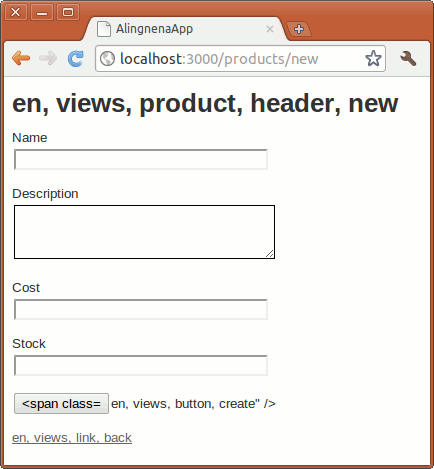
We’re missing translations for views.product.header.new, views.button.create, and views.link.back. Let’s add these to English translation file at config/locales/en.yml:
en:
hello: "Hello world"
views:
button:
create: "Create"
link:
back: "Back"
product:
header:
new: "New Product"
The translation should now work:
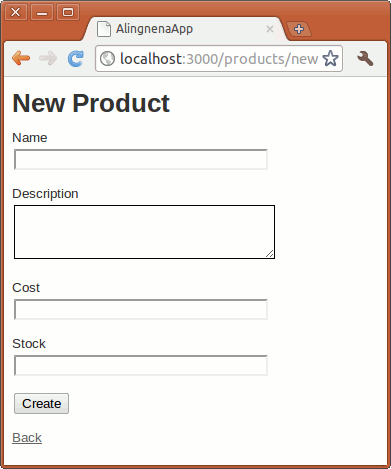
Let’s try translating the page to Tagalog. Create a new translation file config/locales/tl.yml:
tl:
views:
button:
create: "Likhain"
link:
back: "Bumalik"
product:
header:
new: "Bagong Produkto"
Restart the server then go to http://localhost:3000/products/new?locale=tl:
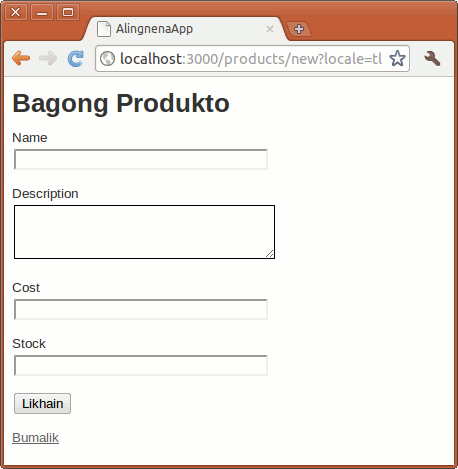
We’re still missing the translations for the fields (let’s ignore the title bar). To translate them, we’re going to need to add entries for Active Record:
tl:
views:
button:
create: "Likhain"
link:
back: "Bumalik"
product:
header:
new: "Bagong Produkto"
activerecord:
models:
product: "Produkto"
attributes:
product:
name: "Pangalan"
description: "Paglalarawan"
cost: "Presyo"
stock: "Dami"
The activerecord entry allows us to set the name of the model as well as its attributes/fields.
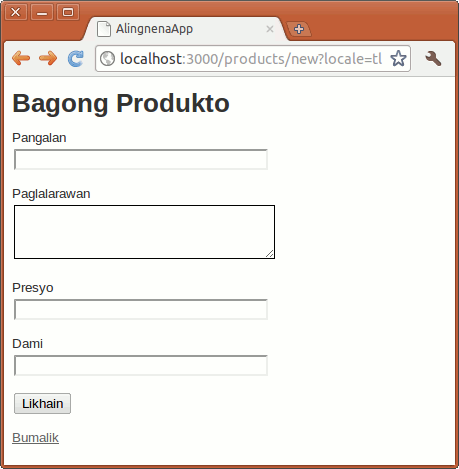
It looks ok, but if you store the locale into the session in our filter like so:
def set_locale
I18n.locale = params[:locale] || session[:locale]
session[:locale] = params[:locale] if params.has_key? :locale
end
and save a blank product, you’ll see that we’re missing translations for our errors.
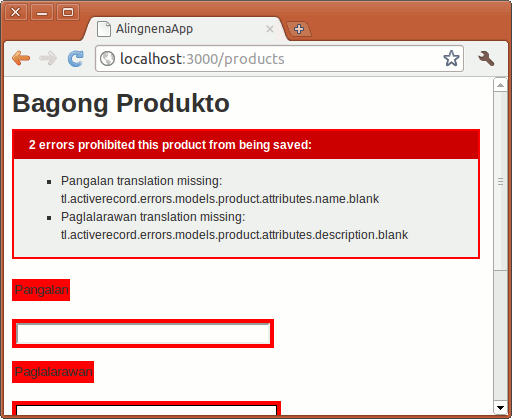
First off, we need to internationalize our error header. This can be done by modifying the line in app/views/products/_form.html.erb to:
<% if product.errors.any? %> <div id="error_explanation">
<h2><%= t "activerecord.errors.template.header", :count => product.errors.count,
:model => product.class.model_name.human.downcase %>:</h2>
<ul>
And we need to add the following line to config/locales/en.yml:
en:
...
activerecord:
errors:
template:
header:
one: "1 error prohibited this %{model} from being saved"
other: "%{count} errors prohibited this %{model} from being saved"
Here we see two i18n features: pluralization and interpolation.
The pluralization part only requires you to define two translations: one to format the singular message, another to format the plural message. You then pass the :count option to determine if the message is plural or not.
The interpolation feature allows you to interpolate variables inside the messages. You pass these variables as options to t() (:count included) and the method inserts them to sections defined by “%{}”.
Now we are done discussing the header, lets move on to the field errors. Fortunately, they have namespaces to allow you to define the error messages in generic or specific ways.
For example, validates_presence_of uses the :blank error message. You can define this error message under:
activerecord.errors.models.[model_name].attributes.[attribute_name].blank
activerecord.errors.models.[model_name].blank
activerecord.errors.messages.blank
That is, Rails will first check if the error message is defined for the specific attribute, then it would check the model, then it would check if a generic message was defined.
Rails i18n provides three values which you can interpolate with your messages, model (the model name), attribute (the field name), and count. For example, our blank message in Tagalog would be:
blank: "Dapat ipuno ang %{attribute}"
The count value is only available for some messages. Here is a list of the default error messages in Rails:
| validation | with option | message | default message |
|---|---|---|---|
validates_confirmation_of |
:confirmation |
doesn’t match confirmation | |
validates_acceptance_of |
:accepted |
must be accepted | |
validates_presence_of |
:blank |
can’t be blank | |
validates_length_of |
:within, :in
|
:too_short |
is too short (minimum is %{count} characters) |
validates_length_of |
:within, :in
|
:too_long |
is too long (maximum is %{count} characters) |
validates_length_of |
:is |
:wrong_length |
is the wrong length (should be %{count} characters) |
validates_length_of |
:minimum |
:too_short |
is too short (minimum is %{count} characters) |
validates_length_of |
:maximum |
:too_long |
is too long (maximum is %{count} characters) |
validates_uniqueness_of |
:taken |
has already been taken | |
validates_format_of |
:invalid |
is invalid | |
validates_inclusion_of |
:inclusion |
is not included in the list | |
validates_exclusion_of |
:exclusion |
is reserved | |
validates_associated |
:invalid |
is invalid | |
validates_numericality_of |
:not_a_number |
:not_a_number |
is not a number |
validates_numericality_of |
:greater_than |
:greater_than |
must be greater than %{count} |
validates_numericality_of |
:greater_than_or_equal_to |
:greater_than_or_equal_to |
must be greater than or equal to %{count} |
validates_numericality_of |
:equal_to |
:equal_to |
must be equal to %{count} |
validates_numericality_of |
:less_than |
:less_than |
must be less than %{count} |
validates_numericality_of |
:less_than_or_equal_to |
:less_than_or_equal_to |
must be less than or equal to %{count} |
validates_numericality_of |
:odd |
:odd |
must be odd |
validates_numericality_of |
:even |
:even |
must be even |
Our updated tl.yml file would be:
...
stock: "Dami"
errors:
template:
header:
one: "May isang mali na humahadlang sa pag-save ng %{model}"
other: "May %{count} mali na humahadlang sa pag-save ng %{model}"
messages:
blank: "Dapat ipuno ang %{attribute}"
There’s still one problem with our error message:

By default, the full error message is in the form “%{attribute} %{message}”. We can change that format by through the en.errors.format entry:
tl:
...
errors:
format: "%{message}"
Now our final message would be:

To demonstrate the time localization, let’s modify Show Product to add thecreated_at field along with the other i18n changes:
<h1><%=t "views.product.header.show" %></h1>
<p>
<b><%= label(:product, :name) %>:</b>
<%= @product.name %></p>
<p>
<b><%= label(:product, :description) %>:</b>
<%= @product.description %></p>
<p>
<b><%= label(:product, :cost) %>:</b>
<%= number_to_currency @product.cost, :unit => "PhP" %></p>
<p>
<b><%= label(:product, :stock) %>:</b>
<%= @product.stock %></p>
<p>
<b><%= label(:product, :created_at) %>:</b>
<%=l @product.created_at %></p>
Going to http://localhost:3000/products/3?locale=en will give us (assuming 3 is the id of the Cola entry):

But trying http://localhost:3000/products/3?locale=tl will give us an error:
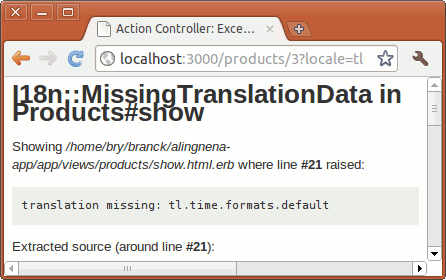
This is becausel looks for time.formats.default for the default time and datetime format (it looks for date.formats.default for date). Let’s add the necessary changes to our translation file as well (as some other entries we might need in the future):
tl:
date:
formats:
default: "%Y-%m-%d"
short: "%b %d"
long: "ika-%d ng %B, %Y"
day_names: [Linggo, Lunes, Martes, Miyerkules, Huwebes, Biyernes, Sabado]
abbr_day_names: [Lin, Lun, Mar, Mye, Huw, Bye, Sab]
# Don't forget the nil at the beginning; there's no such thing as a 0th month
month_names: [~, Enero, Pebrero, Marso, Abril, Mayo, Hunyo, Hulyo, Agosto, Setyembre,
Oktubre, Nobyembre, Disyembre]
abbr_month_names: [~, Ene, Peb, Mar, Abr, May, Hun, Hul, Ago, Set, Okt, Nob, Dis]
time:
formats:
default: "ika-%d ng %B, %Y %I:%M:%S %p"
short: "%d %b %H:%M"
long: "ika-%d ng %B, %Y %I:%M %p"
am: "AM"
pm: "PM"
views:
button:
create: "Likhain"
link:
back: "Bumalik"
product:
header:
new: "Bagong Produkto"
show: "Detalye ng Produkto"
activerecord:
models:
product: "Product"
attributes:
product:
name: "Pangalan"
description: "Paglalarawan"
cost: "Presyo"
stock: "Dami"
created_at: "Ginawa noong"
...
The date and time formatting options can be found in the API docs under Time.strftime(). Applying the changes above produces:
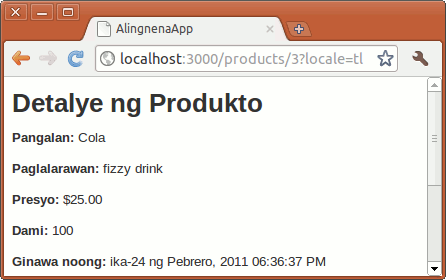
(We removed the :unit => "PhP" in preparation for the next section )
The other date and time formats can be specified in the l call. For example, if we change the created_at l call to:
<%=l @product.created_at, :format => :short %>We get:
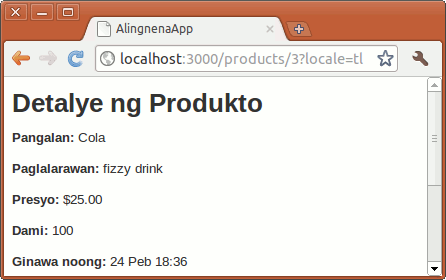
Localization is not limited to time. Currency and numbers are also affected when you use the helper functions number_to_currency, number_with_delimiter, number_to_percentage, number_to_precision, and number_to_human_size. Note that the text in Cost no longer has a currency symbol and the scale is reduced to 1. Let’s fix that by adding the following entries:
tl:
number:
format:
# Sets the separator between the units, for more precision (e.g. 1.0 / 2.0 == 0.5)
separator: "."
# Delimits thousands (e.g. 1,000,000 is a million) (always in groups of three)
delimiter: ","
# Number of decimals, behind the separator (1 with a precision of 2 gives: 1.00)
precision: 3
currency:
format:
# Where is the currency sign? %u is the currency unit, %n the number (default...
format: "%u%n"
unit: "PhP"
# These three are to override number.format above and are optional
separator: "."
delimiter: ","
precision: 2
date:
...
Opening the page again gives us:
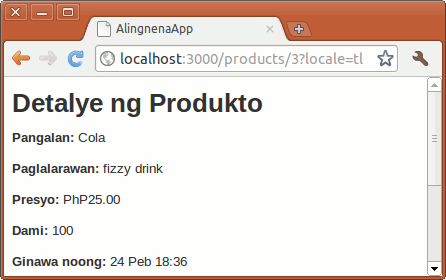
Deployment Options
We’ve already discussed the different environments available in Rails so running the server in the production environment should be easy. All we need is to change the port number to the default HTTP port (80) and we should be all set:
$ rake db:migrate RAILS_ENV=production
$ rails server -e production -p 80
However, there’s one big problem to this approach: Ruby, and by extension Rails and WEBrick, is practically single-theaded.
Try this experiment: modify the index action of Debt to make it sleep for 30 seconds, simulating an I/O or processing intensive task.
def index
@debts = Debt.all
sleep 30
respond_to do |format|
format.html # index.html.erb
format.xml { render :xml => @debts }
end
end
Then open http://localhost:3000/debts. As expected, the page takes 30 seconds to open.
But try opening http://localhost:3000/products in another window while waiting for that page to load. You’ll see that the process is blocked.
For years, the “industry-level” solution was to maintain a cluster of Mongrel servers (a faster alternative to WEBrick) and proxy the requests via a proxy server like Apache or lighttpd.

Scaling is easy with this setup; just add additional servers and you’re done.
Setup and maintenance, however, was not so easy. You have to configure each of the servers along with the proxy server. You also have to setup mechanisms to handle the rare event that some of the servers crash. It was as if all the ease of development in Rails was offset by the difficulty of setting up the production server.
Then came Phusion Passenger.
Phusion Passenger is a module for the industry standard Apache web server and the fast and lightweight Nginx web server. It handles the Rails process spawning as well as the proxying to these Rails processes.
Basically what that means is that if you’ve got Passenger installed and configured inside your Apache or Nginx server, deploying your application is as simple as deploying PHP applications i.e. just upload the files to the server and you’re done. No need to worry about clustering or the problems that come with it.
Installing and setting up Phusion Passenger is not included in this course. You can, however, refer to the documentation on the website for more details.
Rake
Out last lesson will be a short overview on Rake, the build tool written in Ruby and used extensively by Rails and its plugins.
At the heart of Rake are the rakefiles, files where you specify the processing tasks in Ruby syntax. The simplest way of declaring a task is using the task method. Create a rakefile named rakefile in an empty directory (so as not to overwrite your Rails apps) and put the following code there:
task :first_task do
puts "this is the first task"
end
Running the command “rake first_task” on the same folder will print out “this is the first task”.
Like other build tools like ant, these tasks can be declared as dependent on each other so that executing one task will call the other required tasks. You can declare dependencies by converting the string parameter to the task method to a hash:
task :first_task do
puts "this is the first task"
end
task :second_task => :first_task do
puts "this is the second task"
end
Running rake second_task here will produce:
$ rake second_task
(in /home/user)
this is the first task
this is the second task
You can also use an array as the value of the hash to declare multiple dependencies:
task :first_task do
puts "this is the first task"
end
task :second_task do
puts "this is the second task"
end
task :third_task => [:first_task, :second_task] do
puts "this is the third task"
end
Running rake third_task will now print the three tasks. Note that when a dependency is already satisfied, it is no longer processed the next time another task requires it. For example:
task :first_task do
puts "this is the first task"
end
task :second_task => :first_task do
puts "this is the second task"
end
task :third_task => [:first_task, :second_task] do
puts "this is the third task"
end
Running rake third_task here would produce the same results instead of printing “this is the first task” twice.
By the way, “task :third_task => [:first_task, :second_task] do” is essentially shorthand for:
task :third_task
task :third_task => [:first_task]
task :third_task => [:second_task] do
task :third_task do
end
That is, you can add dependencies (and even processing logic) to a task even after the task is initially declared through anothertask call.
Another type of task is thefile task. Instead of simply checking the dependencies, these tasks also check the existence and the timestamps of the specified files. For example, here’s the sample code from the Rake documentation for compiling 3 C files:
file 'main.o' => ["main.c", "greet.h"] do
sh "cc -c -o main.o main.c"
end
file 'greet.o' => ['greet.c'] do
sh "cc -c -o greet.o greet.c"
end
file "hello" => ["main.o", "greet.o"] do
sh "cc -o hello main.o greet.o"
end
On the first run of rake hello, it will first compile main.o, then greet.o, then finally the hello executable. All three files were created because they did not yet exist; going through the dependencies eventually created them.
Now if you modify the main.c and run rake hello again, rake will go through the dependencies again, checking each for changes in the timestamp. Since main.c was changed, the file task main.o was re-run and the file recompiled. When Rake goes back to the hello file task, the main.o file changed its timestamp so the task is similarly re-executed. Note that since neither greet.c nor greet.o was changed since the last rake execution, the greet.o task was not executed again.
You can describe tasks using the desc method on top of the task:
desc "prints out the first line"
task :first_task do
puts "this is the first task"
end
desc "prints out the first two lines"
task :second_task do
puts "this is the second task"
end
desc "prints out the three lines"
task :third_task => [:first_task, :second_task] do
puts "this is the third task"
end
Running “rake -T” will list out the tasks with a proper desc description.
$ rake -T
(in /home/user)
rake first_task # prints out the first line
rake second_task # prints out the first two lines
rake third_task # prints out the three lines
Since desc is the standard way of documenting tasks, you can use this command to list the rake tasks for Rails:
$ rake -T
(in /home/user/alingnena-app)
rake db:abort_if_pending_migrations # Raises an error if there are pending migra...
rake db:charset # Retrieves the charset for the current envi...
rake db:collation # Retrieves the collation for the current en...
rake db:create # Create the database defined in config/data...
rake db:create:all # Create all the local databases defined in …
rake db:drop # Drops the database for the current RAILS_ENV
rake db:drop:all # Drops all the local databases defined in c...
rake db:fixtures:identify # Search for a fixture given a LABEL or ID.
rake db:fixtures:load # Load fixtures into the current environment...
rake db:migrate # Migrate the database through scripts in db...
...
The default task for Rake is the “default” task. Usually you just point it to another task or tasks to define which tasks should be run ifrake is executed without arguments.
task :default => :third_task
Other tasks and tips on using Rake are found at the online documentation.

